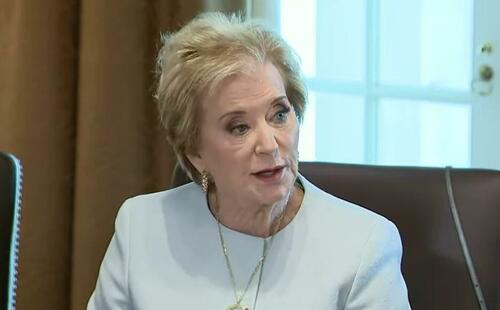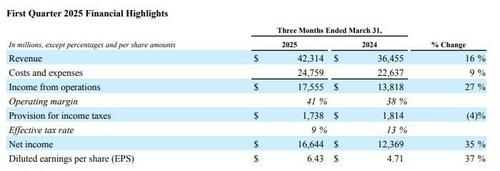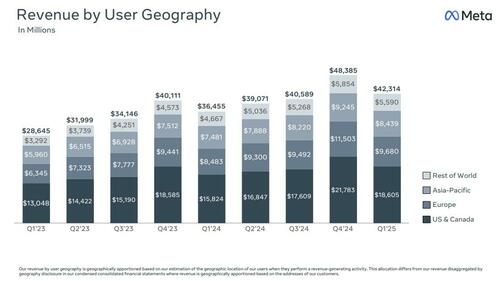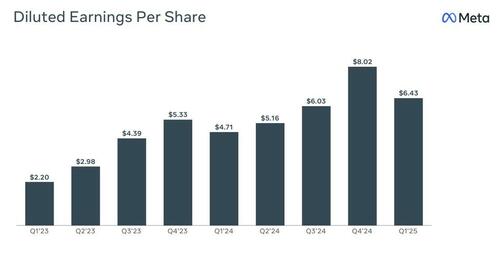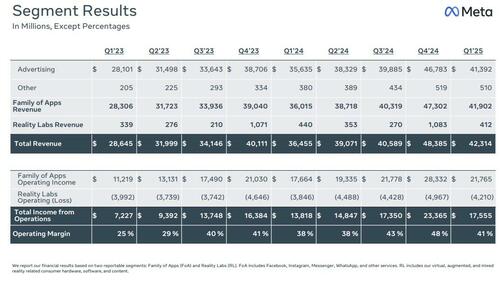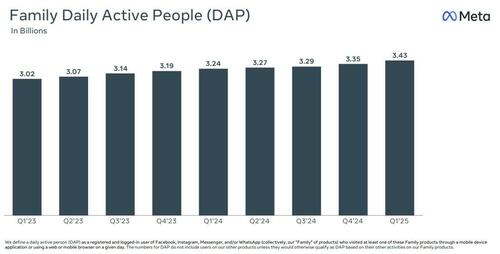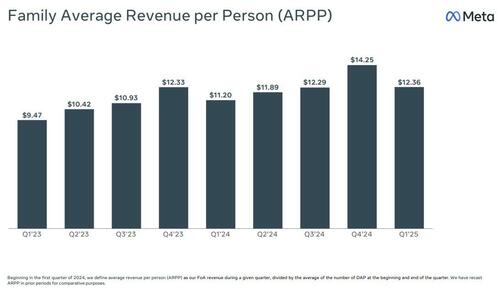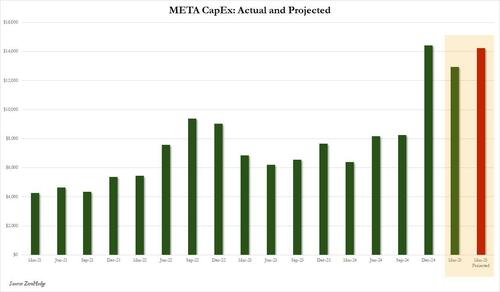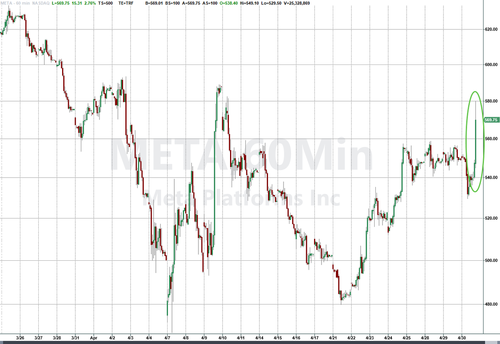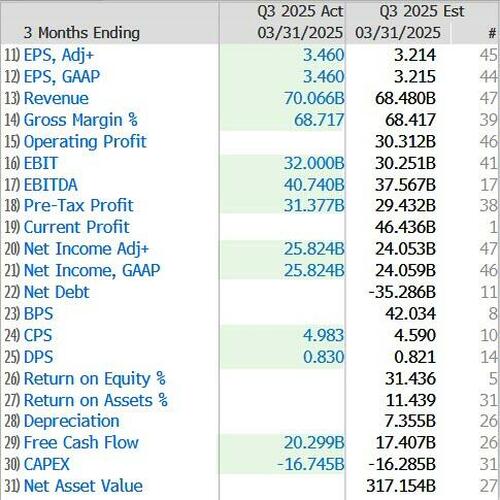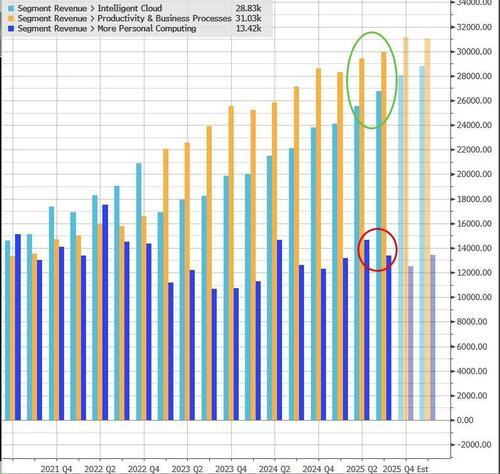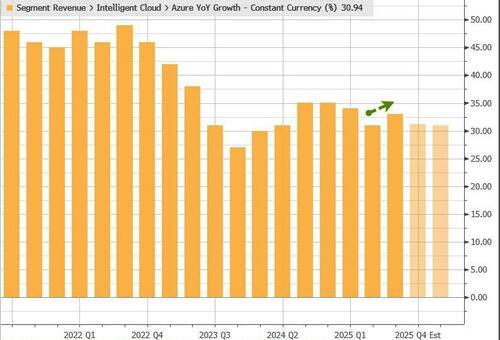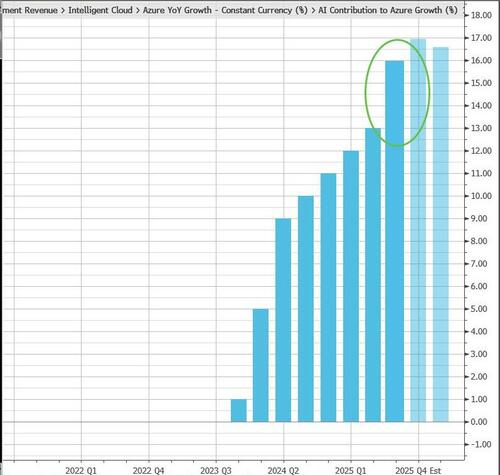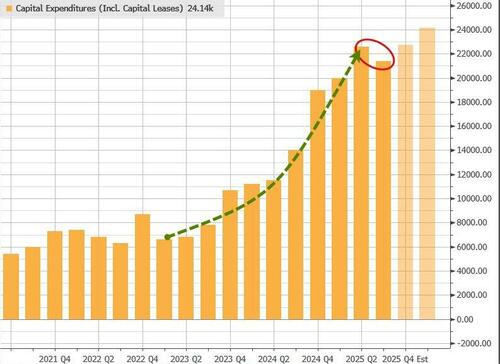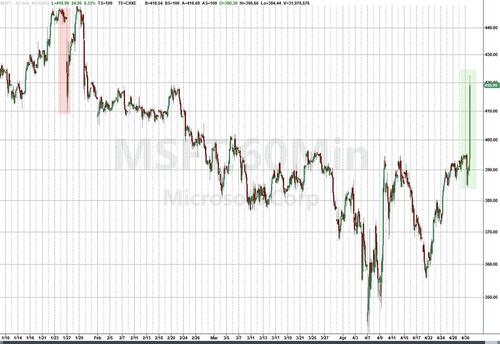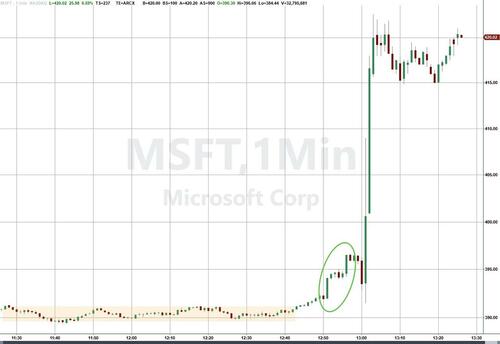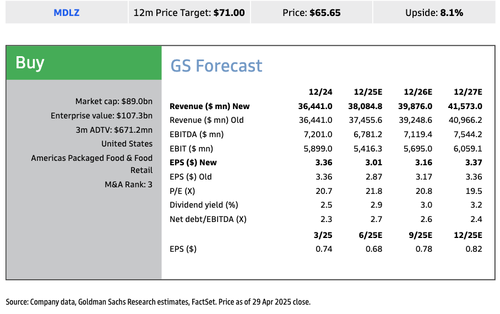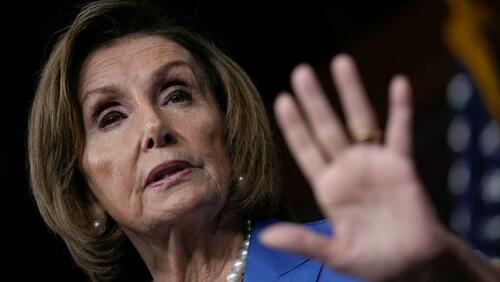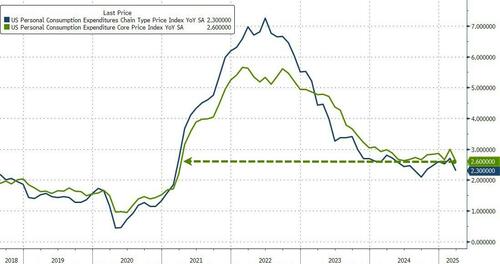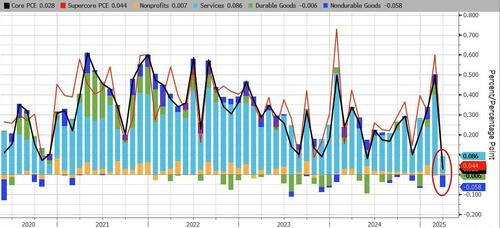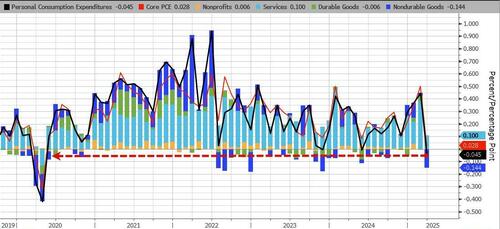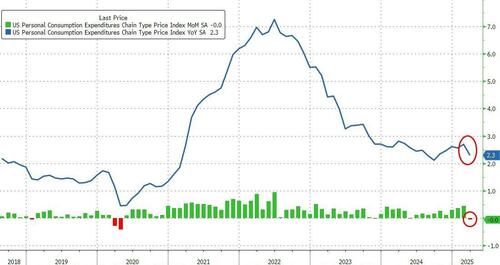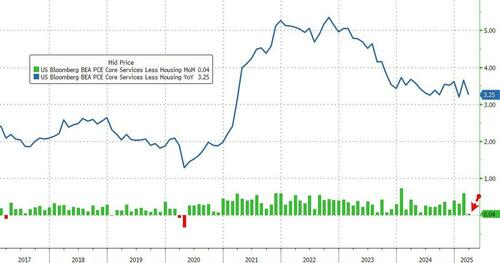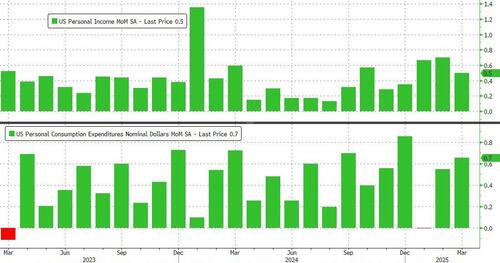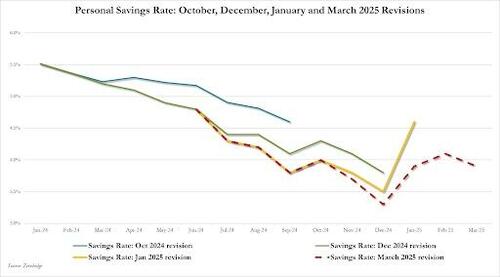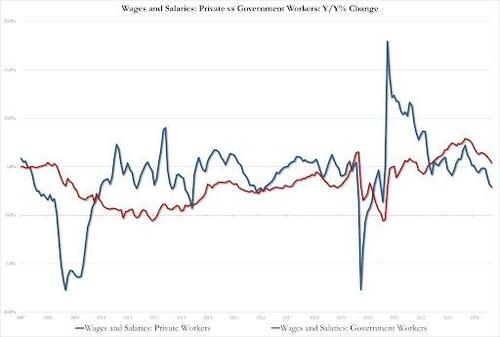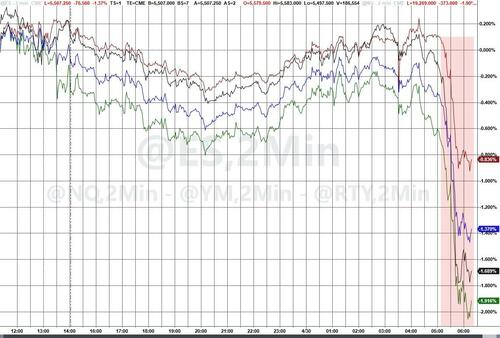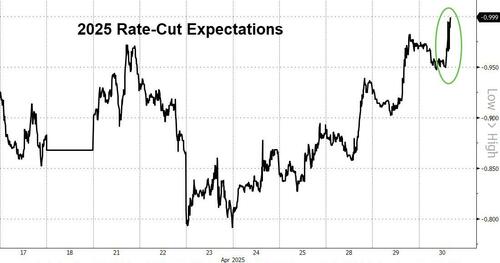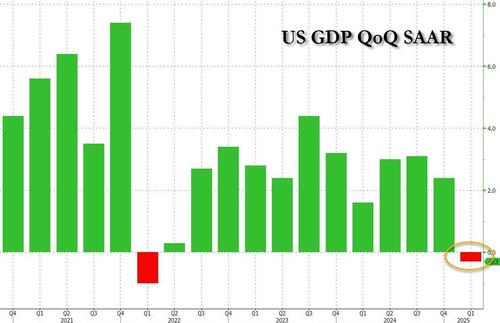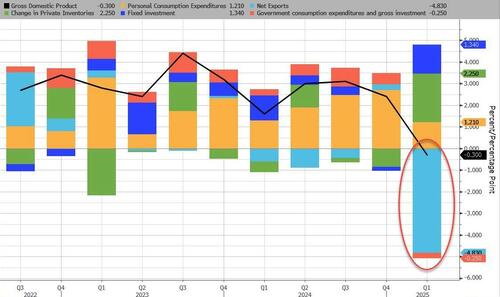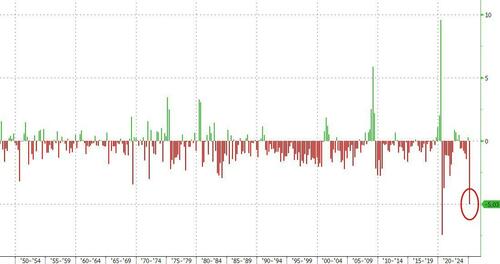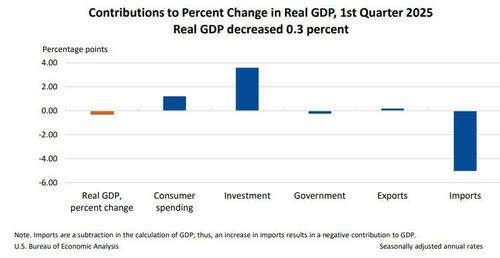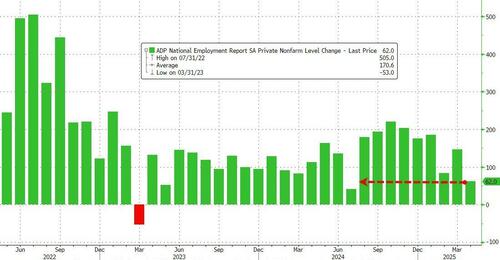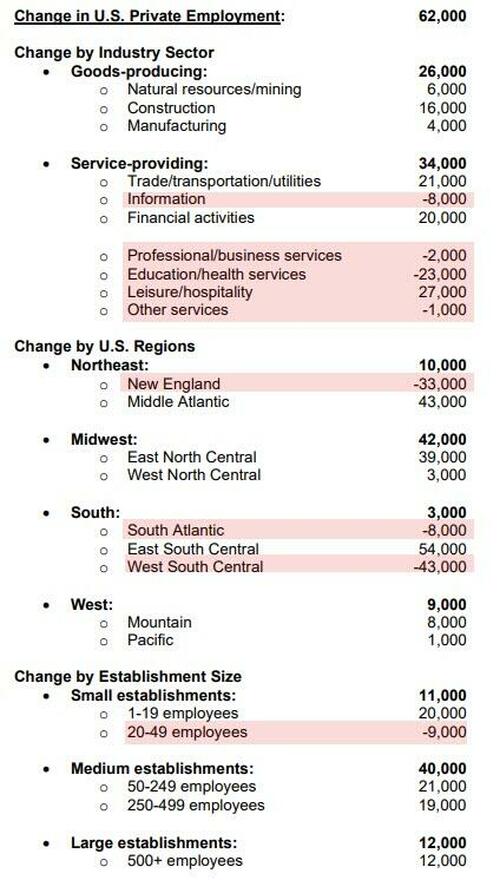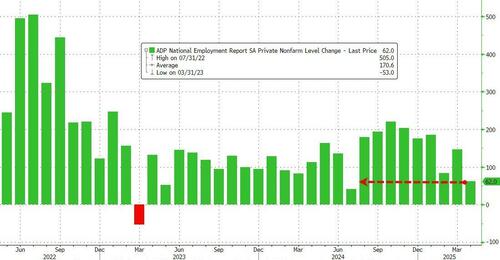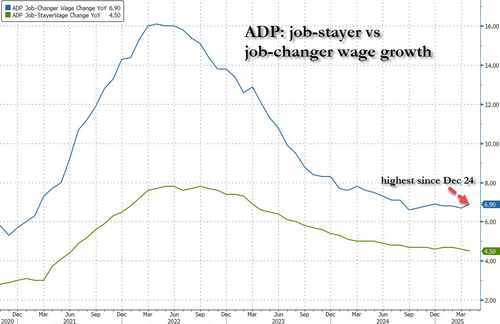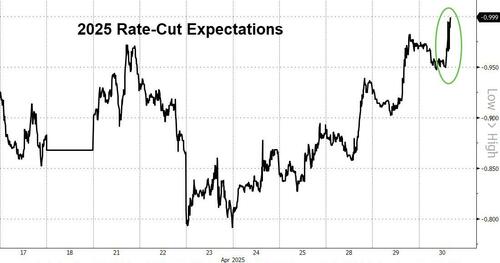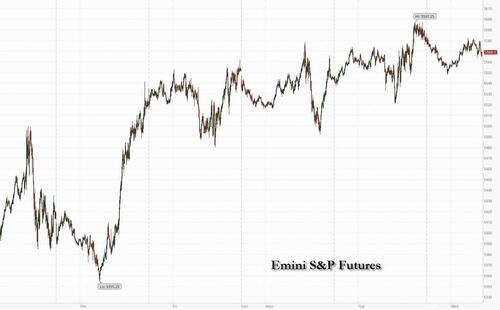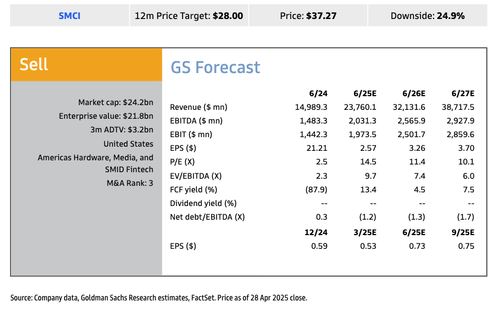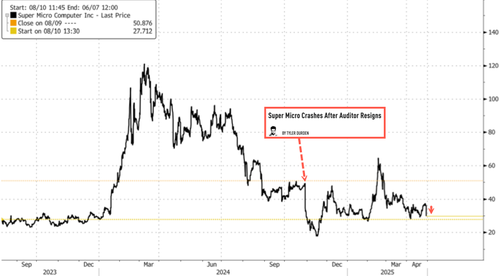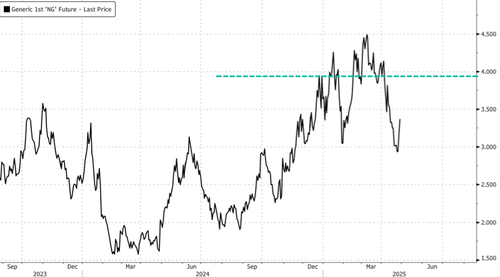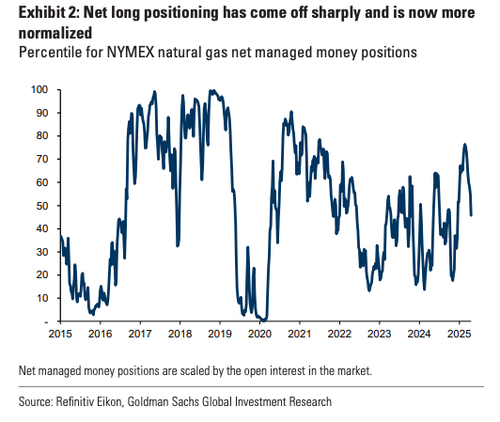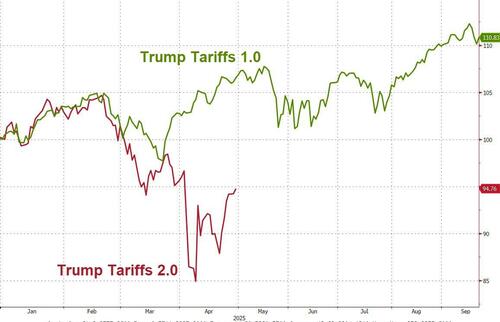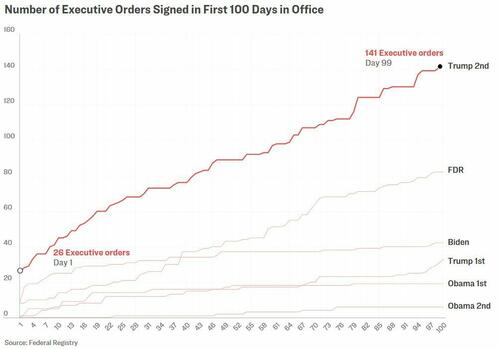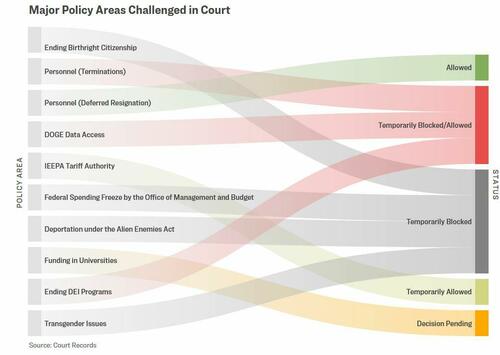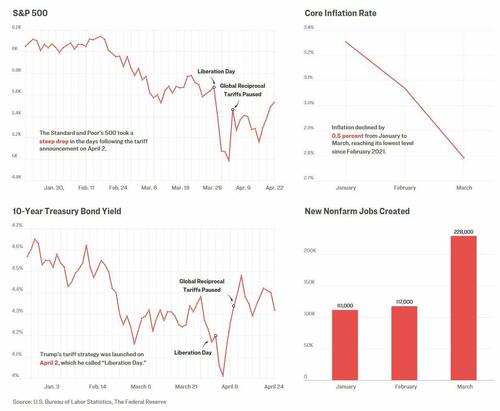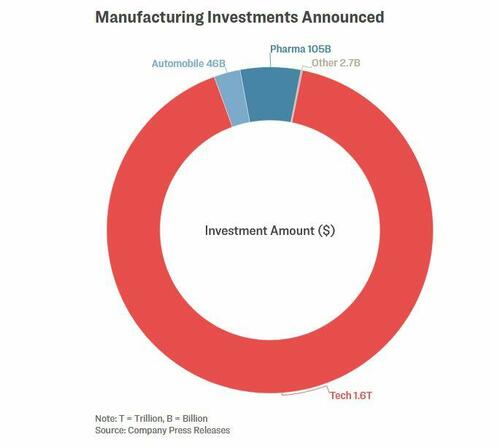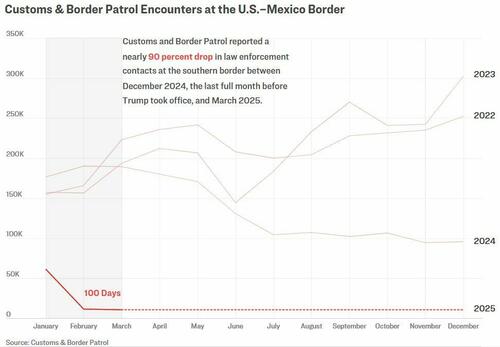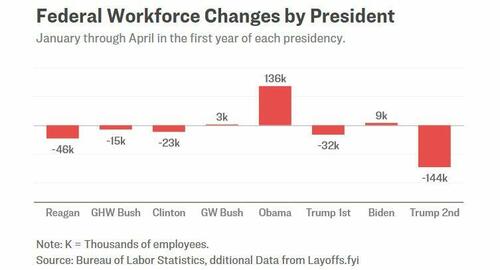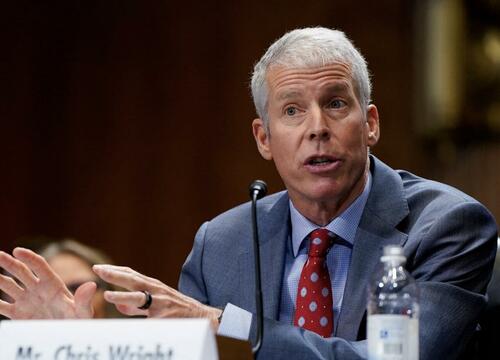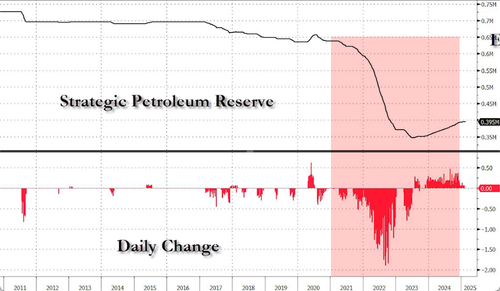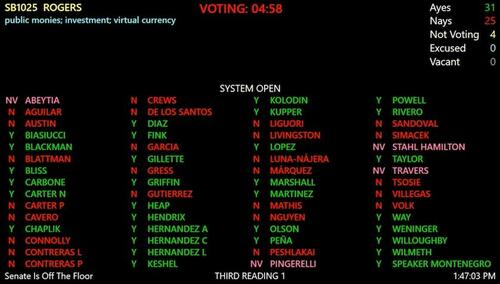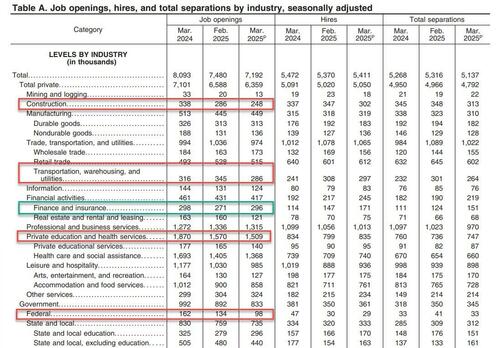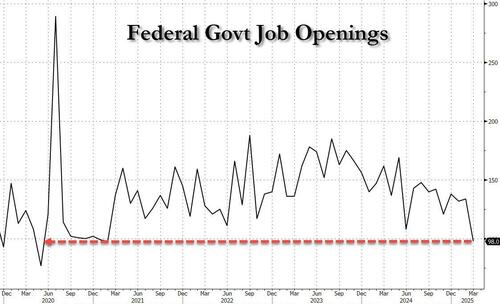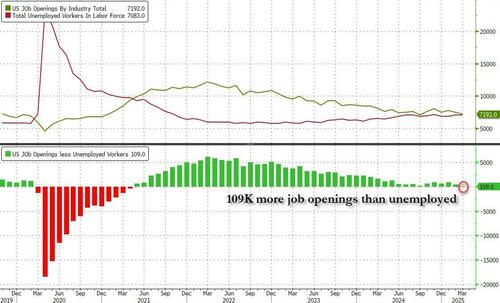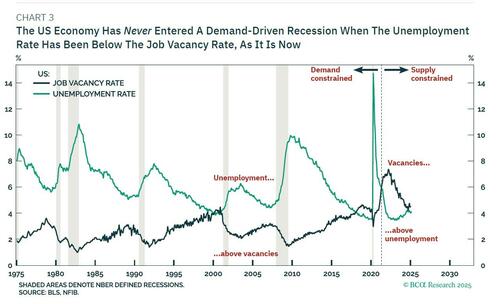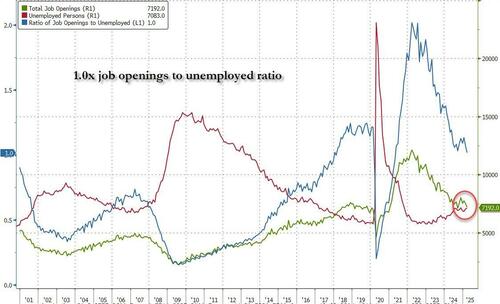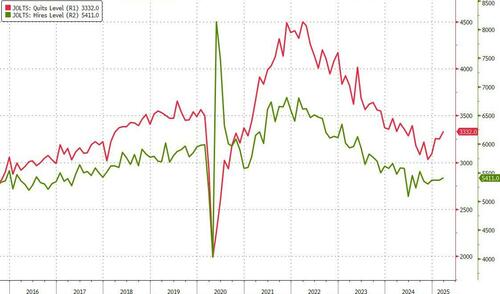Assuredly, the word of truth can be painful and uncomfortable. But it is the way to holiness, to peace, and to inner freedom. A pastoral approach which truly wants to help the people concerned must always be grounded in the truth. In the end, only the truth can be pastoral.
Distinction Matter - Subscribed Feeds
-
Site: Zero HedgeEPA Chief Lee Zeldin Touts 100 'Environmental Actions' Taken To 'Power The American Comeback'Tyler Durden Wed, 04/30/2025 - 20:30
Environmental Protection Agency (EPA) administrator Lee Zeldin unveiled 100 actions the agency has undertaken since Trump's inauguration to "power the American comeback."
"The Trump Administration’s first one hundred days have been historic. The American public made themselves heard last November, and we are delivering on this mandate. Promises made, promises kept. At EPA, we are doing our part to Power the Great American Comeback. To mark this momentous day, we are proudly highlighting 100 environmental actions we have taken since January 20th to protect human health and the environment," Zeldin said in a video post reported by Breitbart.
To mark the 100th day of President Trump’s second term, @EPA is proudly highlighting 100 environmental actions we have taken since January 20th to protect human health and the environment.
— Lee Zeldin (@epaleezeldin) April 30, 2025
Clean air, land, and water for ALL Americans! pic.twitter.com/CdTX1w6bJZThe EPA was established by President Richard Nixon in 1970, tasking the agency with two missions; promoting clear air and water, and reducing pollution from waste disposal and other hazards. According to Zeldin, the agency has refocused on its primary mission of ensuring clean air and water instead of pushing "climate change religion."
"Here are a few top highlights: To protect our nation’s waters, we updated water quality standards for 38 miles of the Delaware River to protect critical fish species and keep the river clean. We approved a plan to further restore and protect the Long Island Sound over the next decade. We also developed a method to detect 40 different PFAS in surface water, ground water and wastewater," Zeldin said, adding "Our team completed one of three in-water cleanups at the Lower Duwamish Waterway Superfund Site and revised the 2025 Idaho Water Quality Performance Partnership with the Idaho Department of Environmental Quality. To ensure clean air for all Americans, we demanded answers from an unregulated geoengineering start-up, Make Sunsets, that has been launching sulfur dioxide into the air to receive ‘cooling credits.'"
According to Taylor Rogers, an assistant White House press secretary, the Trump administration and Zeldin have "taken monumental steps to quickly remove toxins from our water and environment, provide clean land for Americans, and use common-sense policies to Power the Great American Comeback."
Here are the 100 actions the EPA has undertaken via Breitbart;
1. Issued immediate action items for Mexico to permanently end the Tijuana River sewage crisis.
2. Responded quickly to a citizen complaint about discharges into New York’s Hutchinson River; inspected and ordered corrective action.
3. Developed a Clean Water Act permit for hotels, condominiums, and apartment complexes to protect water quality in the U.S. Virgin Islands.
4. Finalized Arkansas 2022 Section 303(d) list assessing statewide water quality.
5. Approved Kansas Triennial Water Quality Standards Package.
6. Approved Total Maximum Daily Load (TMDL) plan in South Dakota to protect Big Sioux River quality from E. coli.
7. Announced plans to finalize outdated clean water standards for 38 miles of the Delaware River.
8. Approved removal of the Drinking Water Beneficial Use Impairment in Wisconsin’s Green Bay and Fox River Area of Concern.
9. Advanced Navajo Nation’s first in the country water permitting (“Treatment as a State”) authority.
10. Completed Phase 1 hazardous materials clean up after the catastrophic Los Angeles wildfires. EPA cleared 13,612 residential properties and 305 commercial properties, and removed 645 electric and hybrid vehicles and 420 energy storage systems in under 30 days.
11. Supported redevelopment at 21 Superfund sites across 13 states.
12. Completed a contaminated site cleanup in Hillsborough, New Hampshire, and Stratford, Connecticut.
13. Oversaw U.S. Navy’s time-critical removal of 20,000 cubic yards of contaminated soil at the Naval Education Training Center Superfund Site in Newport, Rhode Island.
14. Cleared all or a portion of 4 sites from the Superfund National Priorities List.
15. Cut two years from the cleanup timeline at West Lake Landfill, a Superfund site in St. Louis, Missouri.
16. Completed 55 property cleanups at Region 8 Brownfields. This is 31% of the national goal and 131% of Region 8’s Fiscal Year 2025 goal.
17. Completed laboratory work required for selecting a remedy at Lower Darby Creek Area Superfund Site in Pennsylvania. EPA collected 1500 sediment and water samples.
18. Responded to a mercury incident in Fremont, Ohio; safely removed and disposed of a 60-pound overpack and 15-pound bucket containing jars of elemental mercury and mercury containing devices.
19. Provided air monitoring support at the Chicago Magnesium Casting Co. after a large magnesium fire.
20. Completed Emergency Removal Action at the Marion Ohio Mercury Spill site in Ohio.
21. Oversaw Navy cleanup operations at Red Hill Fuel Facility in Hawaii, including removal of all sludge and pressure washing at two 12.5 million-gallon tanks.
22. Developed a method to detect 40 PFAS compounds in water sources.
23. Finalized eight Water Quality Standard Actions for Region 6 states.
24. Completed a second round of PFAS sampling at Region 7 Tribal Drinking Water Systems.
25. Provided interim PFAS lab certification for Alaska’s Department of Environmental Conservation (ADEC).
26. Signed an agreement to connect Joint Base Lewis-McChord residences to municipal water system if PFAS exceeds standards.
27. Started Final Remedial Actions for Jackson Ceramix Superfund in Falls Creek Borough, Pennsylvania, with construction to begin in the Spring of 2025.
28. Provided training to help New Mexico administer the National Pollutant Discharge Elimination System, a permit program established by EPA under the Clean Water Act to regulate water pollution by controlling point sources that discharge pollutants into U.S. waters.
29. Coordinated PFAS drinking water well sampling around Fort Bragg, North Carolina.
30. Utilized EPA lab Method 522 to test tribal drinking water systems for PFAS; performed 62 analyses.
31. Completed lead testing assistance (3T’s Protocol) for Puerto Rico schools and childcare facilities.
32. Reviewed 29 public water systems that had lead action level exceedance notifications in Region 4.
33. Completed 25 State Implementation Plans allowing environmental requirements to go into effect faster, 16 of which were backlogged from the previous Administration.
34. Finalized air quality rulemaking in the Washington D.C. Area ensuring ozone compliance.
35. Conducted ambient air monitoring technical system audits (TSAs) across Region 9.
36. Upgraded the RadNet monitoring station in Edison, New Jersey, to detect airborne radioactivity.
37. Awarded $165,000 to San Diego Air Pollution Control District for air filters and $1.26M for hydrogen sulfide monitoring to address air quality at the border and concerns with sulfur odors from Tijuana River sewage.
38. Promoted clean air quality compliance for new chip manufacturing projects in Phoenix, Arizona.
39. 27 Brownfields sites were made Ready for Anticipated Use, boosting property values and economic opportunities in Hartshorne, Oklahoma, Minden, Louisiana, West Memphis, Arkansas, and more.
40. Completed 107 assessments of Brownfield properties in Region 7, which is 82% of their Fiscal Year 2025 goal.
41. Achieved 21 contaminated Brownfield redevelopment successes in Region 9.
42. Held a Superfund Job Training at Missouri’s Ozark Correctional Center.
43. Completed review of 81 New Chemicals to ensure they are safe for human health and the environment.
44. Conducted a safety review of 14 pesticides to set tolerances to support a safe and reliable food supply.
45. Approved 48 pesticides to provide growers with necessary tools while ensuring appropriate restrictions were imposed to protect human health, the environment, and endangered species.
46. Proposed 35 significant new use rules (SNURs) for chemical oversight to ensure chemicals do not pose an unreasonable risk to human health or the environment.
47. Led a Federal Insecticide, Fungicide, and Rodenticide Act (FIFRA) Week-In-Residence Enforcement Training event for newly hired state inspectors to equip new inspectors with the knowledge necessary to uphold consistent inspection standards.
48. Blocked illegal pesticide imports totaling over 200,000 pounds across multiple regions.
49. Announced approval of Texas’s clean-air plan to address vehicle emissions and improve air quality in the San Antonio area.
50. Issued amended PCB risk-based disposal approvals to expedite repairs at public schools.
51. Led a Resource Conservation and Recovery Act (RCRA) State Authorization Conference to strengthen the hazardous waste program across all states.
52. Sent mobile drinking water lab to flood-impacted Eastern Kentucky.
53. Cleared more than 1,700 orphan containers of oil, propane, and other hazardous materials from land and waterways around the French Broad River after Hurricane Helene.
54. Tested over 1,500 private wells in North Carolina’s Buncombe and Watauga counties.
55. Assisted in restoring drinking water service to 150,000 people in North Carolina.
56. Concluded 297 enforcement cases reducing 15 million pounds of pollution.
57. Superfund enforcement secured $296 million worth of cleanups addressing more than 700,000 cubic yards of contamination.
58. Completed cleanup at Metals Refining Co. hazardous waste site in Indiana after discovering thirty-two, 55-gallon drums most of which were damaged and some leaking and an additional 200 to 300 miscellaneous containers of hazardous waste.
59. Removed approximately 10,000 tons of soil and debris contaminated with asbestos containing material from an unsecured 10-acre property in Indiana.
60. Collaborated to replace lead-contaminated soil at Atlanta’s Lindsay Street Park.
61. Analyzed children’s blood lead data to improve South Dakota lead prevention efforts.
62. Supported tribal waste management programs with multiple trainings to address dangerous materials like refrigerants, mercury switches, PCBs, and petroleum components.
63. Conducted 6,000 1-on-1 engagements with communities impacted by fires.
64. Held 104 public meetings or community events for fire response updates.
65. Provided training, guidance, and support to monitor and cleanup Underground Storage Tanks on Navajo Nation lands.
66. Started cleanup of radium-contaminated soil at the Silbert Watch Co. Superfund Site in Elgin, Illinois.
67. Developed EPA Method TO-15 to analyze 65 toxic Volatile Organic Compounds in indoor and outdoor air in support of Superfund and Clean Air Act.
68. Supported Los Alamos National Lab in transporting hazardous tritium containers for cleanup.
69. Conducted lead contamination studies at the Bunker Hill Superfund site.
70. Completed the review of the Houston area Ozone Exceptional that allows the state to proceed with their Air Program planning and implementation.
71. Worked with U.S. Customs to stop illegal pesticide imports at multiple ports.
72. Blocked over 56,000 pounds of unregistered pesticide products from entering through Region 4 ports.
73. Provided technical assistance support to communities at 31 Superfund sites across the country.
74. Cleanup of the HPI Chemical Products in Missouri, where thousands of containers of pesticide and herbicide containing hazardous substances, pollutants, and contaminants were housed.
75. Began a Remedial Investigation of the Historic Potteries site in Trenton, New Jersey.
76. Completed 7 property cleanups in Brownfields in the First 100 Days in Region 7.
77. Approved updated Comprehensive Conservation & Management plan for the Long Island Sound Partnership, to further restore and protect the Sound.
78. Initiated sediment removal projects at the Lower Duwamish Waterway Superfund Site removing approximately 13,700 cubic yards of contaminated sediment.
79. Oversaw cleanups at tribal and local jurisdictions under CERCLA and Clean Water Act.
80. Supported redevelopment at the Mississippi Phosphate Superfund site with a new treatment plant.
81. Completed analysis for wood treating contaminants at 181 residential properties around the Union Pacific Railroad Superfund site in Houston, Texas, with seventy four percent found to be safe for use.
82. Managed post-disaster hazardous materials spills in Ohio and North Carolina.
83. Inspected and mitigated vapor intrusion impacting Los Angeles from a former Superfund site.
84. Obtained court settlement for cleanup work at the San Fernando Valley Superfund Site located in North Hollywood-Burbank to restore a critical drinking water supply for the city of Los Angeles.
85. Responded to hydraulic oil spill into a creek in Whitehouse, Ohio.
86. Supported voluntary cleanups under consent decrees.
87. Began a removal action in Dartmouth, Massachusetts, to excavate and dispose of contaminated soil at three residential properties as part of a larger ongoing cleanup effort.
88. Approved eight plans for cleanup and disposal of toxic Polychlorinated Biphenyl (PCB) materials to facilitate reuse and economic development across properties in New England.
89. Finalized Native Green Grow Air Permit for large greenhouse facility in North Dakota, providing the Tribe with food security.
90. Advanced Native American environmental oversight efforts.
91. Granted a Water Infrastructure Finance and Innovation Act (WIFIA) loan to Weber Basin Water Conservancy District, for drinking water infrastructure to over 20% of Utah’s population while creating local jobs to support the projects.
92. Supported grant programs to monitor and clean up abandoned USTs.
93. Provided federal funds to conduct Highway 24 lead and arsenic clean up in Colorado.
94. Helped prevent spread of hazardous materials from warehouse fires including sulfuric acid, nitric acid, hydrochloric acid, sodium hypochlorite, potassium cyanide, sodium cyanide, and lead.
95. Collaborated with fire rescue teams in North Carolina to retrieve containers from flooded rivers.
96. Provided technical guidance to local water operators, supporting efforts to restore and maintain drinking water systems and other essential services during Hurricane Helene Recovery efforts.
97. Completed all residential soil and indoor dust cleanup at the Colorado Smelter Superfund site.
98. Completed the 5-Year Review for Puerto Rico’s Corozal Superfund Site, paving the way for its deletion from the CERCLA Superfund National Priority List.
99. Submitted a demand for information to a start-up company called “Make Sunsets,” which is launching balloons filled with sulfur dioxide (SO2) seeking to geoengineer the planet and generate “cooling” credits to sell.
100. Announced major actions to combat PFAS contamination.
-
Site: Zero HedgeWorkless 'Lost Generation' Suffering Mental Health Issues: ReportTyler Durden Wed, 04/30/2025 - 20:05
Authored by Rachel Roberts via The Epoch Times (emphasis ours),
The British Chambers of Commerce (BCC) is warning of a workless “lost generation,” caused partly by the number of young people suffering from poor mental health.
 A man wearing a mask walks past a mural painted as part of the Cities of Hope festival in 2016 and highlighting the effects of mental health, in Ancoats, northern Manchester, England, on Oct. 16, 2020.Oli Scarff/AFP via Getty Images
A man wearing a mask walks past a mural painted as part of the Cities of Hope festival in 2016 and highlighting the effects of mental health, in Ancoats, northern Manchester, England, on Oct. 16, 2020.Oli Scarff/AFP via Getty Images
The body is calling for immediate government action which it says is needed to help young people from generation Z, generally defined as those born between 1997–2012, to enter the workplace or education.
Its report, “Creating Job Opportunities for Gen Z,” released on Monday, follows research published last week which found the number of young people claiming benefits owing to poor mental health or neurodiverse conditions such as autism and ADHD was not economically “sustainable.”
‘Double Whammy’
Shevaun Haviland, director general of the BCC, said: “The UK’s active workforce is rapidly ageing, while the number of young people who are not in employment, education or training is at its highest level for a decade.
“Generation Z face a double whammy of increasing barriers to entering the workforce, and reducing opportunities as the number of vacancies continues to fall.
“But research shows the longer we leave this pool of talent to drift away from the workplace the harder it becomes for them to engage.”
The BCC, which represents a large number of smaller businesses, is calling on the government to spend more on mental health support and further education and for a more “collaborative approach” across the various Whitehall departments.
‘Rise of Anxiety’
Last week’s report from the Tony Blair Institute (TBI) pointed to soaring numbers of people reporting poor mental health and claiming benefits since the COVID-19 lockdown era.
“One clear trend is the rise of anxiety particularly since the COVID-19 pandemic. Data from the Annual Population Survey show that prior to the pandemic, self-reported levels of anxiety in the population were relatively stable. Since 2019, however, the number of people reporting high levels of anxiety has surged and remained high, with 23 per cent of working-age adults reporting ‘poor anxiety’ in 2023,” authors for the former prime minister’s organisation wrote.
Mental health conditions are now the most commonly reason cited by people across all age groups who are out of work owing to long-term sickness, the report by the TBI notes.
“The reasons behind this shift remain unclear. It may reflect a rise in true prevalence, but other factors could also be at play – such as distorted financial incentives within the system, overdiagnosis or changing public attitudes and awareness around mental health.
“Whatever the cause, one thing is clear: the current trajectory is unsustainable,” the authors concluded.
The study highlights a 168 percent reported increase in depression, anxiety, and stress among those aged 16–24 in the two decades ending in 2019, with a 42 percent rise seen across all age groups.
It also notes a doubling in the prescribing of ADHD medication since 2018–2019, with the younger age group the main driver behind this increase.
Surging Benefits Bill
Claims for mental health conditions have fuelled a nationwide surge in benefits payments since the lockdown era, with an estimated 25 percent in income tax predicted to be used to fund sickness benefits by the end of this decade, unless the trajectory changes.
An estimated 13.4 percent of all young people aged 16 to 24 were classed as NEET (“not in education, employment, or training”) in October to December 2024, an increase of 1.3 percent compared with October to December 2023, according to the latest release from the Office for National Statistics.
The precise figures are not reliable, because they are based on the statistics agency’s labour market survey, which is hampered by low response rates, especially for younger age groups.
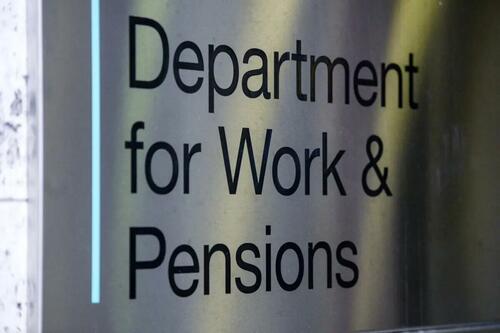 Signage for the Department of Work and Pensions in Westminster, London, in an undated file photo. PA
Signage for the Department of Work and Pensions in Westminster, London, in an undated file photo. PA
Research by The King’s Trust, carried out in 2022, shows that one in four classed as NEETs said they would like to work but cannot, owing to their poor mental health, with “lack of confidence” also cited as a major barrier to entering the workforce by 23 percent of young people.
Almost half (46 percent) of those surveyed told The King’s Trust researchers they have additional mental health issues or caring responsibilities owing to the lockdown era which meant they were out of work.
More than half (52 percent), said the longer they were unemployed, the harder they were finding it to get work, while 45 percent said being out of work meant they had lost confidence in their skills.
Youth Guarantee Scheme
Last month, the government announced a series of welfare reforms, including sweeping cuts to disability benefits and an expansion of so-called “back-to-work support,” which it said will help young people diagnosed with mental health problems to enter the workforce.
The Department for Work and Pensions (DWP) announced a Youth Guarantee Scheme in November, aimed at giving all 18- to 21-year-olds access to training, an apprenticeship, or support to find work, as part of a broader strategy aimed at tackling worklessness and ill health in the wider population.
Releasing its white paper, the DWP said: “Stark figures show almost one and a half million people are unemployed, over nine million people are inactive [and] a record 2.8 million people are out of work due to long-term sickness.
“Young people have also been left behind with one in eight young people not in education, employment or training, and nine million adults lack the essential skills they need to get on in work.”
The government proposes to set up eight youth “trailblazer” areas across the country, allocating £45 million to identify those “most at risk of falling out of education or employment and match them to opportunities for education, training or work,” with a further £40 million allocated to transform the Apprenticeship system.
However, the BCC said in its report that there was a lack of clarity as to how the youth guarantee scheme will work in practice, and whether there will be sufficient funding to last the entire course of the next Parliament.
“Details of how this will be delivered, and the role of employers, are still unclear. While employers want to support the initiative, the rising cost of employment and the squeeze on training budgets could restrict their ability to participate.”
The BCC noted that there is a “lack of incentive” for small- and medium-sized businesses to take on young people, particularly those classed as NEET, because of the financial risk.
“Employers report that young people are more resource-intensive to train and employ, due to their increased need for pastoral care, and their higher staff turnover. Combined with the likelihood that NEETs may have additional needs such as Special Educational Needs (SEN) or mental health challenges, resource-stretched SMEs may feel unable to offer the support needed,” the authors said, adding that the role of government should be to “derisk” this for businesses that take on and retain these young people.
-
Site: Zero HedgeCalifornia Child Sex Trafficking Bill Advances After Language Removed To Make Purchase Of 16 & 17-Year-Olds A FelonyTyler Durden Wed, 04/30/2025 - 19:40
California lawmakers on the Public Safety Committee advanced a bill that would crack down on child sex trafficking - but only after language was removed that would have made it a felony to purchase 16 and 17-year-olds.
Assemblymembers Mia Monta (D) and LaShae Sharp Collins (D) abstained from the vote.
Assembly Bill 379, introduced by Assemblymember Maggy Krell (D), targets buyers of commercial sex. Krell previously worked at the California DOJ, where she became known for prosecuting the operators of Backpage.com - which was shut down in 2018 for facilitating sex trafficking and prostitution.
The bill is opposed by Assemblymember Mark Gonzalez (D-Los Angeles), who says the bill would disproportionately impact communities of color.
Democratic Assemblyman is concerned that this bill addressing human/sex trafficking (and was supposed to make it a felony to solicit 16 and 17 years old) will disproportionately affect black and brown communities and LGBTQI+ community. pic.twitter.com/rDPO4GeMw9
— California Republican Party (@CAGOP) April 29, 2025So, it's racist to crack down on child sex trafficking. Got it.
The bill, introduced in February, includes provisions to create a misdemeanor for loitering with the intent to solicit commercial sex - and imposes fines as high as $25,000 for soliciting minors under the age of 16. It also allows felony human trafficking charges for repeat offenders who buy sex from minors.
It also would create a first-of-its-kind Survivor Support Fund - which would go to community-based organizations led by survivors of human trafficking.
As the Epoch Times notes further, while introducing the bill to the committee, Krell said it would support victims and give law enforcement better tools to prosecute the buyers.
“Demand is the buyers,” she said. “It is the rows of cars of men lined up on street corners to buy teenagers for sex,” she said. “Without the buyers, we don’t really have sex trafficking.”
The bill drew support from the California District Attorneys Association, the California Police Chief Association, the San Bernardino County Sheriff’s Department, the City of Stockton, the Association for L.A. Deputy Sheriffs, the League of County Board of Supervisors, and more.
The bill also reinstates penalties for offenses that were decriminalized by a 2022 California law, such as loitering with the intent to purchase a victim. Those convicted would face a misdemeanor and pay up to a $1,000 fine that would go toward the fund for survivors.
Opponents, including survivors of child trafficking, focused on this aspect of the law in their testimony.
Jess Torres, a child trafficking survivor and director of programs at Rising International, respectfully opposed the bill, saying it hinges on a vaguely defined suspicion of intent to do something criminal, rather than evidence.
“This bill will only escalate violence against survivors because persons who are trafficked in commercial sex are harmed when they operate in a criminalized environment,” Torres said. “When buyers believe they are taking on greater risk, they often become more demanding, and that pressure frequently becomes compromising.”
Leela Chapelle of the Coalition to Abolish Slavery and Trafficking also opposed the bill, arguing that loitering with intent laws harm communities they claim to protect and are unconstitutional.
“We do believe that this will cause the same issues that we have seen over and over again, that we spend our resources clearing the criminal records of survivors, that should not have happened in the first place—these criminal records that prevent them from lives of stability,” Chapelle said.
Opposition also included the LA Public Defenders Union and the San Francisco Public Defender’s Office.
The bill is now due to advance on to the Assembly Appropriations Committee before it can advance to a full vote on the Assembly floor and the Senate.
-
Site: Zero HedgeFederal Firefighter Safety Workers Reinstated For NowTyler Durden Wed, 04/30/2025 - 18:25
Authored by Zachary Stieber via The Epoch Times (emphasis ours),
Employees working in coal mining and firefighter safety who had been slated for termination have been asked to return to work, according to a U.S. senator and a union that represents them.
 Hector Medrano, a firefighter from California, watches the Black Cove Fire as he coordinates a helicopter water drop in Saluda, N.C., on March 26, 2025. Allison Joyce/AP Photo
Hector Medrano, a firefighter from California, watches the Black Cove Fire as he coordinates a helicopter water drop in Saluda, N.C., on March 26, 2025. Allison Joyce/AP Photo
The workers are employed by the National Institute for Occupational Safety and Health (NIOSH), which is part of the Department of Health and Human Services (HHS).
As part of an HHS overhaul, hundreds of NIOSH employees were placed on administrative leave and set to be fired, union officials say.
Employees who work for the Coal Workers’ Health Surveillance Program and the Fire Fighters’ Fatality Investigation and Prevention Program are being reinstated temporarily, the American Federation of Government Employees Local 3430 said on Wednesday. The reinstatement action “allows these dedicated professionals to return to their critical roles in advancing worker safety and health across the country.”
The exact number of affected workers is unclear.
The workers are still on the list to be fired as part of mass terminations scheduled for June 2, the union said.
Sen. Shelley Moore Capito (R-W.Va.), who has been in conversations with Health Secretary Robert F. Kennedy Jr. about reversing some of the cuts, also said she understood the reinstatements to be temporary.
“I am encouraged that some NIOSH functions for coal miner and firefighter safety are slated to resume with some select staff returning to work this week. But my understanding is that this is temporary, so my focus will continue to be on working with HHS on permanently restoring these functions and personnel in the most efficient and effective manner,” Capito wrote on social media platform X.
HHS did not respond to a request for comment.
Kennedy said on X this week that “Firefighter health and safety programs remain a top priority” and that, as HHS works on streamlining operations, “critical services of NIOSH will remain intact.”
A West Virginia coal miner who sued the government in federal court over the cuts said in a recent filing that HHS cannot carry out programs detailed in federal law, such as a screening program for Black Lung, without the workers who were set to be fired.
The government has not yet responded to the legal action. A judge ordered the government to respond by May 2 and to appear in court on May 7.
Kennedy in March announced that HHS would slash about 10,000 jobs in a bid to make the agency more efficient and effective. After many workers were fired, Kennedy told reporters that some of the layoffs were mistakes and that certain employees were being brought back.
-
Site: Zero Hedge"We're Going To Start Getting It Back": Trump Admin Begins Collecting On Student Loans In DefaultTyler Durden Wed, 04/30/2025 - 18:05
Last week we highlighted the next economic shock; a student loan default wave that could cause a $63 billion hit to GDP.
And here it comes. During Wednesday's Cabinet meeting, Education Secretary Linda McMahon said "We're going to start getting it back," adding "For those people who have borrowed money and have not been paying -- that's just not to be punitive, there are many ways that they can go online to understand how they can get back into the right payment structure. Because when they're in default, they can't buy a house, they can't buy a car, their credit scores go down." h/t Jennifer Jacobs
As we reported last week (full note available to premium subscribers), student-loan delinquencies began climbing after the pandemic-era forbearance on repayment ended in September 2023. The Biden administration allowed a year for payments to fully ramp back up, which temporarily suppressed delinquency rates. Now, though, missed payments are crossing the 90-day threshold and showing up on borrowers’ credit reports.
* * *
Support independent media. Grab a ZeroHedge hat at the ZH Store, or buy any 2 bags of coffee and receive a free ZeroHedge Tumbler!
The New York Fed estimates 15.6% of federal student-loan balances — more than $250 billion — were past due by the end of the ramp-up period, affecting 9.7 million borrowers. As these delinquencies hit credit reports, borrowers face steep declines in their credit scores and, more importantly, sharply reduced access to credit.
That said, delinquent borrowers could still enroll in income-driven repayment plans offered by the Department of Education, and the scale of past-due loans may have shifted since the end of the on-ramp period. Some borrowers who were past due may have come back into compliance since.
Overall, if 9.7 million borrowers default and face declining credit scores, BBG estimates a drag on annual PCE spending of 0.1% point to 0.3%. In the worst-case scenario, it could reduce PCE spending growth by as much as 0.4% by year-end... an outcome that is extremely deflationary, just in case Jerome Powell is still debating whether or not to pull the plug on rate cuts.
-
Site: Zero HedgeKremlin Mocks Zelensky Dragging His Feet On Peace: 'US Can't Sign Deal On Behalf Of Kiev'Tyler Durden Wed, 04/30/2025 - 18:00
The Kremlin has called out the US and Ukraine, for what looks like an emerging trend of Washington essentially dragging Zelensky by the ear toward a peace deal. Russia is saying that ultimately it cannot sign a deal with the United States - but that for the war to end, a legitimate settlement must be made bilaterally with Kiev.
Putin spokesman Dimitry Peskov said Wednesday that even though Russia welcomes the Trump administration's mediation efforts, the reality remains that "A peace deal should be done with the Ukraine, not with America."
 Via CNN
Via CNN
"Unfortunately, we haven’t heard any statements in this context from Kiev, so we don’t know whether Kiev is ready or not," Peskov emphasized, strongly suggesting that the Ukrainian side isn't really seeking peace.
The Kremlin reiterated that currently contacts with Ukraine are only at the military level, to broker things like POW exchanges and returns of the wounded and deceased.
President Trump has of late been expressing frustration, somewhat lashing out at both sides - though he's seemed especially frustrated with Zelensky. Ukraine and the US were expected to finally sigh a minerals deal on Wednesday, but a "last minute hurdle" prevented that.
Russian Deputy Foreign Minister Mikhail Galuzin actually had harsher statements, filling in more details beyond Peskov's exchange with reporters.
"Not a single attempt to declare a ceasefire has in practice been supported by the Kiev regime, which continued to violate the truce. This shows that the regime is staking everything on war," Galuzin told Izvestia, adding: "moreover, Kiev’s self-imposed legislative ban on negotiations with Russia remains in effect."
And separately, Russian roving diplomat for the Donbass, Rodion Miroshnik, said "There is no basis to suggest that Ukraine is ready to alter its actions on the ground in any way. We do not see this happening. All we observe is erratic, pseudo-peacekeeping rhetoric. Hollow declarations of peace are not enough, we do not see any indication that Ukraine is demonstrating or confirming a willingness to pursue a ceasefire."
To review, Russia has this month put forth the following key demands to end the war:
- an end of Ukraine's ban on negotiations with Russia,
- for Ukraine to go back to the status of a neutral and non-aligned country in accordance with the Declaration of State Sovereignty of Ukraine in the 1990's,
- an end of the policies of legally and physically destroy everything Russian: the language, media, culture, traditions, and Russian orthodoxy
- the international recognition of Russia's ownership of Crimea, the DPR, LPR and the Kherson and Zaporizhia regions.
Trump argues it has been easier to deal with Putin than Zelensky pic.twitter.com/TsajLRSaBB
— Glenn Diesen (@Glenn_Diesen) April 29, 2025The reality remains that neither Ukraine nor Washington seem any closer to accepting all of these terms, despite months of back-and-forth dialogue, and several rounds of US and Russian delegations meeting. Meanwhile, Zelensky has been coming under threat from some of his own commanders as they warn him not to give up territory to Russia for the sake of peace.
-
Site: Zero HedgeIllinois Judge Slams 'Jack-Booted, Ham-Handed' Arrest Of Wisconsin Judge As 'Reminiscent Of Hitler And Mussolini'Tyler Durden Wed, 04/30/2025 - 17:40
Authored by Catrina Barker via The Center Square,
An Illinois appellate court judge says the arrest of Wisconsin Judge Hannah Dugan was "reminiscent of King George, Hitler and Mussolini." An Illinois constitutional attorney disagrees.
Judge James Knecht criticized the Trump administration's heavy-handed courthouse arrest of Dugan.
“The administration practiced jack booted, ham handed, procedures to arrest Judge Dugan at the courthouse. Reminiscent of King George, Hitler and Mussolini,” Knecht wrote.
David Shestokas, a constitutional attorney who ran in the Republican primary for Illinois Attorney General, accused Dugan of defying federal authority by helping an illegal immigrant avoid Immigration and Customs Enforcement agents.
“The problem is, she just exhibited her own disrespect for the authority of the federal government. In terms of providing her with your typical kind of nonviolent courtesy, you know, we'll give you a call and you can come and turn yourself in sort-of-thing. She had just demonstrated her own disrespect for the federal officers,” said Shestokas.
Knecht called the arrest an “overreach.” He suggested the proper approach would have been to contact Dugan’s chief judge, the court administrator, and Wisconsin’s chief justice to clarify how state judges should interact with ICE.
“Am I asking for a judge to receive special treatment? No – Judge Dugan is being used as an example to strike fear into the heart of state authorities, judges included,” stated Knecht. “The state judiciary and the federal authorities are obligated to cooperate. One does not encourage such cooperation by arresting a judge to punish her for what may have been a mistake in judgment, or a reaction to the furor over immigration policy.”
Shestokas said physically arresting the judge is a bit unusual.
“[The federal authorities] were clearly interested in sending a message … that it didn't matter who you are or what position you hold,” said Shestokas. “If, in fact, you aided and abetted someone who was lawfully to be detained by ICE and you interfered with that, you've broken the law and you're subject to arrest.”
Dugan allegedly led Mexican national Eduardo Flores-Ruiz and his lawyer out a restricted jury door to avoid ICE agents, a route the judge controls, according to Shestokas.
Knecht said on social media that he usually sleeps peacefully. However, he suggested he was awake thinking about Dugan’s arrest.
“I did not sleep well last night. I usually sleep peacefully. I was thinking about Judge Dugan in Wisconsin,” stated Knecht. “Some states and cities have laws or policies to not assist federal authorities such as ICE or FBI – of course, not assisting is not the same as obstructing. For me, the issue is not what Judge Dugan did (I do not support how she handled this) but how the authorities responded.”
In 2023, Knecht received $249,337 in pension benefits from the Illinois Judges Retirement System.
Shestokas said Knecht’s social media post reflected a call for judges to be treated with a certain level of respect.
“I have no idea why there was any suggestion that there should be a consultation with the Wisconsin Supreme Court to determine how judges are supposed to do things. We know they’re not supposed to help criminals avoid arrest, prosecution, or detention,” said Shestokas. “It's not unusual at all to inform the judge that there's agents of whatever law enforcement agency outside intending to arrest someone when they leave the courtroom.”
Shestokas said no one uses the jury door without the judge’s permission, and despite being courteously informed about the planned arrest, she responded by allegedly breaking the law.
“Judge Duggan was given a heads up that there were agents outside the courtroom preparing to arrest an individual that was in their charge with the crime. And after she was given that heads up, apparently she sent a message to the agents that they should go visit with the chief judge. And then apparently she took the guy they wanted outside the side door, out the jury door,” said Shestokas.
Knecht served as a law clerk to Illinois Supreme Court Justice Robert C. Underwood from 1973 to 1974, then as an Associate Circuit Judge from 1975 to 1978, and as a Circuit Judge from 1978 to 1986, before being elected to the Fourth District Appellate Court in 1986.
-
Site: Zero HedgePakistan Warns It Has 'Credible Intelligence' India Will Attack Within 36 HoursTyler Durden Wed, 04/30/2025 - 17:20
It is impossible to know the degree to which this is typical conflict propaganda, but Pakistan is claiming that India is planning a military strike on its territory, and that this is coming within less than one to two days.
"Pakistan has credible intelligence that India intends to launch a military strike within the next 24 to 36 hours, using the Pahalgam incident as a false pretext," Pakistan's Information Minister Attaullah Tarar wrote on X Tuesday evening.
 Via Middle East Institute
Via Middle East Institute
"Any act of aggression will be met with a decisive response. India will be fully responsible for any serious consequences in the region," Tarar added.
India has charged that Pakistan harbored the terrorists responsible for the attack on Indian-administered Kashmir which came one week ago and left 26 dead. They were mostly tourists from India visiting the popular and picturesque spot, and the gunmen chose them for execution on the spot because they were Hindu.
Gunfire has already been exchanged between the nuclear-armed rivals over the last several days, with neither side reporting any casualties or major incidents.
The last time there was a major terror attack targeting Indians in Kashmir, the Indian Air Force did respond:
The worst attack in recent years in Indian-run Kashmir was at Pulwama in 2019, when an insurgent rammed a car packed with explosives into a security forces convoy, killing 40 and wounding 35.
Indian fighter jets carried out air strikes on Pakistani territory 12 days later.
Pakistan has meanwhile welcomed China and Russia's efforts to mediate de-escalation, also as the United Nations has urged restraint.
US Secretary of State Marco Rubio has said he is holding dialogue with officials from both sides. "We are reaching out to both parties, and telling, of course, them to not escalate the situation," a statement from the State Dept said.
The only significant military action so far is that Pakistan's military said Tuesday it shot down an Indian spy drone over Kashmir, alleging that the UAV breached Pakistani-administered territory.
Pakistan has credible intelligence that within the next 24 to 36 hours, India is planning military action against Pakistan based on baseless and fabricated accusations related to the Pahalgam incident. – Information Minister Attaullah Tarar#IndiaPakistan #PakistanBehindPahalgam pic.twitter.com/8juDCkUFCJ
— Noor Fatima (@Fatima_Zahra120) April 30, 2025The drone reportedly breached the Line of Control (LOC), Pakistani state-run media said, and it was subsequently shot down amid the air space incursion. Pakistani defense officials described to The Associated Press that the drone flew hundreds of feet into Pakistani-administered Kashmir.
And alarmingly, a Pakistani minister, Hanif Abbasi (though he's not in defense or security) days ago warned that Pakistan's nuclear arsenal of more than 130 missiles was "not kept as models" and was aimed “only for India … these ballistic missiles, all of them are targeted at you" - as cited in The Guardian.
-
Site: Zero HedgeHegseth Ends Women's Leadership ProgramTyler Durden Wed, 04/30/2025 - 17:00
Authored by Rachel Acenas via The Epoch Times (emphasis ours),
Defense Secretary Pete Hegseth on Tuesday announced he is scrapping a women’s leadership program implemented during President Donald Trump’s first term.
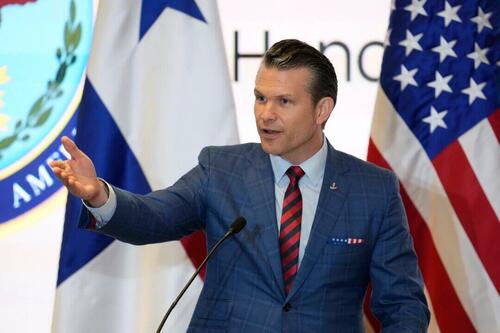 U.S. Secretary of Defense Pete Hegseth speaks during the Central American Security Conference in Panama City, on April 9, 2025. Matias Delacroix/AP Photo
U.S. Secretary of Defense Pete Hegseth speaks during the Central American Security Conference in Panama City, on April 9, 2025. Matias Delacroix/AP Photo
The program is operated by the United Nations and is “pushed by feminists and left-wing activists,” according to the defense secretary.
“This morning, I proudly ENDED the ‘Women, Peace & Security’ (WPS) program inside the [Department of Defense],” Hegseth wrote in a statement on X. “WPS is yet another woke divisive/social justice/Biden initiative that overburdens our commanders and troops—distracting from our core task: WAR-FIGHTING.”
Hegseth said that “politicians fawn” over the program but troops “hate” it.
The WPS program was developed in response to the Women, Peace, and Security Act, which Trump signed into law on Oct. 6, 2017. The Trump administration at the time said it recognized that women are important agents of change in preventing and resolving conflicts, countering violent extremism, and building peace and stability.
The law, outlined by the U.N. Security Council and adopted as in a resolution in 2000, had been championed over the years by various members of Congress. The cause was then taken up by Ivanka Trump, the president’s daughter and former advisor, after it was signed into U.S. law.
Ivanka said in a June 2019 statement that good defense policy requires women’s participation and empowerment. She also stated that women are “critically underrepresented in conflict-resolution and post-conflict peace building efforts” and women only make up 2 percent of mediators, 3 percent of military personnel, and 9 percent of negotiators globally.
Homeland Security Secretary Kristi Noem co-sponsored the WPS Act when she represented South Dakota in Congress.
Sen. Jeanne Shaheen (D-N.H.), who co-wrote the 2017 bill with then-Sen. Marco Rubio (R-Fla.), wrote on X that Hegseth’s latest move was “short-sighted.” She disagreed with Hegseth’s assertion that troops hate the program and argued it’s supported by military leadership and has proven to give the country a strategic advantage.
Amy McGrath, the first woman to fly a combat mission for the Marine Corps, argued in a statement on X that the program brought women to the negotiating table to end conflicts around the world. McGrath added that more sustainable peace is likely when women are included.
Hegseth later Tuesday appeared to push back on any criticism of his move on X. He doubled down on his decision to scrub the program, suggesting that the Biden administration “distorted and weaponized” the women’s initiative that was meant to be “straight-forward and security-focused” after it launched in 2017. Hegesth did not further elaborate how Biden allegedly “ruined” the program.
Tuesday’s announcement aligns with the Trump administration’s efforts to end federal diversity initiatives across the government. It also aligns with the efforts by the Department of Government Efficiency to slash government waste and abuse.
Hegseth declared he would “fight to end the program for our next budget.” The Pentagon did not provide specific details on how much the initiative costs.
From NTD News
-
Site: Zero HedgeMeta Soars After Blowing Away Estimates, Hikes Capex ForecastTyler Durden Wed, 04/30/2025 - 16:47
In our preview of META's Q1 results this afternoon (ahead of which Goldman's desk had positioning as a 7 out of 10), we said that it feels like centuries ago that META had that 20-day winning streak in Jan/Feb with the name now nearly 30% below YTD highs, which put tactical positioning in cleaner spot into today's print relative to recent META prints (bear case focused on macro/tariff-related risks to Revenues vs elevated capex/expense burdens). Well, the bulls can exhale because the results which META just reported will give them another taste of what that meltup felt lik, because the stock is surging 5% on a big top and bottom line beat, coupled with an increase to the capex guidance.
Here is are the blowout results which META reported for Q1:
- EPS $6.43 vs. $4.71 y/y, beating estimate $5.25
- Revenue $42.31 billion, +16% y/y, beating estimate $41.38 billion
- Advertising rev. $41.39 billion, +16% y/y, beating estimate $40.55 billion
- Family of Apps revenue $41.90 billion, +16% y/y, beating estimate $40.89 billion
- Reality Labs revenue $412 million, -6.4% y/y, missing estimate $496 million
- Other revenue $510 million, +34% y/y, beating estimate $498.6 million
- Operating income $17.56 billion, +27% y/y, beating estimates of $15.52 billion
- Family of Apps operating income $21.77 billion, +23% y/y, beating estimates of $20.04 billion
- Reality Labs operating loss $4.21 billion, +9.5% y/y, above the estimated loss $4.54 billion
- Operating margin 41% vs. 38% y/y, beating estimate 37.5%
- Ad impressions +5% vs. +20% y/y, missing estimates of +6.87%
- Average price per ad +10% vs. +6% y/y, beating estimates of +6.75%
- Average Family service users per day 3.43 billion, +5.9% y/y, beating estimates of 3.33 billion
Here are some of the key charts from the quarter, starting with Revenue by geography:
EPS:
Segment results:
Expenses continued to shrink:
Users are growing...
... as is revenue per user
Meta needs its advertising business to continue growing in order to fund an expensive expansion in artificial intelligence, which is driving the future of the business through improvements to ads, algorithms and personalization. Sure enough, the guidance was solid, if harldy stellar:
- For Q2, META expects revenue to be in the range of $42.5-45.5 billion, in line with the estimate of $44.1 billion.
- For the full year, META expects total expenses to be in the range of $113-118 billion, down from the prior outlook of $114-119 billion.
But perhaps most important, at a time when everyone was freaking out about sliding capex, Meta boosted its capex forecast, and now sees it be in the range of $64-72 billion, increased from our prior outlook of $60-65 billion.
This updated outlook "reflects additional data center investments to support our artificial intelligence efforts as well as an increase in the expected cost of infrastructure hardware. The majority of our capital expenditures in 2025 will continue to be directed to our core business."
This is important because while META once again missed on its actual capex, spending $12.94BN on property and equipment in Q1, well below the $14.239BN expected...
... the company is once again hockeysitcking its capex forecast, and is clearly backloading spending in the second half of the year, when at least according to most nevertrumper eceonomists, the US will be in a deep recession.
In response to the blowout earnings, shares rose as much as 5.6% in after-hours trading, after closing at $549. Meta stock was down more than 6% year-to-date before the company reported earnings, still performing better than most of America’s biggest technology companies amid the recent market selloff.
The full META presentation is below (pdf link). - EPS $6.43 vs. $4.71 y/y, beating estimate $5.25
-
Site: Zero HedgeElon Musk Not Working From White House Anymore, Chief Of Staff ConfirmsTyler Durden Wed, 04/30/2025 - 16:35
Authored by Jack Phillips via The Epoch Times (emphasis ours),
A top Trump administration official confirmed that Tesla CEO Elon Musk, a senior adviser to President Donald Trump, is no longer working from the White House.
 (L-R) Elon Musk, White House Chief of Staff Susie Wiles, and Commerce Secretary Howard Lutnick walk toward Marine One on the south lawn of the White House in Washington on March 7, 2025. Travis Gillmore/The Epoch Times
(L-R) Elon Musk, White House Chief of Staff Susie Wiles, and Commerce Secretary Howard Lutnick walk toward Marine One on the south lawn of the White House in Washington on March 7, 2025. Travis Gillmore/The Epoch Times
“Instead of meeting with him in person, I’m talking to him on the phone, but it’s the same net effect,” White House chief of staff Susie Wiles told the New York Post in an interview published Tuesday.
Musk, who leads the Department of Government Efficiency (DOGE), “hasn’t been here physically, but it really doesn’t matter much,” Wiles said. “His folks aren’t going anywhere.”
Wiles said they are working in the Eisenhower Executive Office Building near the West Wing of the White House.
“He’s not out of it altogether. He’s just not physically present as much as he was,” Wiles said. “The people that are doing this work are here doing good things and paying attention to the details. He’ll be stepping back a little, but he’s certainly not abandoning it. And his people are definitely not.”
The Epoch Times contacted the White House for additional comment on Wednesday.
Last week, Musk told Tesla investors on a call that he would be stepping away from DOGE and White House work starting in May. As a special government employee, Musk also has to leave the government within 130 days of beginning his role there.
Musk said on the call that he will continue to support the Trump administration and DOGE “to make sure that the waste and fraud that we stop does not come roaring back.”
He made those remarks as his company posted lower-than-anticipated profits and net revenue for the first quarter of 2025. Tesla has also been subject to a series of arson attacks and vandalism since Musk joined the administration, leading to several arrests, which Musk has decried.
Before that, Trump told reporters on April 3 that Musk will leave in “a few months” and noted that he has “companies to run,” stressing he wants the tech billionaire to “stay as long as possible.”
Vice President JD Vance said in an early April Fox News interview that after Musk leaves the administration, he will provide recommendations to the administration because “DOGE has got a lot of work to do.”
Since taking office on Jan. 20, Trump has been on a cost-cutting spree that has taken recommendations from DOGE, including the slashing of tens of thousands of federal jobs and the attempted dismantling of multiple agencies. DOGE and the administration have faced a number of lawsuits, with some judges temporarily pausing DOGE’s access to multiple agencies.
A DOGE website that gives regular updates says that some $160 billion has been saved to date, while more than 8,400 government contracts and more than 9,600 grants have been terminated so far. The organization has also canceled some 470,000 credit cards used by dozens of federal agencies since it started.
But the effort to slash government funding is not without critics. Congressional Democrats on Tuesday, without naming DOGE, said that Trump and Musk have blocked more than $400 billion in funding that they say was approved by Congress.
“Instead of investing in the American people, President Trump is ignoring our laws and ripping resources away,” said Sen. Patty Murray (D-Wash.) and Rep. Rosa DeLauro (D-Conn.), the top Democrats on the Senate and House appropriations committees.
House Democrats in a letter this month also reminded Musk that he must leave the government before May 30, and asked for confirmation that he would do so.
“We demand an immediate public statement from your administration making clear that Musk will resign and surrender all decision making authority,” the letter said.
-
Site: Zero HedgeMicrosoft Surges After AI/Cloud Growth Accelerates; But CapEx SlowedTyler Durden Wed, 04/30/2025 - 16:18
On the heels of Microsoft's decision to walk away from discussions to lease new server farm space and slow construction on land it already owns, all eyes are on the giant tech company's fiscal third-quarter earnings tonight for any signs of slowing on data center spending plans when it reports Wednesday.
“We believe that the Azure results and guidance as well as Microsoft’s commentary on capex are going to be the keys to the quarter,” wrote Kirk Materne, an analyst at Evercore ISI.
Investors watch these expenses closely for a glimpse of long-term cloud and AI demand expectations from the world’s largest software maker.
So, what's the score?
MSFT beat on EVERYTHING...
Microsoft beat on the top line with Q3 revenues of $70.07 Billion (well above the $68.48 billion consensus) and the bottom line (EPS $3.46 vs $3.22 consensus)
-
Microsoft Cloud revenue $42.4 billion, estimate $42.22 billion
-
Intelligent Cloud revenue $26.8 billion, estimate $25.99 billion
-
Azure and other cloud services revenue Ex-FX +33%, estimate +31%
-
Productivity and Business Processes revenue $29.9 billion, estimate $29.65 billion
-
More Personal Computing revenue $13.4 billion, estimate $12.67 billion
Cloud revenue surged more than expected with revenues of $42.4 billion (above the $42.22 billion consensus),
“We delivered a strong quarter with Microsoft Cloud revenue of $42.4 billion, up 20% (up 22% in constant currency) year-over-year driven by continued demand for our differentiated offerings,” said Amy Hood, executive vice president and chief financial officer of Microsoft.
Azure & Other Cloud revenue (es-FX) up 35% (better than the 31% consensus).
...AI growth making up 16ppts of that 35% (exp 15.6ppts)...
“Cloud and AI are the essential inputs for every business to expand output, reduce costs, and accelerate growth," said Satya Nadella, chairman and chief executive officer of Microsoft.
“From AI infra and platforms to apps, we are innovating across the stack to deliver for our customers.”
Operating income was also a solid beat: $32.00 billion, estimate $30.31 billion
But after 10 consecutive quarters of increased spending for artificial intelligence, the company has put on the brakes.
While top-line capital expenditure was $16.75 billion vs. $10.95 billion y/y (above the $16.28 billion consensus)
But, in the first three months of 2025, Microsoft spent $21.4 billion on Capital expenditures including assets acquired under finance leases, down more than $1 billion from the previous quarter (and below the $22.56 billion consensus).
The company is still on track to spend more than $80 billion on capital expenses in the current fiscal year, which ends in June. But, as The NY Times notes, the pullback, though slight, is an indication that the tech industry’s appetite for spending on A.I. is not limitless.
As a result of all this, MSFT shares are soaring after hours...
...and we can't help but wonder if someone 'knew' about this 'early' given the moves in the market in the last minutes before the bell.
All eyes now on the call for any signals of a reduction in CapEx (expected at $88 billion for the fiscal year ending in June and $100 billion for the following fiscal year).
-
-
Site: southern orders
-
Site: Zero HedgeSour Patch Kids, Oreos, Ritz Demand Slides Across North America, Says MondelezTyler Durden Wed, 04/30/2025 - 14:25
A slowdown in economic activity, combined with growing tariff uncertainty, appears to be curbing consumer appetite for highly processed junk food. The latest trends show a declining demand for sweet snacks in North America as more shoppers shift their spending toward real food, such as meat, vegetables, and eggs.
Mondelez International — the maker of Sour Patch Kids, Oreos, Ritz, Toblerone, Cadbury, and other highly processed food brands — reported slower-than-expected sales for the first quarter.
Organic revenue, which excludes currency fluctuations and one-time items, increased 3.1%, falling short of the Bloomberg consensus estimate of 3.5%. Notably, sales in North America declined during the quarter.
On an earnings call, Mondelez CEO Dirk Van de Put told analysts: "I really do not expect to see a significant improvement in consumer confidence in the near term in the US."
"Two, three years ago consumers would easily pay above $4 for a pack of biscuits," Van de Put said adding, "We're now seeing that we need to be below $4 and ideally below $3."
Mondelez noted that shoppers are beginning to prioritize real food — if that's meat, vegetables, and eggs — over snacks, chips, and candy. Also, lower-income consumers are pivoting towards smaller packages, while higher-income consumers are searching for larger value bundles.
Mondelez reiterated its full-year guidance and warned profit will slide 10% this year "due to unprecedented cocoa cost inflation."
Weighing in on the North American junk food slowdown, Goldman analysts Leah Jordan and Eli Thompson offered clients their first take on Mondelez's first-quarter results and its unchanged full-year outlook:
-
North America came in softer-than-expected on the back of retailer destocking and softer cracker demand as the consumer remains value-focused;
-
chocolate elasticity tracked in-line with expectations, although more pricing is still to come; and
-
MDLZ reiterated its FY25 guide in constant currency while potential upside is likely to be reinvested throughout the year to support potential growth in FY26
The key takeaway for the North American market:
- North America softer-than-expected: Organic net sales in North America came in softer-than-expected at -3.6% (vs GS/consensus of flat/+0.1%), largely due to retailer destocking (-250 bps), while segment profitability also missed. The destocking impact should be one time in nature, but we do not expect it to reverse as we have heard from retailers that this effort has been driven by efficiency gains. Additionally, MDLZ noted softer demand for crackers (vs cookies), although both categories are holding up relatively better than other parts of snacking, plus the company is holding share due to investments in price pack architecture and key activations. Additionally, management spoke to increasing promotional activity by peers in crackers, and we see greater private label competition in the category as well. Regarding consumer behavior, the company noted a shift to smaller pack sizes by the lower end and toward multi-packs for upper income cohorts, along with a shift in channels toward dollar stores, clubs, and value retailers.
Details about the cocoa market:
- Chocolate elasticity tracking in-line, although more pricing still to come: MDLZ indicated elasticity within chocolate tracked in-line with expectations at -0.5%, while it gained share in the category. However, more pricing will be implemented in the spring with management taking a wait and see approach while expressing confidence in its chocolate strategy with a range of price points. The company expects a top line acceleration throughout the year, supported by both pricing and volumes, with Easter strength noted for 2Q and pricing negotiations are now complete in Europe (vs a disruption last year). By region, management highlighted solid Easter chocolate demand for Europe/UK, Brazil, and Australia, with stable YTD elasticities noted for Europe and Emerging Markets. Notably, MDLZ indicated greater elasticity for chocolate in the U.S. vs ROW with volumes tracking down -5%, which is a negative read-through for HSY.
Notes on guidance:
- Reiterated FY25 guide with potential upside expected to be reinvested: MDLZ reiterated its FY25 guidance with an adj EPS decline of -10% (constant currency), noting potential upside would likely be reinvested (e.g., 1Q beat planned to be reinvested in marketing this year), while the tariff impact remains small. FY25 organic sales guidance was also reiterated at +5%, with sequential improvements supported by both volume and pricing. We also expect a gross margin improvement throughout the year tied to its pricing action. Regarding FY26, MDLZ expects EPS growth y/y, but management stopped short on the magnitude of potential ranges given cocoa uncertainty. For cocoa, the company still sees a supply/demand surplus with further demand destruction likely (as some will likely reformulate). Furthermore, the company sounded constructive on its position given lower cocoa butter prices y/y, its bigger input exposure.
Despite key downside risks, such as an economic slowdown, Goldman analysts remained "Buy" rated on Mondelez, with a 12-month price target of $71.
Mondelez did not indicate that the slowdown in junk food demand was influenced by the "Make America Healthy Again" movement in any way (well at least not yet).
-
-
Site: Zero HedgeWaste Of The Day: Houston Superintendent Gets Bonus After "D" GradeTyler Durden Wed, 04/30/2025 - 14:05
Authored by Jeremy Portnoy via RealClearInvestigations,
Topline: The Houston Independent School District is facing a budget deficit that at one point reached $250 million, but that did not stop Superintendent Mike Miles from accepting a $126,730 bonus in April to supplement his $380,000 salary.
Key facts: Miles’ bonus was calculated after he received a 66.7 out of 100 on his first annual evaluation from the school board that measured student performance, “executive leadership” and “vision,” according to the Houston Chronicle. A perfect score would have netted Miles a $190,000 bonus.
The school district has struggled with funding for years, as have other large school districts in Texas. The state government has not increased public school funding since 2019 to keep pace with inflation, and yet some of Houston’s struggles come simply from overspending. Cumulative inflation from 2019 to 2024 in the U.S. was 22%, but Houston ISD increased its payroll by 29% in that timespan, according to OpenTheBooks’ database.
Last year the school released an audit detailing “overtime abuse” that forced the district to pay $26 million in one year. Auditors also found an “overreliance on purchased services” and “overuse of consultants with several other costs to overall effectiveness.”
The district began the current school year with a $125 million deficit, but Miles asked the school board to approve an amendment that increased spending and ballooned the deficit to $250 million, forcing the district to dig into its reserves and one-time savings.
Next year the district projects a $33 million deficit after laying off 1,500 employees. Miles is also considering closing some school buildings to cut costs.
Search all federal, state and local government salaries and vendor spending with the AI search bot, Benjamin, at OpenTheBooks.com.
Supporting quote: Miles told the school’s community advisory committee, “I assure you, that bonus and incentive was well deserved, and I know my value, and achievement results show that.”
Critical quote: The Houston Chronicle’s editorial board equated Miles’ 66.7 evaluation score to a “D,” claiming that “It’s a lousy grade. The kind you bury at the bottom of your backpack in hopes it disappears before somebody sees. That's essentially what the district tried to do. Chronicle reporters had to file a public information request to get a copy of the evaluation.”
Summary: Houston is far from the only school district giving its superintendent a generous bonus, but a fiscal crisis — and a “D” grade — is not the time to do it.
The #WasteOfTheDay is brought to you by the forensic auditors at OpenTheBooks.com
* * *
You can support ZeroHedge by picking up a waxed canvas hat!
 Click hat... add to cart... check out... receive awesome hat...
Click hat... add to cart... check out... receive awesome hat...
-
Site: Zero HedgeSen. Josh Hawley Introduces PELOSI Act To Stop Insider-TradingTyler Durden Wed, 04/30/2025 - 13:25
Senator Josh Hawley (R-MO) has reintroduced the “Preventing Elected Leaders from Owning Securities and Investments” (PELOSI) Act that would prohibit members of Congress and their families from trading stocks while in office.
The name of the act is a direct nod in the direction of 20 term Congresswoman Nancy Pelosi (D-CA) whose net worth has soared from $160,000 when she was first elected in 1987 to more than $140 million in 2024.
The bill to ban congressional stock trading is entitled the PELOSI Act, or "Preventing Elected Leaders from Owning Securities and Investments."
— Charlie Kirk (@charliekirk11) April 29, 2025
I usually don't like cute names for pieces of legislation, but this one hit the nail on the head. Bravo.
Pass it!! pic.twitter.com/pN8nicKJRxPelosi’s husband Paul, who narrowly survived a hammer attack 2022, is an investor who has made significant financial gains on stock trades that some speculate may have been based on insider information.
Hawley first introduced the PELOSI Act in 2023 but it failed to gain traction under the Biden administration.
Since then, the proposal has gained support on both sides of the congressional aisle and Fox News reports that President Trump has said he would “absolutely” sign the ban if it arrives on his desk.
Hawley has been a consistent critic of members of Congress being more focused on day-trading than they are on representing their constituents.
In a statement, Hawley said, “Americans have seen politician after politician turn a profit using information not available to the general public. It’s time we ban all members of Congress from trading and holding stocks and restore Americans’ trust in our nation’s legislative body.”
The PELOSI Act would prohibit lawmakers and their spouses from purchasing, selling or holding stocks during the time that the lawmaker is in office.
Lawmakers would still be able to invest in U.S. Treasury Bonds, diversified mutual funds or exchange-traded funds while in office.
Should the PELOSI Act be signed into law, current members of Congress would have 180 days to comply with newly elected members being required to comply with in 180 days of entering office.
Lawmakers who violate the act would be required to hand over their profits to the U.S. Treasury Department and could also face fines of up to 10% on each transaction.
-
Site: Zero HedgeOil Plunges On Report Saudis Bracing For Price War, Can "Live With Lower Oil Prices"Tyler Durden Wed, 04/30/2025 - 13:08
It had already been a miserable month for oil, which has suffered its worst monthly performance since 2021 and also is on pace for its month of April on record... and then it got even worse when shortly before noon ET, when Reuters reported, citing multiple sources, that Saudi Arabian officials are briefing allies and industry experts to say the kingdom is unwilling to prop up the oil market with further supply cuts and can handle a prolonged period of low prices.
This shift in Saudi policy could suggest a move toward producing more and expanding its market share, a major change after five years spent balancing the market through deep output as a leader of the OPEC+ group of oil producers. Those cuts had supported prices, in turn bolstering the oil export revenue that many oil producers rely on, but many OPEC+ members - most notably Kazakhstan - took advantage of the production restraint and blew away through their export quotas, infuriating other cartel members.
Sure enough, Reuters notes that Riyadh has been angered by Kazakhstan and Iraq producing above their OPEC+ targets. And after pushing members to adhere to those targets and to compensate for oversupply in recent months, a frustrated Riyadh is changing tack, OPEC+ sources said.
Saudi Arabia pushed for a larger-than-planned OPEC+ output hike in May, a decision that helped send oil prices below $60 a barrel to a 4-year low.
And now that Kazahkstan blew it for all cartel members, everyone will share the pain equally, as lower prices are bad news for producers that rely on oil exports to fund their economies. Although producers like Saudi have a very low cost of production, they need higher oil prices to pay for government spending. When oil prices fall, many large oil-producing countries come under pressure to cut their budgets.
And just to confirm that they are not bluffing, the Saudis appear to be briefing allies and experts that they are ready to do just that. The last time they did just that was in March 2020, just before covid shut down the global economy and briefly sent oil prices negative, sparking budget crises across all OPEC members.
Saudi officials in recent weeks have told allies and market participants the kingdom can live with the fall in prices by raising borrowing and cutting costs, the five sources said.
"The Saudis are ready for lower prices and may need to pull back on some major projects," one of the sources said. All sources declined to be named due to sensitivity of the issue.
The problem is that Saudi Arabia needs oil prices above $90 to balance its budget, higher than other large OPEC producers such as the United Arab Emirates, according to the International Monetary Fund (IMF). As a result, Riyadh may need to delay or cut back some projects due to the price drop, analysts have said.
OPEC+, which besides the Organization of the Petroleum Exporting Countries also includes allies such as Russia, may decide to speed up output hikes again in June, OPEC+ sources have said. OPEC+ is cutting output by over 5 million barrels or 5% of global supply, to which Saudi Arabia is contributing two-fifths.
Russia, the second largest exporter in OPEC+ behind Saudi Arabia, is aware of Riyadh's plans for faster output increases, said two of the five sources who are familiar with the Russian thinking and conversations with Riyadh. Even so, Russia would prefer the group stick to slower output increases.
Saudi Arabia and Russia, the de facto leaders of OPEC+, make the biggest contributions to OPEC+ cuts. Russia's budget balances at about $70 a barrel and the Kremlin's spending is on the rise due to the Russian war in Ukraine.
Russia may see a further fall in revenue as prices for its discounted, sanctioned oil could fall below $50 a barrel as a result of OPEC+ output rises, one of the two sources said.Theories on the apparent change in Saudi strategy range from punishing OPEC+ members exceeding their quotas to a move to fight for market share after ceding ground to non-OPEC+ producers such as the United States and Guyana. Higher output may also be a fillip to U.S. President Donald Trump, who has called for OPEC to boost output to help keep U.S. gasoline prices down.
Trump is due to visit Saudi Arabia in May and could offer Riyadh an arms package and a nuclear agreement. OPEC+ decided to triple its planned output increase to 411,000 bpd.
That still leaves OPEC+ holding back more than 5 million bpd, curbs the group aims to unwind by the end of 2026.
"We would still call this a 'managed' unwind of cuts and not a fight for market share," UBS analyst Giovanni Staunovo said.
“This confirms the market’s fears that Saudi Arabia’s accelerated unwinds were not temporary, but a long-term strategy shift,” said Rebecca Babin, a senior energy trader at CIBC Private Wealth Group. It raises the question of whether “Saudi is going to repeat the 2020 playbook to dramatically increase production.”
For now the market is voting "yes", and the news sent WTI tumbling as much as 4%,or more than $2 to just under $58, the lowest price since early 2021 (and a level which was only briefly breached after Trump's Liberation Day sent oil to $55 before rebounding rapidly).
OPEC+ rocked the crude market in early April, with a surprise decision to increase supply in May by 411,000 barrels a day, the equivalent of three monthly tranches from a previous plan. Morgan Stanley has said it expects a “meaningful surplus” to develop over time, while JPMorgan Chase & Co. warned the cartel may accelerate planned production increases at a meeting next week.
Beyond OPEC+, non-cartel nations are also expected to add supplies, including drillers in Canada and Guyana, feeding concerns about a global glut.
At the same time, hopes are fading that there will be quick breakthroughs in US-led trade negotiations, weighing on the outlook for energy demand. The US economy contracted for the first time since 2022 in the first quarter as a result of a surge in pre-tariff imports and softer consumer spending. In China, factory activity slipped into the worst contraction since December 2023, revealing early damage from the trade war.
-
Site: Zero HedgeAppeals Court Upholds Restrictions On Deportations Of Venezuelans From USTyler Durden Wed, 04/30/2025 - 13:05
Authored by Zachary Stieber via The Epoch Times (emphasis ours),
A federal appeals court on April 29 turned down the Trump administration’s bid to block restrictions on deporting Venezuelans from Colorado.
 Venezuelan illegal immigrants deported from the United States disembark from a Conviasa Airlines plane upon arrival at Simon Bolivar International Airport in Maiquetia, Venezuela, on March 24, 2025. Juan Barreto/AFP via Getty Images
Venezuelan illegal immigrants deported from the United States disembark from a Conviasa Airlines plane upon arrival at Simon Bolivar International Airport in Maiquetia, Venezuela, on March 24, 2025. Juan Barreto/AFP via Getty Images
The government did not show that it is likely to be irreparably harmed if a lower court order remains in place, a unanimous three-judge panel of the U.S. Court of Appeals for the 10th Circuit ruled.
Under court precedent, a party seeking a stay pending appeal must show it will likely be irreparably harmed absent a stay.
U.S. District Judge Charlotte N. Sweeney recently issued a temporary restraining order requiring the Trump administration to give Venezuelans arrested for alleged links to the Tren de Aragua gang three weeks’ notice before deportation.
The order applies to all noncitizens in Colorado who were, are, or will be subject to President Donald Trump’s March invocation of the Alien Enemies Act. The president at the time said that Tren de Aragua had invaded the United States, and he directed officials to arrest and deport its members.
“All members of the class are in federal custody. And given the important unresolved issues under the Alien Enemies Act (AEA) and the ruling of the United States Supreme Court that no one in that proceeding be removed under the AEA until further order of that Court ... there is no realistic possibility that the government could remove any member of the class from this country before final expiration of the TRO on May 6, 2025,” the 10th Circuit panel stated.
Lawyers for the government and the plaintiffs in the case did not respond to early morning requests for comment.
Four factors must be met to secure a stay pending appeal. The appeals court did not address the other three factors, which include presenting a strong showing that a party is likely to succeed in the case since the irreparable harm standard was not met, the judges said.
The panel consisted of U.S. Circuit Judges Harris L. Hartz, Gregory A. Phillips, and Joel M. Carson.
Government lawyers had said in filings that Sweeney lacked jurisdiction to halt deportations because the plaintiffs were not in custody at the time of the ruling. Immigration and Customs Enforcement had released the plaintiffs because it determined they were not subject to the Alien Enemies Act.
The lawyers also argued that the restraining order “irreparably harms the United States’ conduct of foreign policy” because it “usurps the President’s statutory and constitutional authority to address what he has identified as an invasion or predatory incursion.”
Attorneys representing the Venezuelans had said in response that the restraining order was proper because the government had been giving people arrested under the invocation just 24 hours’ notice of removal, which they said did not achieve due process.
-
Site: Zero HedgeThe Spanish Power Outage: A Catastrophe Created By Political Design & A Warning To The WorldTyler Durden Wed, 04/30/2025 - 11:45
On April 23rd, I participated in a conference at the European Parliament on the future of nuclear energy with experts from all over Europe, where I warned that, with the current energy policies, blackouts will be the norm, not a coincidence.
The shortsighted and sectarian policy of the activists who populate the government has led us to the worst blackout in the history of Spain. We have been without communication or electricity for nearly eleven hours.
This blackout, with the immediate collapse of fifteen gigawatts of power in the system, is the consequence of a policy that penalizes base energy, key to providing stability to the system, and plunders the energy sector.
Governments have been dedicated to closing nuclear power plants, making them unviable with abusive and confiscatory taxation; penalizing investment in distribution with absurd regulations; imposing a volatile and intermittent energy mix; and burdening energy with elevated taxes and administrative delays. What could go wrong? Everything.
And it happened.
Renewable energies, while essential in a balanced energy mix, cannot provide safety and stability due to their volatility and intermittent nature. That’s why it is essential to have a balanced system with base-load energy that operates all the time, such as hydropower, nuclear, and natural gas as backup.
Destroying access to nuclear energy with unnecessary closures and confiscatory taxation has been part of the fundamental causes of the disaster and the blackout.
Last week, they had to close the remaining nuclear power plants because their taxes are so high that they cannot cover their fixed costs. They have destroyed nuclear plants’ economics by political design. Moreover, those plants would have provided stability to the grid if national and regional governments, which use nuclear and hydroelectric power as cash cows for their revenue-hungry policies, had prioritized supply security over energy sectarianism.
There is much more.
Spain and Portugal produce electricity with more than 60% solar and wind energy. Hydraulic, nuclear, and combined cycle gas plants must cover the shortfalls in solar and wind production, which is intermittent. There is no possibility of having a stable and secure system with a continuous supply if the electrical grid is not balanced to avoid a total blackout.
According to Euronews, France sometimes produces too much electricity, leading the network operator RTE to disconnect solar or wind sites. The consumer pays taxes to cover the operator’s losses. This procedure prevents a general blackout of the grid.”In Spain, the president of Red Eléctrica, Beatriz Corredor, whose experience in energy is more than scarce, has never given a message or coordinated actions to prevent blackouts that were happening more frequently recently. We have been experiencing sporadic supply cuts to the industry for years, and just a week ago, the Chamartín station had a severe supply cut episode.
The crisis was not only a disaster due to the shortsighted energy policy of the current and previous governments. It was a disaster due to the inaction of the Ministry of Defence. Similar to the recent floods, our security forces exhibited astonishment at their lack of mobilization. Trains and elevators blocked thousands of travelers for hours, while the army stood by, waiting for orders.
Six days ago, the government, left-wing parties, and many media outlets celebrated that Spain’s power grid ran entirely on renewable energy for a weekday for the first time. Bravo. A week later, a massive blackout in Spain, Portugal, and parts of France. France quickly restored electricity because it has the largest nuclear fleet in Europe. In Spain, the government maintained a confiscatory taxation system that prevented nuclear plants from operating, resulting in nearly eleven hours of darkness and no communication.
Red Eléctrica reported that the cause was a “strong oscillation in the electrical grid” that “forced the Iberian Peninsula to disconnect from the European system”. The collapse was immediate and long-lasting. It was the longest power outage in the history of Spain. The recovery efforts were in vain as they attempted to restore frequency control and stability with a system dependent on volatile and intermittent renewables.
A system without physical inertia, provided by baseload energies that operate all the time—nuclear and hydroelectric—makes it impossible to stabilise the grid in the face of supply disruptions.
When the collapse occurred, the Spanish electrical grid had almost 80% renewable generation, 11% nuclear, and only 3% natural gas. There was practically no base generation or physical inertia to absorb the shock that was generated.
For years, experts have issued warnings. Experts from around the world have been accused of being mouthpieces for invented lobbies when they warned of the risk to the system from overloading with renewables and eliminating or limiting base-load energies. In 2017, the European Network of Transmission System Operators warned that the increase in renewables would raise the risk of cascading failures if urgent investment was not made in synthetic inertia and storage technologies. Moreover, even if investment is made in storage, hundreds of experts warned about the additional burden with the electrification of the mobile fleet. Despite the warnings from energy companies and operators, the European Commission maintained its bet on renewable development that was poorly planned and worse executed. This included a New Green Deal that ignored the importance of networks and backup and seemed designed by school activists.
The Spanish government wanted to present itself as the top student of that so-called ecological sectarianism, which ignores copper and lithium mining, the importance of backup, and system stability. What have they achieved? They have created a disaster that has the potential to repeat itself.
Blackouts, which should have been something obsolete and forgotten, have become the norm since politicians have ideologised energy. Other countries have suffered similar problems: Australia (2016), Germany (2017), and the United Kingdom (2019) experienced blackouts or near-blackouts due to insufficient energy reserves or grid stability measures. However, none of these incidents have been as dramatic or scandalous as the one in Spain.
The governments of Spain have decided that the closure of all our nuclear power plants will be effective in 2035, despite all the technicians reminding us that they work perfectly and their lifespan could be extended by at least ten years. This action is going to increase dependence on renewables and Russian natural gas. In other words, Spain’s shortsighted policy is going to make the country more dependent on China and Russia for energy and face constant blackouts and supply cuts to the industry as if it were a third-world dictatorship.
Propaganda told us that renewables would bring competitiveness and stability to the grid, but the reality shows that an over-reliance on certain renewables and a shortage of base-load energy sources indicate that the electrical grid increasingly depends on the few nuclear and natural gas plants that operate to maintain supply stability.
The blackout in Spain was not caused by a cyberattack but by the worst possible attack, that of politicians against their citizens.
It is urgent that Spain radically changes its energy strategy, that we maintain and expand the nuclear and base energy park, or we will depend more on Russia and China and, moreover, with blackouts.
-
Site: Zero HedgeThe Gold Rush You Weren't Supposed To Notice & The Next Big Monetary ResetTyler Durden Wed, 04/30/2025 - 11:05
Authored by Nick Giambruno via InternationalMan.com,
Last year, central banks purchased approximately 34 million ounces of gold, marking the third consecutive year of near-record buying.
We’re witnessing the acceleration of a long-term trend that began around the 2008 financial crisis, when central banks shifted from net sellers to net buyers of gold. That trend has exploded in recent years, with gold purchases surging to record-breaking levels, as shown in the chart below.
All signs indicate that 2025 will be another massive year for central bank gold buying.
Central banks and governments are the largest single holders of gold in the world. Together, they officially own over 1.2 billion troy ounces—out of the 6.9 billion ounces humans have mined throughout history.
However, these are just the official numbers that governments report. The actual gold holdings could be much higher, as governments tend to be secretive about their reserves, treating gold as a strategic financial asset.
Russia and China—the US’s top geopolitical rivals—have been the biggest gold buyers over the last two decades.
It’s no secret that China has been stashing away as much gold as possible for many years.
China is the world’s largest producer and buyer of gold. Russia is number two. Most of that gold enters the Chinese and Russian government’s vaults.
The trend of central bank gold accumulation is gaining momentum. If the rest of the world is moving back toward gold, the US will not want to be left behind.
Yet, officially, the US has not added a single ounce to its 261 million ounces of gold reserves in decades.
Unofficially? That may be a different story.
Since Trump’s victory in the 2024 presidential election last November, a sudden flood of physical gold has flowed into the US from major gold hubs like London, Switzerland, and elsewhere.
The gold market is typically dominated by paper trading, with large-scale physical deliveries being rare. However, CNBC and the World Gold Council report that more than 19 million ounces—possibly much more—of physical gold has entered the US since November.
That’s roughly 13% of the total alleged gold holdings in Fort Knox flowing into the US in less than six months.
This is not normal market action.
This strongly suggests that a non-market entity—most likely the US government—is behind this massive gold movement.
That’s why Trump’s recent comments about Fort Knox are so interesting.
Trump recently brought Fort Knox into the national conversation, something no US president has done in decades.
Would he have even mentioned the possibility of auditing Fort Knox if the vaults were empty? I doubt it.
Instead, there’s a good chance that the enormous inflow of physical gold into the US is happening in anticipation of an audit.
Connecting the Dots—Something Big Is Coming
So, here’s what we know:
-
Trump has put Fort Knox’s gold holdings back in the national spotlight for the first time in decades.
-
Central bank gold purchases are accelerating at record-breaking levels.
-
An unusually large influx of physical gold is flowing into the US, far beyond regular market activity.
Follow the Gold. It Always Leads to the Truth
Central banks are hoarding gold at record levels. The US government is likely pulling in millions of ounces. And Trump is talking about Fort Knox.
This isn’t coincidence.
Find out what they’re preparing for and how you can be ready in our urgent dispatch:
The Most Dangerous Economic Crisis in 100 Years… the Top 3 Strategies You Need Right Now
-
-
Site: southern orders
April 30, 2025 at 8:48am
Front-runner Parolin's audition is a flop
Cardinal Pietro Parolin had an audition of sorts for pope on Sunday and the reviews are in and hey aren't good. Parolin, seen as a front-runner for the seat of St. Peter, said Mass for 200,000 young people in St. Peter's Square. He praised Pope Francis, but his stilted style left him unable to connect with a crowd. As one cardinal-elector told the National Catholic Reporter, the Mass was a reminder of Francis' charisma and communication gifts and that Parolin lacks both.BUT THEN, THE NCR FREAKS OUT OVER INSULTS HURLED AT THEIR PREFERRED CANDIDATE, CARDINAL TAGLE! THIS COMMENTARY IS OVER THE TOP AND SHOWS THE FEAR OF THE NCR AT THIS JUNCTURE IN PAPAL HISTORY:Push title: -
Site: southern orders
April 30, 2025 at 8:48am
Front-runner Parolin's audition is a flop
Cardinal Pietro Parolin had an audition of sorts for pope on Sunday and the reviews are in and hey aren't good. Parolin, seen as a front-runner for the seat of St. Peter, said Mass for 200,000 young people in St. Peter's Square. He praised Pope Francis, but his stilted style left him unable to connect with a crowd. As one cardinal-elector told the National Catholic Reporter, the Mass was a reminder of Francis' charisma and communication gifts and that Parolin lacks both.BUT THEN, THE NCR FREAKS OUT OVER INSULTS HURLED AT THEIR PREFERRED CANDIDATE, CARDINAL TAGLE! THIS COMMENTARY IS OVER THE TOP AND SHOWS THE FEAR OF THE NCR AT THIS JUNCTURE IN PAPAL HISTORY:Push title: -
Site: Zero HedgeStagflation Scenario Slammed As Fed's Favorite Inflation Indicator Tumbles To Four Year LowsTyler Durden Wed, 04/30/2025 - 10:16
The Fed's favorite inflation indicator - Core PCE - printed cooler than expected in March, unchanged MoM (vs +0.1% exp), bring prices up 2.6% YoY - the lowest since March 2021...
Source: Bloomberg
...with non-durable goods deflating MoM the biggest drag on Core PCE
...but, but, but we were told tariffs would spark hyper-super-scary-inflation?
The headline PCE was -0.045% MoM - the biggest MoM drop since COVID lockdowns...
...dragging headline PCE YoY down to +2.3%...
SuperCore PCE also saw the YoY pace slow significantly...
Spending outpaced incomes significantly in March...
Source: Bloomberg
Which means that the savings rate fell to 3.9% from 4.1% in February, which was revised lower from 4.6%...
Adjusted for inflation, real personal spending surged 0.7% MoM (not a total surprise given that 'consumers' are panicking over an imminent surge in inflation, of course they should be spending)....
It appears DOGE is doing its jobs too - crushing govt wage growth
-
March Government worker wages and salaries up just 2.9%, down from 3.2% in Feb and the lowest since Sept 2020
-
March Private worker wages and salaries up 5.4%, down from 5.7%, and lowest since Dec 2022
...and there goes the stagflation scenario.
-
-
Site: Zero HedgeJudge Bars Border Patrol From Making Warrantless Arrests Of Illegal Immigrants In Parts Of CaliforniaTyler Durden Wed, 04/30/2025 - 09:40
Authored by Tom Ozimek via The Epoch Times (emphasis ours),
A federal judge in California has barred U.S. Border Patrol agents from arresting suspected illegal immigrants within parts of the state without a warrant or specific evidence that the individual poses a flight risk—while delivering a rebuke to tactics used during a controversial January enforcement sweep.
 Border Patrol agents wait for the arrival of Defense Secretary Pete Hegseth for a visit to the US-Mexico border in Sunland Park, New Mexico, on Feb. 3, 2025. AP Photo/Andres Leighton, File
Border Patrol agents wait for the arrival of Defense Secretary Pete Hegseth for a visit to the US-Mexico border in Sunland Park, New Mexico, on Feb. 3, 2025. AP Photo/Andres Leighton, File
In an April 29 order, U.S. District Judge Jennifer L. Thurston issued a preliminary injunction against the Department of Homeland Security (DHS) and Border Patrol, siding with the United Farm Workers and five Kern County residents who sued after the raid, dubbed “Operation Return to Sender,” unfolded across the Bakersfield area earlier this year.
The plaintiffs, represented by the American Civil Liberties Union (ACLU), alleged in their Feb. 26 complaint that the sweep violated their Fourth and Fifth Amendment rights, along with federal immigration statutes governing warrantless arrests and due process.
Under Thurston’s order, Border Patrol agents operating in California’s Eastern District are now prohibited from making detentions or arrests without first establishing reasonable suspicion of unlawful presence in the country and, for arrests, probable cause that the individual is likely to flee before a warrant can be obtained.
“The evidence before the Court is that Border Patrol agents under DHS authority engaged in conduct that violated well-established constitutional rights,” Thurston wrote in the ruling.
The court also restricted the agency’s use of “voluntary departure,” a process by which illegal immigrants agree to leave the United States without a hearing before an immigration judge. Going forward, agents must clearly inform individuals of their rights and obtain genuine, informed consent before initiating such removals.
The judge further ordered DHS to submit regular reports documenting any warrantless stops or arrests, along with justifications, for the duration of litigation. She also instructed DHS to issue written guidelines clarifying the legal threshold for initiating stops.
“This guidance shall include, among other things, that refusal to answer questions does not, without more, constitute a basis for reasonable suspicion to justify a detentive stop,” she wrote.
The case stems from allegations that, beginning in early January 2025, dozens of Border Patrol agents traveled more than 300 miles inland from the U.S.–Mexico border to Bakersfield, targeting predominantly Latino neighborhoods and day laborer gathering spots without individualized suspicion.
The plaintiffs described “Operation Return to Sender” as a sweeping dragnet based on racial and occupational profiling, claiming agents pulled over vehicles, blocked parked cars, conducted warrantless searches, and detained people without evidence of unlawful presence.
Once in custody, detainees were allegedly transported to a facility near the border, denied access to attorneys, and pressured into signing “voluntary departure” forms without understanding the consequences—a process plaintiffs described as “summary expulsion” that can carry long-term reentry bans.
Once in custody, detainees claimed they were transported to a Border Patrol facility near the border, where they were denied access to lawyers and coerced into signing “voluntary departure” forms under misleading pretenses, which they described as a “form of summary expulsion.”
Attorneys for the Justice Department argued the case should be dismissed, claiming the plaintiffs lacked standing and that no official policy mandated unlawful stops or arrests. They further contended that any potential violations were isolated incidents, not part of a broader pattern, and that the lawsuit had become moot after DHS issued revised internal guidance.
But the court rejected those arguments, finding that the plaintiffs demonstrated a credible threat of repeated harm. Thurston wrote that the new DHS policy did not eliminate the risk of future violations and “could be withdrawn or altered in the future” without constraint.
The Epoch Times contacted the Justice Department and the ACLU with requests for comment on the ruling.
-
Site: southern orders
This is very hopeful to read from Vatican News. The part I highlight in red is extremely important in reverence to the former Pope Francis and his governing style.
Cardinals discuss economic situation of the Holy See at General Congregation
By Vatican News
The Director of the Holy See Press Office, Matteo Bruni, told reporters on Wednesday that 180 Cardinals attended the seventh General Congregation, of whom 124 were Cardinal electors.
In the first part of the meeting, the Cardinals discussed the economic and financial situation of the Holy See, with contributions from Cardinals Reinhard Marx, Kevin Farrell, Christoph Schönborn, Fernando Vergez, and Konrad Krajewski.
Cardinal Marx, coordinator of the Council for the Economy, presented several challenges, issues, and proposals from the perspective of sustainability, with the goal that the economic structures continue to support the reforms of the papacy.
Cardinal Schönborn spoke as president of the IOR Oversight Commission, and Cardinal Vergez shared several details regarding the situation of the Governorate of Vatican City State, mentioning the ongoing renovation work.
Cardinal Krajewski spoke about the activities of the Dicastery for the Service of Charity.
In the second part of the General Congregation, 14 Cardinals intervened on various topics, including the ecclesiology of the people of God and the wound caused by polarization within the Church and the division in society, (division caused by) synodality and (and division synodality has brought to) episcopal collegiality (all this was discussed) as a way (to find solutions) to overcome polarization. (They also discussed) vocations to the priesthood and religious life.
Several references were made to the conciliar texts Lumen Gentium and Gaudium et Spes, and they discussed evangelization, especially focusing on the consistency between what is lived and what is proclaimed. (My comment: these two Vatican II documents are wonderful and do provide a correction to the Magisterium of the Former Pope Francis!)
The General Congregation concluded at 12:30 PM with the prayer of the Regina Coeli.
-
Site: southern orders
This is very hopeful to read from Vatican News. The part I highlight in red is extremely important in reverence to the former Pope Francis and his governing style.
Cardinals discuss economic situation of the Holy See at General Congregation
By Vatican News
The Director of the Holy See Press Office, Matteo Bruni, told reporters on Wednesday that 180 Cardinals attended the seventh General Congregation, of whom 124 were Cardinal electors.
In the first part of the meeting, the Cardinals discussed the economic and financial situation of the Holy See, with contributions from Cardinals Reinhard Marx, Kevin Farrell, Christoph Schönborn, Fernando Vergez, and Konrad Krajewski.
Cardinal Marx, coordinator of the Council for the Economy, presented several challenges, issues, and proposals from the perspective of sustainability, with the goal that the economic structures continue to support the reforms of the papacy.
Cardinal Schönborn spoke as president of the IOR Oversight Commission, and Cardinal Vergez shared several details regarding the situation of the Governorate of Vatican City State, mentioning the ongoing renovation work.
Cardinal Krajewski spoke about the activities of the Dicastery for the Service of Charity.
In the second part of the General Congregation, 14 Cardinals intervened on various topics, including the ecclesiology of the people of God and the wound caused by polarization within the Church and the division in society, (division caused by) synodality and (and division synodality has brought to) episcopal collegiality (all this was discussed) as a way (to find solutions) to overcome polarization. (They also discussed) vocations to the priesthood and religious life.
Several references were made to the conciliar texts Lumen Gentium and Gaudium et Spes, and they discussed evangelization, especially focusing on the consistency between what is lived and what is proclaimed. (My comment: these two Vatican II documents are wonderful and do provide a correction to the Magisterium of the Former Pope Francis!)
The General Congregation concluded at 12:30 PM with the prayer of the Regina Coeli.
-
Site: Zero Hedge"Nothing To Do With Tariffs" - Trump Blames Biden "Overhang" As Stocks Puke After Q1 GDPTyler Durden Wed, 04/30/2025 - 09:28
US equity futures are tumbling in the pre-market following a weak ADP employment report and Q1 GDP contraction (driven by a tariff-front-running surge in imports).
In the last month or two, we have been told that President Trump is not focused on the stock market, rejecting the idea of a 'Trump Put' (especially when it came to the decision to 'pause' reciprocal tariffs this month).
However this morning, following the bad data and ugly equity drop, Trump posted on TruthSocial that "This is Biden’s Stock Market, not Trump’s."
I didn’t take over until January 20th.
Tariffs will soon start kicking in, and companies are starting to move into the USA in record numbers.
Our Country will boom, but we have to get rid of the Biden “Overhang.”
This will take a while, has NOTHING TO DO WITH TARIFFS, only that he left us with bad numbers, but when the boom begins, it will be like no other.
BE PATIENT!!!
The surge in imports - which dragged down GDP - is due to the tariff decisions, there is no question.
But also bear in mind that this is not a 'classic recessionary slowdown' in the economy, it is a front-running surge in imports 'ahead' of the tariffs and shrinking government spending.
The former is a temporary impact, the latter is what America voted for!!
Interestingly, rate-cut odds are rising notably after the data...
Which makes us wonder if 'the market' is now switching to search for the 'Fed Put', not the 'Trump Put'.
-
Site: Zero HedgeUS Q1 GDP Contracts On Record Imports, Shrinking Govt, As Consumption Comes In Stronger Than ExpectedTyler Durden Wed, 04/30/2025 - 09:04
There were good and bad news in today's GDP report.
Starting with the bad news, Q1 GDP printed -0.3%, worse than the -0.2% expected and the first negative print since Q1 2022 when the economy was in a recession but was subsequently revised out of it
The good news is that the drop was actually supposed to be much worse (recall the Atlanta Fed's latest GDP estimate was -2.7%, or -1.5% excluding record gold imports). Indeed, if one looks at the components of today's GDP print one finds that the number was actually unexpectedly strong, if one strips out the two negative components, net trade and government.
As shown in the chart below, Q1 GDP comprised of the following components:
- Personal Consumption 1.21%, down from 2.70%, but translating into an annualized Personal Consumption print of 1.8%, much higher than the 1.2% expected
- Fixed investment jumped to 1.34%, up from -0.2% and the highest since Q2 2023 as the BEA finally starts tracking data center investment correctly
- Change in private inventories surged 2.25%, as expected, on the pre-tariff restocking; this number was up from a -0.84% drop last quarter and is expected to reverse in coming quarters as inventories are sold off.
- Government spending was a negative -0.25%, the first negative print for Joe Biden's favorite "plug" to push GDP higher since 2022.
- Finally, and most importantly, net trade (exports less imports) was a whopping 4.830% hit to the final GDP number, a 5% swing from the +0.26% contribution in Q4. This was entirely the result of soaring imports (of which gold was about half) in Q1 which hit GDP by a near record 5.03%. Just like inventories, this number will now reverse in coming quarters as tariff frontrunning ends and is reversed.
And visually:
Taking a closer look at the import contribution to GDP, which was the biggest swing factor, one can see that at 5.03%, this was the 2nd highest on record with just the outlier covid shock bigger. In other words, absent economic shock, this was a record quarterly print.
In its commentary, the BEA confirmed as much, writing that "the decrease in real GDP in the first quarter primarily reflected an increase in imports, which are a subtraction in the calculation of GDP, and a decrease in government spending. These movements were partly offset by increases in investment, consumer spending, and exports."
Compared to the fourth quarter, the downturn in real GDP in the first quarter reflected an upturn in imports, a deceleration in consumer spending, and a downturn in government spending that were partly offset by upturns in investment and exports.
Turning to inflation, the BEA reported that the price index for gross domestic purchases increased 3.4 percent in the first quarter, compared with an increase of 2.2 percent in the fourth quarter. The personal consumption expenditures (PCE) price index increased 3.6 percent, compared with an increase of 2.4 percent. Excluding food and energy prices, the PCE price index increased 3.5 percent, compared with an increase of 2.6 percent.
Putting these in context, GDP Price index of 3.7% came in hotter than the 3.1% expected, while the core PCE of 3.5% was also hotter than the 3.1%.
Bottom line, the GDP number was much stronger than expected, in fact it was a whopping 2.4% higher than the now laughable AtlantaFed GDP forecast, and if anything this positions the Trump admin for a surprise bounce in Q2 and/or Q3 when all the outlier prints from Q1 are reversed.
-
Site: Zero HedgeRate-Cut Odds Jump After ADP Reports Weakest Job Growth Since July 2024Tyler Durden Wed, 04/30/2025 - 08:24
While jobless claims refuse to show even a glimmer of hope to the doomsaying 'recession is imminent and it's all because of Trump' narrative, this morning's ADP gives us a potential glimpse at what Friday's 'most important payrolls print ever' will offer.
...and the picture is not pretty at all...
According to ADP, the US economy added just 62k jobs in April - the lowest since July 2024's dip
Source: Bloomberg
Education and health services, information, and professional and business services lost jobs, while hiring in other sectors was moderate.
"Unease is the word of the day," says Nela Richardson Chief Economist.
"ADP Employers are trying to reconcile policy and consumer uncertainty with a run of mostly positive economic data. It can be difficult to make hiring decisions in such an environment."
Goods-Producing jobs outperformed Service-Providing jobs...
There is more bad news -
Pay for job-stayers rose 4.5 percent in April from a year earlier, a slight deceleration from March.
Year-over-year pay gains for job-changers accelerated, rising from 6.7 percent in March to 6.9 percent in April - the highest since Dec 2024.
The market is moving that way - pricing in four cuts for 2025 now.
-
Site: Zero HedgeFutures Drop Ahead Of Macro Data, Earnings DelugeTyler Durden Wed, 04/30/2025 - 08:17
US equity futures slipped ahead of key GDP and PCE data. As of 8:00am, S&P 500 futures are down 0.3% while Nasdaq 100 contracts lose 0.5%, with Mag 7 names mostly lower (NVDA -1.4%, TSLA -1.1% and META -0.6%) as weak earnings weighed on risk sentiment after Super Micro plunged 16% ahead of Microsoft and Meta numbers later on Wednesday. Bond yields are lower by 1bps to 4.15% while the USD is higher. Overnight, China’s factory PMI slipped into the worst contraction since December 2023 (49 vs 49.7 cons) due to the negative impact of higher US tariffs, while Trump at a rally in Michigan renewed his criticism of Powell, noting he is "not really doing a good job" and that he knows more about interest rates. This morning, Euro Area flash CPI has been mixed, while Q1 GDP data was slightly firmer than expected at 1.2% YoY (vs 1.1% cons). Commodities are mixed: oil is 1.8% lower; previous metals are lower, while base metals are mostly higher. After yesterday’s close, earnings were modestly negative. Particularly, SBUX fell 6.7% on missed earnings amid margin pressure and top-line growth. BKNG commented that there is a moderation in inbound travel into the US, but so far the global leisure travel demand has been stable. Looking ahead today, we have ADP employment, Q1 GDP, PCE and employment cost index. There are no Fed speakers scheduled given blackout ahead of May's FOMC meeting.
In premarket trading the Mag7 stocks were mostly lower (Alphabet -0.1%, Amazon -0.6%, Apple -0.4%, Meta Platforms -0.9%, Microsoft +0.1%, Nvidia -2%, Tesla -1.3%). First Solar tumbled 12% after the maker of electricity-producing solar modules cut earnings guidance for this year due to tariffs imposed by the Trump administration. Norwegian Cruise Line dropped 7% after warning that cruise demand, which has long defied worrying travel trends, is beginning to weaken. Snap plunged 13% after the company declined to issue a sales forecast for the current period, saying it is navigating macroeconomic “headwinds” for its advertising business. Starbucks slumped 8% after weaker-than-expected results in the latest quarter amped up pressure for the company’s new management to deliver. Here are some other notable premarket movers:
- BridgeBio Pharma (BBIO) rallies 9% after the drugmaker reported sales of its recently approved heart drug, Attruby, that crushed expectations.
- Etsy (ETSY) rises 1% after the online marketplace for crafts reported revenue for the first quarter that beat the average analyst estimate.
- Freshworks Inc. (FRSH) climbs 9% after the software-as-a-service company boosted its profit and revenue outlook for the year.
- Garmin (GRMN) falls 6% after the maker of GPS-enabled products posted first-quarter results and provided a year forecast.
- Oddity Tech (ODD) jumps 17% after the direct-to-consumer beauty and wellness company boosted its net revenue guidance for the full year to a level above Wall Street expectations.
- Qorvo (QRVO) climbs 8% after the Apple supplier reported adjusted 4Q earnings that topped estimates.
- Regulus Therapeutics (RGLS) shares are halted after the company entered into an agreement to be acquired by Novartis AG.
- Seagate (STX) gains 7% after the computer hardware and storage company reported third-quarter earnings and revenue that beat the average analyst estimate
- Stride Inc. (LRN) climbs 3% after the online education company boosted its revenue forecast for the full year. Fiscal third-quarter revenue increased 18%.
- Super Micro Computer (SMCI) tumbles 16% after giving preliminary results that fell well short of analysts’ estimates, a sign its comeback plan has been slow to gain traction.
- Tenable (TENB) plunges 17% after the cybersecurity company cut its full-year guidance, with analysts noting lower visibility ahead for the stock due to US federal spending uncertainties.
- Wabash National (WNC) falls 13% after the semi-trailer manufacturing company cut its revenue guidance for the full year.
Investors have been cautiously optimistic, with the Nasdaq 100 close to erasing all of its losses this month, after tariff U-turns and speculation the Federal Reserve will cut interest rates to prevent a recession.
“Perhaps we are past peak uncertainty,” Kim Crawford, global rates portfolio manager at JPMorgan Asset Management, told Bloomberg TV. “The administration has a more conciliatory tone on tariffs and to an extent as well, Fed independence.” Benchmark 10-year Treasuries steadied after six days of gains, with the yield at 4.16%. Gold dropped.
Four of the so-called Magnificent Seven — Microsoft, Apple Inc., Meta and Amazon.com Inc. — are reporting earnings this week. Analysts expect the group — which also includes Google-parent Alphabet Inc., Tesla Inc. and Nvidia Corp. — to deliver an average of 15% profit growth in 2025, a forecast that’s barely budged since the start of March despite the flareup in trade tensions.
“Even if you take out the tariff story outcome I think there is an issue for Big Tech and the market will probably start to refocus on that when we get this earnings season,” Christopher Wood, global head of equity strategy at Jefferies, told Bloomberg TV. “We still have the issue of the massive amount of capex being spent on Big Tech, they’re overspending on this AI story.”
Economic barometers of US economic health are also due with inflation and GDP data Wednesday that will give a snapshot of activity just before President Donald Trump unleashed country-specific levies on April 2. US real GDP growth likely cooled to a standstill in the first quarter amid disruptions from policy shifts, according to Bloomberg Economics.
Veteran emerging-markets investor Mark Mobius said he’s keeping 95% of his funds’ holdings in cash as he waits out the trade-related uncertainty. Hedge funds are reluctant to make major bets amid the turmoil, with the only significant shift in positioning in April being increased bets against US stocks, Bloomberg reported.
In the latest pivot in Trump’s trade strategy, the US president signed an executive order easing the impact of his auto tariffs, preventing duties on foreign-made vehicles from stacking on top of other levies and lessening charges on parts from overseas used to make vehicles in the US. The news supported sentiment toward European auto stocks Wednesday, with Mercedes-Benz Group AG and Stellantis NV rising even after withdrawing their outlooks for this year, citing the uncertainty of trade barriers.
In a rally celebrating his first 100 days in office, Trump defended his tariff policies as he marked his 100th day in office. He also renewed criticism of Fed Chair Powell, saying he is “not really doing a good job.”
In Europe, the Stoxx 600 rises for a seventh consecutive session, albeit only slightly, as disappointing earnings keep a lid on gains. Travel & leisure stocks are the worst performers. Energy and bank stocks also underperform with notable declines in TotalEnergies and Credit Agricole after their respective updates. Here are some of the biggest movers on Wednesday:
- Societe Generale shares advanced 5.7% after the French lender beat estimates as equities trading hit a record and it booked a gain on disposals.
- DSV shares rise as much as 11% after the Danish logistics firm gave a reassuring set of results, with analysts highlighting the synergies it set out from its DB Schenker deal.
- Schindler shares gain as much as 8.2% after the Swiss elevator and escalator maker reported impressive 1Q results with a dynamic order intake and no change in guidance despite US tariffs.
- Stellantis shares rise as much as 4.2% in Milan after the carmaker released a trading update which Bernstein said included some positives, with pricing ahead of expectations in all key regions.
- VW shares rise as much as 1.4% after the German carmaker reiterated its full-year guidance, a move JPMorgan called a positive signal.
- Deutsche Post shares rise as much as 4.1% after the delivery firm’s Ebit came in higher than expected in the first quarter, driven by its Express and Post & Parcel divisions and aided by cost-cutting.
- Aixtron shares climb as much as 14% after the German chip-tool company’s first-quarter results showed better-than-expected revenue, order levels and positive free cash flow, according to Warburg.
- Remy shares rise as much as 5.7% as analysts highlighted encouraging signs in the Cognac maker’s earnings, including an improvement in its US market as well as a better outlook for 2026.
- UMG climbs as much as 7.1% as subscription growth helps to deliver first-quarter results above expectations.
- Befesa shares rise as much as 13% after the German recycling company’s full-year earnings guidance surprised to the upside.
- AMS-Osram shares soar 17%, with ZKB analysts saying the Swiss chipmaker reported a good start to the year due to strong performance in its semiconductor business.
- Credit Agricole fell as much as 4.5% as higher-than-expected costs and a tax bill weighed on profit.
- TotalEnergies shares fall as much as 4.3% after the French energy company reported results that were in line with expectations, but also an increase in net debt.
- Mercedes shares drop as much as 2.8% after the carmaker said tariff volatility is too high to give a reliable outlook.
- Evolution shares drop as much as 18%. The gambling operator reported a miss on revenue and Ebitda in the first quarter, which management attributes to actions including ring-fencing regulated markets in Europe and countermeasures to cyberattacks in Asia.
Earlier in the session, Asian stocks rose, on track for a fourth-straight day of gains, as investors were encouraged by a continued rally on Wall Street and optimism over potential trade deals with the US. The MSCI Asia Pacific Index gained as much as 0.7%. Sony was among the biggest boosts after Bloomberg reported it is considering spinning off its semiconductor unit, while AIA climbed on strong quarterly results. The regional benchmark is poised to close April more than 2% higher, wiping out a steep intra-month loss sparked by US tariffs. The market has been looking toward various concessions from Washington as well as individual nations’ negotiations with the US. President Donald Trump on Tuesday signed an executive order easing the impact of his auto tariffs, while news emerged of discussions with South Korea and Australia. China’s manufacturing activity in April saw its worst contraction since December 2023, exposing early signs of weakness in Asia’s biggest economy from the trade war with the US. Shares of Chinese banks were among the biggest drags on equity benchmarks in Hong Kong and mainland China after weak earnings.
In FX, the Bloomberg Dollar Spot Index is little changed. The Aussie dollar outperforms rising 0.2% against the greenback after core inflation rose more than expected. AUD/USD rose as much as 0.5% to 0.6418 before paring the move; the nation’s core inflation in the first quarter beat estimates, damping expectations of rapid rate cuts. The pound and the yen were among the worst performers, down 0.3% and 0.4% against the dollar respectively.
In rates, treasuries mixed with the long-end outperforming where yields are down around 2bp on the day, supported by wider gains seen across the long-end of Germany and UK bonds after a flurry of European economic data. Ahead of today's quarterly refunding announcement, the 10-year US yield are down 1bps to 4.16%. US yields slightly cheaper across the front-end while richer in the long-end of the curve, flattening 2s10s and 5s30s spreads by 1.8bp and 2.5bp on the day; US 10-year yields trade down to around 4.16%, richer by 1bp on the day with bunds and gilts outperforming by 2bp and 2.5bp in the sector. European government bonds gain with little reaction shown to a flurry of economic data releases, including a beat for euro-area first quarter GDP. European government bonds rose; German yields were up to 4bps lower across the curve, with gilts mirroring that move; UK 10-year yield down 4bps to 4.40%
In commodities, oil prices decline, with WTI falling 1% to $59.80 a barrel. Spot gold falls $36 to around $3,280/oz. Bitcoin is steady near $94,800.
US economic calendar includes April ADP employment change (8:15am), 1Q advanced GDP (8:30am), April MNI Chicago PMI (9:45am), March personal income/spending, PCE price index, pending home sales (10am). Fed’s external communications blackout ahead of the May 7 FOMC meeting
Market Snapshot
- S&P 500 mini -0.1%
- Nasdaq 100 mini -0.2%
- Russell 2000 mini little changed
- Stoxx Europe 600 +0.2%
- DAX +0.5%, CAC 40 +0.4%
- 10-year Treasury yield -1 basis point at 4.16%
- VIX +0.3 points at 24.48
- Bloomberg Dollar Index little changed at 1222.44
- euro -0.1% at $1.1371
- WTI crude -1.3% at $59.63/barrel
Top Overnight News
- US President Trump said he achieved the 100 most successful days for a president in US history, while he noted a lot of auto jobs and companies are coming in and we're restoring the rule of law and ending the inflation nightmare. Trump renewed his criticism of Jerome Powell, saying the Fed chair’s “not really doing a good job.” He also championed his tariff regime at a rally that came just hours after he signed a pair of executive orders pulling back some of his auto levies.
- US Secretary of State Marco Rubio plans to speak with the foreign ministers of India and Pakistan in an attempt to calm tensions. BBG
- Trump continues to float fresh tax cut proposals while Republicans struggle to agree on ways to lower the cost of the reconciliation bill. Axios
- Top Trump advisor reportedly struggled to soothe investors in talks after market tumult in which Stephen Miran met with hedge funds and big asset managers after tariffs sparked Wall Street turmoil, according to FT.
- China’s factory PMI slipped into the worst contraction since December 2023, revealing early damage of US tariffs. Beijing has created a list of US-made products that would be exempted from its 125% tariffs. BBG
- Chinese sovereign investor CIC is selling about $1 billion of its private equity investment portfolio in the secondary market. The assets are held in a number of funds managed by eight U.S. fund managers, including Blackstone Inc and Carlyle Group. RTRS
- Huawei has started the delivery of its advanced AI chip “cluster” to Chinese clients who are increasing orders after being cut off from Nvidia’s semiconductors because of Washington’s export restrictions. FT
- Japan eco data falls short for Mar, including retail sales (-1.2% M/M vs. the Street -0.7%) and industrial production (-1.1% M/M vs. the Street -0.4%). BBG
- The euro-area economy grew 0.4% last quarter, more than expected, though is yet to feel the full force of US tariffs. The German and French economies returned to growth. BBG
A more detailed look at global markets courtesy of Newquawk
APAC stocks failed to sustain the positive handover from Wall St and traded mixed at month-end as the region digested a slew of data including disappointing Chinese official PMIs, while there was a muted reaction and very few surprises from US President Trump's speech to commemorate his first 100 days back in office. ASX 200 eked mild gains as strength in tech, healthcare and financials offset the losses in the utilities and commodity-related sectors but with the upside limited after firmer-than-expected CPI data saw money markets fully price out the chances of a larger 50bps RBA rate cut in May. Nikkei 225 was choppy with the upside contained following disappointing Industrial Production and Retail Sales, while the BoJ also kick-started its two-day policy meeting and there were some comments from a group representing major foreign automakers which noted that President Trump's latest tariff order for autos provides some relief but more must be done. Hang Seng and Shanghai Comp were indecisive after official Chinese Manufacturing and Non-Manufacturing PMIs disappointed although Caixin Manufacturing PMI topped forecasts, while the mainland heads into a five-day weekend owing to Labor Day holiday closures and participants also reflected on key earnings releases including disappointing results from China's Big 4 banks.
Top Asian News
- Chinese President Xi says China is to adjust economic plans based on global change; to promote transformation of traditional industries; says they are to stabilize markets and expectations Urges to address weak links in economy. Urges to achieve goals in all aspects. Says to understand impact of changes in international situation. Says China to optimize economic planning based on situations. Urges measures to stabilize employment. Says to promote transformation of traditional industries. Says China to adjust economic plan based on global change. Says China needs to adapt to changing situations.
- China NPC standing committee passed the private sector promotion law which will take effect from May 20th.
- Australian Treasurer Chalmers said the market expects more interest rate cuts after inflation figures and he doesn't see anything in the data as substantially altering market expectations.
European bourses (STOXX 600 +0.2%) opened mostly firmer and have traded tentatively within a tight range ahead of the day’s key risk events. European sectors hold a strong positive bias; Media (lifted by post-earning strength in UMG) and Telecoms takes the top spots, whilst Travel & Leisure and Basic Resources underperform. rnings include: Mercedes Benz (-0.8%) down Y/Y, high uncertainty noted; Volkswagen (U/C) miss, expects results at lower-end of guidance; UBS (+0.2%) beat; Stellantis (+1.5%) in-line, suspends guidance; Barclays (-0.3%) beat, upgrades NII guidance; GSK (+4%) beat; TotalEnergies (-3.2%) mixed, continue buybacks, confident in growth objective; ASM International (U/C) orders & margin beat; Air France (+1.6%) beat, confirms outlook; Iberdrola (-1.3%) mixed, expect strong performance ahead.
Top European News
- Germany's SPD has approved the coalition deal with the CDU/CSU, via Reuters citing sources. SPD's Klingbeil will be the Vice Chancellor and Finance Minister of the new German Government, according to German media.
FX
- DXY is currently building on Tuesday's gains in quiet trade. The two main drivers for price action were relief on the tariff front (autos) and soft US data (JOLTS and Consumer Confidence). Data will likely provide some impetus for the Greenback today with Q1 GDP/PCE and monthly PCE due on the docket. Q1 GDP may be seen as stale in some quarters given its precedes the announcement of US tariffs. DXY has ventured as high as 99.43 with Monday's peak at 99.83.
- EUR softer vs. the USD in what has been a busy morning of data which kicked off with steady French GDP, hot French inflation and in-line German GDP which saw the nation avoid a technical recession, but ultimately showed a Y/Y contraction. Thereafter, Eurozone GDP exceeded expectations (Q/Q 0.4% vs. Exp. 0.2%) but failed to have any sway on the EUR given that it doesn't capture the impact of Trump's tariffs (aside from some potential front-loading of orders).
- USD/JPY is higher after Japanese Industrial Production and Retail Sales disappointed overnight, prompting concerns over a negative outturn for Q1 GDP. Attention now turns to the BoJ, where the Bank is expected to keep rates steady. USD/JPY is north of Tuesday's high at 142.75 but is yet to approach the 143 mark.
- GBP is slightly softer vs. the USD and EUR with fresh macro drivers on the light side. Tier 2 data via the Lloyds Business Barometer and Nationwide House Index had little sway on GBP. On the trade front, the Guardian reports that US officials have split trade negotiations into three phases; the UK has reportedly been placed in either phase two or three. UK officials are also concerned that any EU-UK deal could make negotiations with the US more challenging.
- AUD is the marginal outperformer across the majors on account of firm inflation metrics overnight (Q/Q 0.9% vs. exp. 0.8%, Y/Y 2.4% vs. exp. 2.3%).
- PBoC set USD/CNY mid-point at 7.2014 vs exp. 7.2670 (Prev. 7.2029).
Fixed Income
- A relatively contained start to the session with USTs holding onto Tuesday’s spoils, firmer by a handful of ticks in a 112-03 to 112-09 band. Limited resistance in the near-term, nothing of particular note until 114-03+ from early April and thereafter 114-10. On the data front, the docket begins with ADP as a preview into Friday’s NFP. Thereafter, Q1 GDP, PCE and Employment Costs due. Afterwards, we get the monthly PCE figure.
- Bunds began the morning holding at the top-end of Tuesday’s 131.16-46 parameters, in-fitting with USTs. Then, after the European cash equity open, EGBs began to gradually pick up and despite being knocked briefly by marginally hotter German state CPI metrics than mainland consensus implies, Bunds are at a fresh 131.74 peak. EZ GDP metrics came in above expectations, but ultimately had little impact on the complex given the survey period does not include the implementation of Trump tariffs. German 2041 & 2044 outings were mixed, but ultimately had little impact on the complex.
- Gilts are outperforming, gapped higher by just over 10 ticks and then in-fitting with EGBs after the cash equity open began to extend higher and hit a 93.68 high for the session. Strength occurs despite a lack of fresh drivers in today’s session thus far aside from supply, an auction that came in strong with another b/c well clear of the 3x mark and a slim tail. Results sparked a modest bid in Gilts but one that occurred within existing 93.35-68 confines.
- UK sells GBP 4.5bln 4.375% 2028 Gilt: b/c 3.48x (prev. 3.27x), average yield 3.834% (prev. 4.263%) & tail 0.2bps (prev. 0.4bps).
- Germany sells EUR 1.143bln vs exp. EUR 1.5bln 2.60% 2041 and EUR 0.452bln vs exp. EUR 0.5bln 2.50% 2044 Bunds.
Commodities
- Crude is softer for the third session in a row following yesterday's slide which now sees WTI back under USD 60/bbl. Desks pin the downside to ongoing tariff risks alongside expectations of OPEC+ further opening the taps. Furthermore, the bearish Private Inventory report on Tuesday only adds to the downbeat mood. Brent July in a USD 62.17-63.34/bbl range.
- Precious metals are lower across the board amid a firmer dollar intraday and following US President Trump softening the Auto tariffs, which further unwinds some risk premium. Spot gold resides in a USD 3,280.28-3,328.16/oz range at the time of writing, within Monday's USD 3,268-3,353.20/oz range.
- Hefty losses across base metals against the backdrop of a firmer dollar coupled with a cautious risk tone. 3M LME copper is currently in a USD 9,206.17-9,436.60/t range at the time of writing.
- Equinor (EQNR NO) CEO says European gas storage is low, expect a tight market during refilling. Europe will need 200-300 extra LNG cargoes to refill storage this year.
- US Private inventory data (bbls): Crude +3.8mln (exp. +0.5mln), Distillate -2.5mln (exp. -1.7mln), Gasoline -3.1mln (exp. -1.2mln), Cushing +0.7mln.
- Chile's Codelco Chairman said April Copper production +22% Y/Y.
Geopolitics: Middle East
- "Israeli government statement: On Netanyahu's instructions, the army carried out a strike against a group that tried to attack the Druze in Sahnaya (Syria)", via Sky News Arabia.
- Iranian Foreign Minister Araqchi says US sanctions send a negative message during the nuclear talks; E3 will hold talks in Rome on Friday and with the US on Saturday.
- UK forces participated in a joint operation with US forces against a Houthi military target in Yemen, while the UK said the strike was conducted after dark when the likelihood of any civilians being in the area was reduced and all aircraft returned safely.
Geopoltiics: Ukraine
- Kremlin spokesperson says settlement should be reached with Ukraine, and not the US, via Tass "We are working very intensively with the US on Ukraine".
- US President Trump said he thinks Russian President Putin wants peace but he was not happy when he saw Putin shooting missiles, according to ABC News.
- White House Press Secretary said President Trump is confident the Ukraine minerals deal will be signed.
Geopolitics: Other
- Pakistan's Information Minister said they have credible evidence that India is planning "military aggression" against Pakistan within 24-36 hours.
- North Korea conducted the first test firing of a new warship, according to Yonhap. It was also reported that South Korean intelligence assessed that North Korea's combat capabilities have improved and that North Korea suffered 600 deaths during its dispatch of troops to Russia, while South Korean intelligence is monitoring a possible surprise summit between North Korea and the US.
US Event Calendar
- 7:00 am: Apr 25 MBA Mortgage Applications -4.2%, prior -12.7%
- 8:15 am: Apr ADP Employment Change, est. 115k, prior 155k
- 8:30 am: 1Q A GDP Annualized QoQ, est. -0.15%, prior 2.4%
- 8:30 am: 1Q A Personal Consumption, est. 1.16%, prior 4%
- 8:30 am: 1Q A GDP Price Index, est. 3.1%, prior 2.3%
- 8:30 am: 1Q A Core PCE Price Index QoQ, est. 3.1%, prior 2.6%
- 8:30 am: 1Q Employment Cost Index, est. 0.9%, prior 0.9%
- 9:45 am: Apr MNI Chicago PMI, est. 45.9, prior 47.6
- 10:00 am: Mar Personal Income, est. 0.4%, prior 0.8%
- 10:00 am: Mar Personal Spending, est. 0.6%, prior 0.4%
- 10:00 am: Mar PCE Price Index MoM, est. 0%, prior 0.3%
- 10:00 am: Mar PCE Price Index YoY, est. 2.2%, prior 2.5%
- 10:00 am: Mar Core PCE Price Index MoM, est. 0.1%, prior 0.4%
- 10:00 am: Mar Core PCE Price Index YoY, est. 2.6%, prior 2.8%
- 10:00 am: Mar Pending Home Sales MoM, est. 1%, prior 2%
DB's Jim Reid concludes the overnight wrap
Welcome to the end of 100 days of Trump 2.0 with markets currently in a period of rare calm over this period. Indeed yesterday the S&P 500 (+0.58%) advanced for a 6th consecutive session and marking its best 6-day run (+7.81%) since March 2022. Interestingly, the latest gain means the index is now out of technical correction territory again, and now “only” stands -9.49% beneath its record high in mid-February and -1.94% below pre Liberation Day levels. This comes ahead of Microsoft and Meta’s earnings after the bell tonight and Amazon and Apple tomorrow. So these will go a long way towards dictating the sentiment of markets given we’re out of the most intense gravitation pull of Liberation Day now. It feels that in the last month or so AI has hardly been discussed as an investment theme after 2 years where it was the only game in town.
The main trigger for yesterday’s risk-on mood were headlines that Trump would announce some auto tariff relief ahead of tariffs on auto parts coming into force next weekend. The measures, signed later in day, prevent tariffs on autos and on steel and aluminium from stacking up on top of each other and provides partial rebates for domestic car makers on imported auto parts for the first two years. The President framed the move as giving companies “a little flexibility” at a rally yesterday evening, at which Trump also renewed his criticism of Fed Chair Powell, saying he's "not really doing a good job".
Those tariff headlines supported markets in spite of a weak batch of economic data. That included the Conference Board’s latest consumer confidence indicator, which fell to 86.0 in April (vs. 88.0 expected). Not only is that the weakest since May 2020 at the height of the pandemic, but the expectations component saw an even bigger slump to 54.4, marking its lowest since October 2011 when the post-GFC recovery was stalling and the Euro Crisis was escalating. In the meantime, the latest JOLTS report also showed job openings fell to a 6-month low in March of 7.192m (vs. 7.5m expected). Obviously that’s covering a period before Liberation Day, so markets weren’t too focused on that, but it still meant that the ratio of vacancies per unemployed individuals fell to 1.02, which is its lowest so far this cycle.
The read across for risk assets was probably limited by the fact that the Conference Board reading is still a survey and while the surveys have been consistently negative of late, hard data have been mostly holding up. So it didn’t lead to a major re-assessment about the growth outlook in the way that a negative jobs report might have done. On top of that, the details of the JOLTS report did include some more positive elements, as the quits rate of those voluntarily quitting their job hit an 8-month high of 2.1%. It also didn’t show an escalation in layoffs, as the layoffs and discharges rate fell back to a 9-month low of 1.0%. So it meant investors could still plausibly believe the narrative that a recession would be avoided, even if sentiment had taken a big hit.
However, the more negative data immediately led investors to price in more Fed rate cuts this year. For instance, the amount of cuts priced by December moved up to 97bps, which is the highest since April 8, just before Trump announced the 90-day tariff extension. In turn, that led Treasury yields to fall across the curve, with the 2yr yield (-4.4bps) falling to 3.65%, its lowest level since October, whilst the 10yr yield (-3.6bps) fell to 4.17%.
Looking forward, we’ll get a key piece of data today with the Q1 GDP release. Obviously that’s backward-looking and covers the period before Liberation Day, but it will give a strong indication of the extent to which people might have tried to import goods to get ahead of the tariffs. Indeed, yesterday we found that the goods trade deficit hit a record $162bn in March (vs. $145bn expected). So that led to a decent hit in GDP trackers, given that imports subtract from GDP growth. Indeed, the Atlanta Fed’s GDPNow estimate for Q1 is now at an annualised contraction of -2.7%, and their alternative model that adjusts for imports and exports of gold is still at a contractionary -1.5%. And our own US economists have updated their expectation to a real GDP to contraction of -0.9% in Q1 due to the surge in imports (see their note here). If today’s number does show a decline, that would be the first quarterly contraction since Q1 2022.
For now at least, equities continued their rally, with the S&P 500 (+0.58%) moving up to its highest level since Liberation Day, led by financials (+0.97%) and materials (+0.93%). Energy stocks (-0.37%) underperformed as Brent crude oil fell -2.44% to $64.25/bbl. Over in Europe, there was also a strong performance, with the STOXX 600 (+0.36%) posting a 6th consecutive gain as well, whilst the DAX (+0.69%) outperformed. The DAX has now entirely erased its losses since Liberation Day, leaving the index +0.16% above its level on April 2 and +12.64% YTD as opposed to -5.45% for the S&P 500. Meanwhile in the UK, the FTSE 100 (+0.55%) posted a 12th consecutive gain, which made it the longest run of gains since 2017.
Overnight S&P 500 (-0.47%) and NASDAQ 100 (-0.64%) futures have fallen, not helped by a -17% after hours drop in Super Micro Computers after posting disappointing results. This is a company that was a darling of the AI world and peaked out at around 118 early in 2024 and will likely open in the low 30s today. The rest of Asia is largely consolidating with the S&P/ASX 200 (+0.24%), Nikkei (+0.17%) and Hang Seng (+0.22) seeing small gains but with mainland Chinese stocks broadly flat. Elsewhere, the KOSPI (-0.60%) is lagging behind its regional peers.
Coming back to China, the official manufacturing PMI contracted to 49.0 in April this morning, falling short of the expected 49.7 and significantly lower than the previous month's 50.5. This contraction is clearly being attributed to the escalating trade war with the US. The non-manufacturing PMI also disappointed, dropping to 50.4 in April, below the anticipated 50.6 and down from 50.8 in March. Consequently, China’s composite PMI decreased to 50.2 in April from 51.4 in March, barely remaining above the 50 expansion threshold.
Elsewhere, Australia's Q1 inflation edged up to +2.4% year-over-year (expected +2.3%), holding at a four-year low. The RBA's preferred trimmed mean inflation rate fell from a revised +3.3% to +2.9% in March (expected +2.8%). The data is likely to reinforce the central bank's cautious stance and dampen expectations for aggressive interest rate cuts in the near term. Against this background, the Australian dollar is holding on to its gains, strengthening +0.27% to trade at 0.6401 against the dollar. Meanwhile, yields on the 3yr policy sensitive government bonds are -0.7bps lower settling at 3.31% as we go to print.
Turning to back Germany, today is an important one in the process to forming a new government, as the vote of the SPD membership on the coalition treaty concludes. In light of this, our economists have put out a fresh note going through that vote (link here), as well as the fiscal timelines for the 2025 budget. Their view is that there is little event risk from the SPD vote, and that they don’t expect any additional fiscal support measures (beyond the coalition treaty) unless there are tangible signs of the trade shock materialising.
Finally in Europe, sovereign bonds put in a decent performance across the continent, with yields on 10yr bunds (-2.3bps), OATs (-1.9bps) and BTPs (-2.1bps) all falling back. That came as the European Commission’s latest economic sentiment indicator fell by more than expected in April, down to a 4-month low of 93.6 (vs. 94.5 expected). Separately, the ECB’s survey of consumer inflation expectations showed 1yr expectations up to +2.9%, the highest since April.
To the day ahead now, and US data releases include PCE inflation for March, Q1 GDP, the Q1 Employment Cost Index, and the ADP’s report of private payrolls for April. Meanwhile in Europe, we’ll get the flash CPI reading for April from Germany, France and Italy, along with German unemployment for April. From central banks, we’ll hear from the ECB’s Muller, Villeroy and Makhlouf. Finally, today’s earnings releases include Microsoft, Meta and Caterpillar.
-
Site: Zero HedgeSuper Micro Tanks On Disappointing Preliminary ResultsTyler Durden Wed, 04/30/2025 - 08:05
Shares of Super Micro Computer plunged in premarket trading in New York after the U.S.-based technology company reported preliminary third-quarter results that missed Bloomberg Consensus estimates.
Analysts at JPMorgan do not believe the revenue miss signals a broader industry demand slowdown. Meanwhile, Goldman analysts recently revised their peak data center capacity forecasts forward from late 2026 to this year.
"During Q3 some delayed customer platform decisions moved sales into Q4," Super Micro wrote in a business update and preliminary financial results press release on Tuesday evening, adding that it also saw "higher inventory reserves resulting from older generation products."
Super Micro produces, designs, and manufactures high-performance servers, storage systems, and networking equipment. It's a key supplier of data center hardware, and preliminary results may paint an ominous outlook for the artificial intelligence bubble.
The preannouncement forecasted third-quarter revenue between $4.5 billion and $4.6 billion, with earnings per share of 29 to 31 cents — both well below the prior guidance of $5 billion to $6 billion in revenue and earnings per share of 46 to 62 cents.
Goldman analysts Michael Ng and others provided their first take on the preannouncement:
Bottom line: SMCI should trade lower on the negative preannouncement which includes a revenue miss – at least in part driven by customer platform decision delays into next quarter – as well as a 220 bps gross margins qoq decline on higher inventory reserves on old products and new product expedite costs. We view read-throughs to the broader AI infrastructure group (e.g., DELL, ANET) as negative given the reference to platform decision delays and the gross margin pressure.
SMCI negatively pre-announced F3Q25 with a revenue, gross margin, and EPS miss. Revenue of $4.5-$4.6 bn missed GS/consensus of $5.3/$5.4 bn (prior guidance of $5.0-$6.0 bn) with SMCI citing customer delays into F4Q. Gross margins of 9.7% declined 220 bps qoq and reflected higher inventory reserves from older generation product and expedite costs to enable time-to-market for new products. EPS of $0.29-$0.31 missed GS/consensus of $0.53/$0.53 (prior guidance of $0.46-$0.62). SMCI will have its earnings call on May 6 after-market.
Ng is "Sell" rated on Super Micro ...
Here's additional analyst commentary on Super Micro (courtesy of Bloomberg):
Bloomberg Intelligence
- "Super Micro's preannounced 15% 3Q sales miss vs. prior guidance is indicative of a reliance on mega-AI deals," but "sustained product-design wins suggest AI-server activity could still be intact, despite economic concerns"
JPMorgan (neutral, PT to $36 from $39)
-
The magnitude of the Super Micro miss is not representative of industry-wide challenges
-
"Given the limited visibility around the opportunity for SMCI to completely catch up to the revenue push-out in the next quarter"
Citi (neutral, PT $39)
- "The company cited gross margin declined 220bps qq (Street at 12.0%) on higher inventory reserves and expedite costs, while some customer platform decisions were delayed, shifting sales to 4Q"
Lynx Equity Strategies
-
"Investor concern is obviously going to be whether the much- anticipated AI capex cuts" is hurting SMCI, but "we do not think there has been a fundamental change in end market dynamics"
-
"Whereas there could be some churn in orders from data centers, we think the US-based nature of SMCI's production renders their shipments to US customers relatively safe"
Remember last year, when Super Micro delayed its annual report and Ernst & Young abruptly resigned as auditor — a double whammy that sent shares crashing.
As of Tuesday's close, shares remain 70% below the all-time high of nearly $120 a share, established in early 2024. Shares have yet to recover - and crashed more in premarket on the negative preannouncement, down around 18% at the $29 handle.
Will end with pointing readers to Goldman's note from three weeks ago, which highlights that the peak data center capacity forecast was revised and brought forward (read: here).
-
Site: Zero HedgeMercedes Cites "Tariffs & Volatility" In Yet Another Withdrawal Of Guidance For AutomakersTyler Durden Wed, 04/30/2025 - 07:45
Some of Europe's largest automakers have withdrawn their financial guidance for the year, citing mounting macroeconomic uncertainty sparked by President Trump's trade war. While Trump signed an order Tuesday easing specific auto tariffs, Mercedes-Benz Group still withdrew its full-year outlook.
"The current volatility with regard to tariff policies, mitigation measures and resulting potential direct and indirect effects in particular on customer behaviour and demand is too high to reliably assess the business development for the remainder of the year," Mercedes warned in an earnings press release for the first quarter.
Mercedes ships Europe-made vehicles via cargo ships to North America while also producing SUVs, luxury vehicles, EVs, and vans at its Tuscaloosa, Alabama, and Charleston, South Carolina plants.
At its Tuscaloosa plant, Mercedes manufactures SUVs such as the GLE, GLS, GLE Coupe, and the ultra-luxury Mercedes-Maybach GLS, as well as electric models like the EQE and EQS SUVs. In Charleston, the company produces both the Sprinter and e-Sprinter vans.
On Tuesday evening, President Trump signed an executive order aimed at easing the burden of auto-related tariffs. The order includes provisions to lower duties on steel, aluminum, and foreign-made parts, and prevents multiple tariffs from stacking on a single vehicle. However, the 25% tariff on imported vehicles entering the US remains in place.
Under the order, additional 25% tariffs on auto parts will begin on May 3, but vehicles that go through final assembly in the US will qualify for partial reimbursements on those levies for two years.
At a rally in Michigan, Trump told the crowd his administration will "slaughter them [automakers] if they don't" re-shore critical supply chains of parts to the US.
Trump announces a rollback in his tariff policy for automobiles, but then says "we give them a little time before we slaughter them if they don't do this." pic.twitter.com/VyOaVXQi9c
— Aaron Rupar (@atrupar) April 29, 2025In addition to Mercedes, Stellantis NV, Volvo Car, and General Motors have all pulled their full-year forecasts because of tariffs.
Volkswagen has left its outlook unchanged for the year but warned it has yet to factor in the tariffs, while Aston Martin has announced plans to limit shipments of its luxury sports cars to the US.
Goldman analyst Jeremy Elster commented on the European auto industry...
AUTOS... trading flat on the day despite the guidance suspensions and cuts. Tariff relief is part of the explanation. Perhaps not directly, but because it hints at willingness to bend to industry pressuree on relief (more on tariff relief details from mark Delaney here). Going through the prints today:
-
Mercedes miss & suspend guide. Saying guide would be in tact were it not for tariffs, which makes P911 material downgrades PRE tariff impacts yesterday look even worse in hindsight. The MBG 1Q is a bit better in the details; Cars margin 7.3% vs cons 6.9%, and yet another strong cash quarter (Ind FCF 2,405m vs consensus 1,790m, a 34% beat), albeit this is somewhat overshadowed by the specific cash comment on tariffs; "negative impacts on the cash conversion rates of the automotive segments cannot be ruled out either". On the call, company saying fy impact of tariffs from here would be around -300bps to Cars margins (i.e. annualised impact would be higher)… implies material downgrades (as much as 400bps vs 7% margin guide starting point, pre mitigation).
-
VW first take is worse of the two German prints. Difficult to marry the optimism we heard from the company through q1 with another margins miss at Brand Group Core, but perhaps tailwinds from stronger Europe production become more evident over q2/q3. Headline group ebit is a -7% miss, margins are a 20bps miss, cash flow is more or less in-line. Guide is moved to low end of the range, but does not include any impact from tariffs.
-
STLAM 1Q is revenues only, but also a small miss (-1% vs consensus). Net price -3.4% looks a little worse than feared. Guidance is suspended. Inventories ticked up slightly vs Q4 to support better expected deliveries in Europe in Q2. We've started to field some more, very hesitant, constructive incoming on STLA given tariff relief in US (relative to German OEMs), but for the stock to turn the market will need more confidence on cash and market share stabilisation.
The trade war adds to the problems for European automakers, who face muted demand across Europe and rising competition from Chinese brands, including BYD.
-
-
Site: Zero HedgeEducation Department Finds University Of Pennsylvania Violated Title IX Over Transgender SwimmerTyler Durden Wed, 04/30/2025 - 07:20
Authored by Aaron Gifford via The Epoch Times (emphasis ours),
The University of Pennsylvania (UPenn) remains in violation of Title IX regulations lingering from a transgender-identifying athlete’s victory in an NCAA women’s swimming title for the school in 2022 and will have 10 days to resolve the issue before the matter is referred to the Department of Justice, federal officials said on April 28.
 Students walk between classes in front of College Hall on the campus of the University of Pennsylvania in Philadelphia on Sept. 25, 2017. Charles Mostoller/Reuters
Students walk between classes in front of College Hall on the campus of the University of Pennsylvania in Philadelphia on Sept. 25, 2017. Charles Mostoller/Reuters
The announcement was made after the Department of Education’s Office for Civil Rights sent a notice of noncompliance to UPenn President Larry Jameson.
Jameson was informed that in addition to complying with current NCAA regulations and President Donald Trump’s February executive order prohibiting males from competing in women’s sports, UPenn was required to relinquish that athlete’s 2022 championship title and issue an apology to the female athletes he defeated.
The Ivy League school is also expected to issue a statement asserting that all its athletic programs comply with Title IX.
Title IX is a federal law enacted in 1972 that prohibits educational institutions receiving federal funding from engaging in sex discrimination and assures fairness for NCAA women’s sports programs. President Joe Biden interpreted Title IX to allow people to participate on sports based on their gender identities instead of based on their biological sex, and Trump reversed that under his executive order.
UPenn must also restore to female athletes their rightful records, titles, and honors, “or similar recognition for Division I swimming competitions misappropriated by male athletes competing in female categories.”
In addition, “the university must send a letter to each female athlete whose individual recognition is restored, expressing an apology on behalf of the university for allowing her educational experience to be marred by sex discrimination,” the April 28 news release said.
In 2022, transgender-identifying UPenn student Lia Thomas won a Division I NCAA women’s swimming championship in the 500-yard freestyle event after competing on the men’s team from 2017–2020.
Riley Gaines, a former Kentucky women’s swimmer who competed against Thomas, and Paula Scanlan, a former teammate of Thomas’s who had to share a locker room with the male athlete identifying as transgender, have lobbied against men’s participation in women’s sports.
“Little girls who look up to Riley Gaines and Paula Scanlan can find hope in today’s action—the Trump administration will not allow male athletes to invade female private spaces or compete in female categories,” Craig Trainor, Department of Education acting assistant secretary for civil rights, said in the news release.
“UPenn has a choice to … do the right thing for its female students and come into full compliance with Title IX immediately, or continue to advance an extremist political project that violates federal antidiscrimination law and puts UPenn’s federal funding at risk.”
The news release does not identify Thomas by name, but it does specify that these events are linked to the NCAA Division I swimming championships.
The Trump administration has already suspended $175 million of UPenn’s federal funding over issues related to the transgender-identifying swimmer.
The Epoch Times reached out to UPenn for comment.
In a March 20 statement, the school noted that it was complying with Trump’s executive orders prohibiting men from competing in women’s sports.
“Penn is in full compliance with this most recent change,” the statement said. “The university’s athletic programs have always operated within the framework provided by the federal government, the NCAA, and our conference.”
The Department of Justice recently announced that it will file a lawsuit against Maine for allowing high school transgender-identifying male athletes to compete on the state’s women’s teams.
-
Site: Zero HedgeUS NatGas Deemed "Oversold" By Goldman Ahead Of SummerTyler Durden Wed, 04/30/2025 - 06:55
Samantha Dart, Goldman's co-head of Global Commodities Research, told clients on Tuesday that U.S. natural gas prices appear oversold and reaffirmed a bullish price forecast for the summer period, citing tightening market fundamentals.
"Upside to Sum25 Henry Hub from here. On net, we continue to see U.S. gas prices as oversold. With net long positions by managed money now more normalized and fundamentals tightening into peak summer as discussed above, we maintain our Bal Sum25 Henry Hub forecast of $3.90/mmBtu," Dart said.
Dart noted that NatGas production may remain elevated into the early summer months, longer than she previously anticipated, though she expects a decline to begin in June. She explained that the recent surge in output is primarily due to previously drilled but uncompleted wells (DUCs) and delayed turn-in-line wells (DTILs) now coming online, describing this as a temporary phenomenon:
The elevated U.S. natural gas production we flagged recently might last longer into this summer than we expect, but production will ultimately move lower. To be sure, we still expect lower Appalachia production sequentially, as a weather-driven decline in Northeast heating demand pressures local wellhead prices lower1 . However, production levels might ultimately remain above our expectations into early summer. To be clear, EQT commented last week during its earnings call that this surge in production has been largely due to wells that had been previously inventoried - as drilled but uncompleted (DUCs) or delayed turn-in-lines (DTILs) - but are now producing, which we think is consistent with a strong price incentive from 1Q25 Henry Hub having averaged in the high $3s/mmBtu, with local Appalachia prices not far behind. This suggests a one-off boost to local production, with heavy declines rates for the new wells likely setting in from June.
In the Northeast, particularly in Appalachia, Dart said production will likely slide as weak local prices, driven mainly through reduced heating demand, put pressure on wellhead economics. She pointed out that U.S. power burns have recovered faster than modeled, with increased coal-to-gas switching:
C2G starting to respond. At the same time, power burns have started to recover vs our modeled expectations, suggesting that utilities are likely increasing C2G switching following the drop in gas prices. The gas share of U.S. thermal generation has started to rise and is now at the highest level year to date at 70%.
She pointed out that NatGas-fired generation now accounts for 70% of U.S. thermal generation, the highest level so far this year.
-
Site: southern orders
Everyone is having fun trying to guess who the next pope will be. We won’t know until that white smoke leads to an aging cardinal who comes out on the loggia of the Basilica and says, Habemus Papam. And his name is…..Some good things are being reported by way of rumor and wishful thinking, perhaps.
One commentator says this which I think is a good thing as they would be more of Pope Benedict’s school of thought of inner healing, clear teachings, beautiful liturgies, beautiful papacy and orthodoxy:
Prominent among these emeritus kingmakers are names like O'Malley, Ruini, Piacenza, Bagnasco, Cipriani, Antonelli, and Onaiyekan. They are there, talking to everyone, listening more than talking, and generating a kind of consensus that is not based on ideology, but on memory. They [the younger ones] are not looking for a new Pope with a program, but with solidity.
The Jesuit rag, America, has stated, and with a little anxiety, no doubt, that the buzz words (code words) in the pre-conclave discussions are “clarity, confusion and unity.” Obviously, the former Pope Francis never provided true clarity, he sowed confusion and undermined unity.” All of these things are the antithesis of what the papacy should do.
Even post-Catholic and Jesuit, Fr. James Martin, voices the concerns of those who want the LGBTQ+++ ideology enshrined in Catholic doctrine and practice. They are filled with anxiety that the next pope will reverse the processes towards a post-Catholic heretical new morality as it concerns sex and anything goes that the former Pope Francis initiated with loose talk and blessing same sex couples actively engaged in various forms of sodomy and other sexual disorders and gender dysphoria. Who is the Church to judge?
And I am reading that Cardinal Parolin is still considered a front runner. I think he will be a calming influence in the Vatican and the Church and could bring some healing in terms of the chaos the former Pope Francis caused.
However, the Pillar reports this morning that a Chinese diocese has just named a new bishop while the Church has no pope to confirm it.
This is what Parolin caused. This has angered many Asian bishops and clergy and laity. Pope Francis approved of this kind of thing.
So, I am not so sure Cardinal Parolin will be elected, but we’ll have to wait and see.
-
Site: southern orders
Everyone is having fun trying to guess who the next pope will be. We won’t know until that white smoke leads to an aging cardinal who comes out on the loggia of the Basilica and says, Habemus Papam. And his name is…..Some good things are being reported by way of rumor and wishful thinking, perhaps.
One commentator says this which I think is a good thing as they would be more of Pope Benedict’s school of thought of inner healing, clear teachings, beautiful liturgies, beautiful papacy and orthodoxy:
Prominent among these emeritus kingmakers are names like O'Malley, Ruini, Piacenza, Bagnasco, Cipriani, Antonelli, and Onaiyekan. They are there, talking to everyone, listening more than talking, and generating a kind of consensus that is not based on ideology, but on memory. They [the younger ones] are not looking for a new Pope with a program, but with solidity.
The Jesuit rag, America, has stated, and with a little anxiety, no doubt, that the buzz words (code words) in the pre-conclave discussions are “clarity, confusion and unity.” Obviously, the former Pope Francis never provided true clarity, he sowed confusion and undermined unity.” All of these things are the antithesis of what the papacy should do.
Even post-Catholic and Jesuit, Fr. James Martin, voices the concerns of those who want the LGBTQ+++ ideology enshrined in Catholic doctrine and practice. They are filled with anxiety that the next pope will reverse the processes towards a post-Catholic heretical new morality as it concerns sex and anything goes that the former Pope Francis initiated with loose talk and blessing same sex couples actively engaged in various forms of sodomy and other sexual disorders and gender dysphoria. Who is the Church to judge?
And I am reading that Cardinal Parolin is still considered a front runner. I think he will be a calming influence in the Vatican and the Church and could bring some healing in terms of the chaos the former Pope Francis caused.
However, the Pillar reports this morning that a Chinese diocese has just named a new bishop while the Church has no pope to confirm it.
This is what Parolin caused. This has angered many Asian bishops and clergy and laity. Pope Francis approved of this kind of thing.
So, I am not so sure Cardinal Parolin will be elected, but we’ll have to wait and see.
-
Site: Zero HedgeNetanyahu's Wife Caught On Mic Saying 'Fewer' Than 24 Hostages Alive In GazaTyler Durden Wed, 04/30/2025 - 05:45
It appears that Israel has intelligence which strongly suggests the majority of 59 hostages remaining in Gaza are dead. It has long been acknowledged that at least some of the captives are deceased, but the Israeli government has kept a tight lid on information it has on the numbers.
And Israeli Prime Minister Benjamin Netanyahu’s wife Sara has unleashed new controversy, heightening tensions and outrage from victims' families. She was heard on a hot mic at an event on Monday saying that "fewer" than 24 hostages are still alive in Gaza.
 via Flash90
via Flash90
It's unclear whether she intended to be heard by the audience at a moment her husband, PM Benjamin Netanyahu was speaking, but she muttered something key and it was picked up by the microphone.
Below is CNN's account of what happened and what was said:
"We have of course an important task, not only to win but also to bring home (the hostages)," Netanyahu said at a meeting with Israeli holiday torchbearers on Monday. "Until today we have returned 196 of our hostages, 147 of whom were alive. There are… up to 24 living. Up to 24 living."
"Fewer," Sara Netanyahu interrupted quietly, seated to her husband’s right.
"I say up to," Netanyahu quickly responded. "And the rest are, I’m sorry to say, not alive. And we will return them."
Lately Israeli officials have issued alarm, saying they believe more hostages may be in danger of dying as the conflict drags on. Ceasefire negotiations with Hamas have been collapsed and nonexistent for months at this point.
Victims' families and anti-Netanyahu protesters have demanded the resumption of the truce deal, in order to see the remaining captives released. The Netanyahu government has instead opted for a military solution.
"On the eve of Memorial Day, you sowed indescribable panic in the hearts of the families of the hostages – families already living in agonizing uncertainty," the Hostages and Missing Families Forum said in a statement, blasting Israeli leadership.
"If there is intelligence or new information regarding the condition of our loved ones, we demand full disclosure," the group said, and urged that if the prime minister's wife has new information she should make it known immediately.
"If the wife of the prime minister has new information about the kidnapped who were killed, I demand from her to know if my Matan is still alive, or if he was murdered in captivity because your husband refuses to finish the war," Einav Zangauker, the mother of one of the hostages, also said on social media, as quoted in CNN.
Israel's military has vowed to eradicate Hamas, but that's easier said than done given the vast tunnel network of the terror group remains in place. It's also believed there are still tens of thousands of Hamas fighters.
-
Site: Zero HedgeDecoding Baby Formula: How U.S. And European Standards CompareTyler Durden Wed, 04/30/2025 - 05:00
Authored by Jennifer Sweenie via The Epoch Times (emphasis ours),
From the moment Jess’s infant son transitioned from breastfeeding to baby formula, feeding became a source of distress—for both mom and baby. Every bottle of any U.S.-made brand seemed to trigger a bout of vomiting, his tiny body rejecting each feeding. Jess took to doing her research, and against her doctor’s guidance, made the switch to a European-made formula. The vomiting stopped with the swap, granting a sliver of respite for both baby and mom.
 New Africa/Shutterstock
New Africa/Shutterstock
“My pediatrician told me that I was ‘endangering’ him by using a European formula that wasn’t FDA approved,” Jess Davidoff told The Epoch Times.
However, as Jess discovered, her pediatrician’s warning didn’t quite align with reality. The debate over what makes a “good” infant formula is intensifying as American parents increasingly turn to European brands. Interest in overseas products isn’t just about preference—it also highlights significant disparities in regulatory standards, differences in essential fats, controversial carbohydrates, and how transparently formulas are labeled. Understanding these differences empowers parents to make informed choices for their children and supports the health and development of American infants.
‘Good’ Formula
Choosing the best formula requires understanding labels and ingredients, regardless of its country of origin. Several critical factors come into play:
Essential Nutrients
Infant formula serves as the primary source of nutrition for many babies during their first year, making its composition essential for healthy development. Key nutrients found in breast milk to look for in formula include:
DHA and ARA: These long-chain polyunsaturated fatty acids are essential for brain and eye development. European regulations have historically mandated minimum levels of DHA in infant formula, whereas the amounts in U.S. varieties may vary and, on average, are much lower than what Europe requires.
Prebiotics and Probiotics: Gut health is vital for babies’ digestion, immunity, and even brain development. Regulations regarding the inclusion of prebiotics and probiotics, and the specific strains and amounts, can vary between the United States and Europe. European standards often impose stricter guidelines.
Vitamins and Minerals: Both the FDA and European authorities set minimum, and sometimes maximum, levels for micronutrients in infant formula to ensure babies receive adequate nutrition. However, the specific requirements for certain vitamins and minerals can differ. A 2023 study published in Nutrients found that the average iron level in U.S. formulas is higher than what Europe allows. Almost 96 percent of the formulas tested in the United States exceeded the European iron limit.
Quality
Ingredient quality and how they are processed can impact the overall nutritional value and potential health effects of infant formula.
Organic formulas, made with milk from cows raised without hormones or routine antibiotics and fed organic feed, are more prevalent and strictly regulated in Europe. European organic formulas are also more likely to be made from grass-fed cows and contain probiotics.
The organic market in the United States is growing, but conventional formulas produced from cows raised according to standard agricultural practices still dominate.
Processing methods can affect the bioavailability of nutrients, such as milk proteins and calcium. Some newer processing methods aim to preserve more heat-sensitive nutrients. While both U.S. and European manufacturers follow safety standards, the specific techniques they use might vary.
Additives, such as emulsifiers, stabilizers, and preservatives, are common in formula, but the types and amounts allowed are more restricted in Europe. Some ingredients found in U.S. formulas might be restricted or banned in Europe due to potential health concerns, including exposure to antibiotics and pesticides.
Macronutrient Content
When it comes to macronutrients, lactose is the primary carbohydrate used in both regions to mimic breast milk. It is generally well digested by infants and supports the growth of beneficial gut bacteria. However, European standard formulas almost exclusively use lactose, while U.S. formulas use corn syrup solids, which may affect blood sugar, weight gain, and gut health. Due to these concerns, European regulatory bodies tend to be more cautious than the United States about allowing corn syrup solids in standard infant formulas.
As for Jess’s son, who regurgitated his formula, it turned out he had a severe corn allergy and was reacting to the corn syrup solids in the U.S. formula.
According to Dr. Michelle Perro, an integrative pediatrician with more than four decades of experience, the corn syrup solids are highly processed, but there may still be residual corn protein in the formula. She told The Epoch Times that producing corn syrup involves extensive processing, which, in her view, may contribute to health issues in some children.
“We are seeing an explosion of food sensitivities, intolerances, and allergies—it is off the charts,” said Perro.
Jess’s son’s corn allergy manifested with multiple concerning symptoms, including thinning hair and nails, vomiting, eczema, and hernias—one of which required surgery. Thirty-two doctors dismissed her concerns about a food-related cause, but her mother’s intuition prevailed. She meticulously tracked his food until the culprit revealed itself—all stemming from the introduction of U.S.-based formula containing corn.
“The sugar used has to change. We [the United States] cannot use the synthetic corn syrup derived from GMO corn,” Perro said.
Both European and U.S. formulas typically use a blend of vegetable oils to mimic the fatty acid profile of breast milk. Common oils include palm oil, soy oil, coconut oil, and sunflower oil. European formulas often highlight the inclusion of medium-chain triglycerides, which are easily digestible and provide a quick source of energy. There may also be a greater emphasis on the quality and processing of these oils compared with U.S. standards.
Proteins in formula—usually cow’s milk—aim to match breast milk’s whey-to-casein ratio, often more closely in European formulas than U.S. varieties. Both markets offer formulas with partially or extensively broken down hydrolyzed proteins. Additionally, both the United States and Europe offer formulas made with goat’s milk or soy protein for infants with specific dietary needs. Regulations regarding these alternative protein sources and the extent of processing may differ by region.
Ultimately, transparent labeling is essential for parents making informed choices about infant formula ingredients and nutrient content. European standards often provide more detailed information about ingredient sources and the specific types and amounts of certain components, such as prebiotics and probiotics.
Heavy Metals Are a Concern
Heavy metals can be present in baby formula in the United States and Europe. The European Union generally has stricter limits on heavy metals and contaminants in baby formula than the United States, and continuously updates its regulations to reduce allowable levels. The stricter regulations on heavy metals are a major reason some parents prefer European formulas.
The FDA does not currently require manufacturers to routinely test infant formula for heavy metals. Instead, it has a “Closer to Zero“ initiative that aims to gradually reduce the amount of harmful metals babies and children are exposed to in food. The initiative focuses on conducting research, setting guidelines for the food industry, and monitoring progress over time
Perro referenced the FDA’s Total Diet Study, a program that’s been running since the 1960s and initially focused on measuring radioactivity in food. The study, conducted periodically, monitors the safety and nutritional quality of the U.S. food supply. In its most recent publication, released in 2022, the Total Diet Study analyzed approximately 910 foods to assess contaminant levels. Of the 910 foods, four were infant formulas—and two of those contained toxic metals, including uranium. Despite these findings, Perro said, no public recalls or follow-up investigations were announced, raising concerns about regulatory oversight.
“To think that the FDA is protecting us is a stretch,” she noted, voicing frustration over what she sees as inadequate action regarding contamination in infant formula
Perro suggested that potential sources of toxic metals could include cow feed, processing methods, and environmental factors such as geoengineering—large-scale climate interventions like solar radiation management. While further research is needed to pinpoint the source in the U.S. formula manufacturing system, the presence of these metals is alarming due to the potential health effects.
Heavy metals found in infant formula and their effects include:
Lead: Per the FDA, there is no known safe level of exposure to lead. It poses the greatest risk during brain development and can cause neurological impairments, including learning and behavioral difficulties, and lower IQ.
Mercury: Mercury exposure during active brain development may cause reduced intelligence, memory and cognitive problems, and motor skill difficulties. Emerging evidence also suggests attention may be affected, according to the FDA.
Arsenic: The FDA links arsenic exposure with adverse neurological effects such as learning disabilities, behavioral difficulties, and reduced IQ. Fetuses, infants, and children are especially vulnerable because of their smaller bodies and rapid development.
Cadmium: Because the body eliminates cadmium slowly, long-term exposure can weaken bones and may contribute to kidney and reproductive problems, heart disease, and diabetes, according to the FDA.
A 2024 meta-analysis published in Science of the Total Environment concluded that cadmium exposure is strongly associated with an increased risk of developing chronic kidney disease. Researchers reviewed 31 studies and found that even small amounts of cadmium exposure pose a long-term concern due to its persistence in the body.
Perrro said one of the most troubling effects of heavy metal exposure in infants is its effect on gut health and the subsequent lifelong repercussions.
She explained that toxic metals can disrupt the microbiome, potentially preventing babies from developing a healthy innate immune response. According to Perro, this kind of gut disruption could set the stage for conditions such as eczema, gut-induced asthma, autoimmune disorders, and food allergies, possibly setting the stage for additional health challenges later in life.
She also emphasized the neurological effects of toxic metals, which she believes may play a role in the development of neurodevelopmental conditions such as autism spectrum disorder, attention-deficit/hyperactivity disorder, sensory processing disorders, sleep disturbances, and other behavioral challenges. Additionally, Perro expressed concern about possible metabolic disruptions and the long-term risk of kidney disease, particularly from cadmium exposure.
“Whatever happens to baby is setting up that baby for their immunologic well-being for the rest of their lives,” she said.
Read the rest here...
-
Site: Zero Hedge"The World Is Witnessing A Revolution Of Common Sense" - Trump's (Second) First 100 DaysTyler Durden Wed, 04/30/2025 - 04:40
At the beginning of his remarks tonight, celebrating his (second) first 100 days, President Trump proclaimed that "the world is witnessing a revolution of common sense."
"In the first 100 days, we have delivered the most profound change in this country in 100 years," Trump commented, highlighting that "we are ushering in the golden age of America."
"Nothing will stop my mission to keep American safe again." Trump stated, pointing out the impact of the judiciary on his orders: "judges are trying to take away presidential power... I hope the Supreme Court will save this."
With regard to tariffs, Trump said that "we have been abused by friend and foe on trade."
"India, France, and China officials are coming to make a deal," said Trump, adding that he is offering automakers some "flexibility".
Watch President Trump's full remarks here...
Upon returning to the White House, President Donald Trump unleashed a wave of executive orders and aggressive policy shifts, making his first 100 days of his second term one of the most impactful starts to a presidency in recent memory.
Now serving as the 47th president, Trump has resumed many of the core initiatives from his previous administration -initiatives he says were obstructed by the Russia probe, civil unrest tied to Black Lives Matter protests, and the disruptions of the COVID-19 pandemic.
With renewed urgency, Trump has zeroed in on the cornerstone issues of his “Make America Great Again” platform: securing the southern border, confronting China’s trade abuses, and boosting American energy independence.
And or course, the highly controversial tariffs that sent investors on a round-trip rollercoaster from hell this month.
Trump has already surpassed President Franklin D. Roosevelt’s historic mark of 99 executive orders within the first 100 days, a sign of his determination to reshape federal policy without waiting for Congress.
Which were of course met with a flood of legal challenges in front of left-wing judges...
Nearly all of the legal challenges are working their way through the courts. Some of the president’s actions have been blocked or allowed temporarily pending further court action. The court allowed the deferred resignation, or voluntary departure plan, by the Department of Government Efficiency, or DOGE, to continue. Harvard University’s legal challenge to the administration’s funding freeze over anti-semitism and removal of diversity, equity, and inclusion programs has yet to be heard by the court. -Epoch Times
Backers view Trump’s opening stretch as a return to American assertiveness, while critics argue it reflects executive overreach and instability.
Eager to seize the early momentum, Trump has pushed forward rapidly on both international and domestic priorities, knowing the political clock is already ticking.
As his administration hits the 100-day mark, here is a breakdown of the major actions taken so far by the Epoch Times.
Economic Indicators: Up, Down
Economic indicators mostly improved through March, the last month for which complete data is available. Nonfarm job creation nearly doubled since Trump took office, although the unemployment rate rose 0.2 percent.
Inflation declined by 0.5 percent, reaching 2.8 percent, its lowest level since February 2021.
Trump’s tariff strategy, launched on April 2, which he called “Liberation Day,” appeared to cause uncertainty among investors, which could affect economic indicators for April.
The president said his tariff strategy is to reverse the trade imbalance between the United States and other nations by levying reciprocal tariffs on their goods coming into this country. The tariffs will also encourage manufacturers to create products in the United States, according to Trump.
The Standard and Poor’s 500, an index that tracks the performance of leading companies, dropped steeply in the days following the tariff announcement. Prices rallied on April 8, the day after Trump announced a pause in many of the tariffs.
Manufacturing Build-Back: $1.75 Trillion
More than a dozen domestic and foreign manufacturers have announced large investments in their U.S. operations since Trump took office.
In at least one case, Trump’s tariff policy played a part in the decision to invest here. Honda is expected to manufacture its next-generation Civic hybrid in Indiana rather than Mexico.
Nissan and Hyundai are expected to move some manufacturing facilities to the United States as well, according to the White House.
Those investments include more than $1 trillion from tech giants Nvidia, Apple, Oracle, and others. Merck, the German pharmaceutical company, opened a $1 billion manufacturing facility in North Carolina this year.
Multinational automaker Stellantis announced a $5 billion investment in its U.S. manufacturing sites.
Illegal Border Crossings: 90 Percent Reduction in 40 Days
Trump’s early actions on border security included a national emergency declaration, invoking the Alien Enemies Act of 1798 to combat speed deportation, and directing the military to augment security at the nation’s borders.
Immigration and Customs Enforcement (ICE) began increased deportation operations targeting criminal illegal immigrants on Jan. 21. Immigration officials reported 32,800 arrests in the first three weeks of the Trump administration, about 73 percent of whom were illegal immigrants with a criminal charge or conviction.
ICE made 113,400 total immigration arrests during the last fiscal year of the Biden administration, according to the agency’s records.
Customs and Border Protection reported a nearly 90 percent drop in illegal immigrant apprehensions at the southern border between December 2024, the last full month before Trump took office, and March.
Taxpayer Savings: $1.6 Billion per Day
Trump created the Department of Government Efficiency, or DOGE, on Jan. 20. Headed by tech entrepreneur Elon Musk, DOGE took rapid action to reduce government spending with the goal of reaching $1 trillion in cost savings.
Immediate targets included tax-payer funded programs related to gender ideology and diversity, equity, and inclusion. DOGE also targeted waste, such as leases on unoccupied buildings.
Agency heads have reduced spending to save Americans about $160 billion in 100 days, or nearly $1,000 per taxpayer, according to DOGE.
Trump offered a Deferred Resignation Program, which allowed federal employees to voluntarily resign and retain salary and benefits until Sept. 30, the end of the fiscal year. About 77,000 of the more than 3 million federal employees opted into the program.
Other staff reductions have eliminated about 66,000 positions, nearly all of which were retirements or voluntary transitions, according to DOGE.
Three other recent presidents made significant staffing reductions during their first 100 days, as did Trump during his first term.
Now let's see what happens in May with all this port FUD and talk of empty shelves...
-
Site: Zero HedgeAmazon's Kuiper Enters Orbit - Trailing SpaceX's Starlink By YearsTyler Durden Wed, 04/30/2025 - 04:15
Amazon's Kuiper officially entered the space communications race on Monday evening, with its first 27 satellites launched into orbit aboard a United Launch Alliance (ULA) Atlas V rocket from Cape Canaveral Space Force Station in Florida.
These satellites will deliver high-speed, low-latency broadband internet to customers worldwide and form the foundation of a much larger planned constellation of 3,200 satellites in low Earth orbit, expected to be rolled out in the coming years.
Nominal start to our KA-01 mission. We’ve already established contact with all 27 Kuiper satellites in orbit, and initial deployment and activation sequences are proceeding as planned. Thanks to @ULAlaunch for a successful launch – the first of many missions together. pic.twitter.com/XyG0UCgjuX
— Project Kuiper (@ProjectKuiper) April 29, 2025Monday's milestone marks a long-awaited step for Jeff Bezos' Kuiper, which now enters the race six years behind Elon Musk's Starlink, operated by SpaceX.
Notably, it wasn't Blue Origin—Bezos' rocket company—that launched the 27 satellites. Instead, it was ULA doing the heavy lifting, while Blue Origin's New Shepard rocket has so far been better known for celebrity suborbital joyrides than serious work.
US Gov't: Katy Perry "Doesn't Meet FAA Astronaut Criteria" https://t.co/vDzQkCOJEI
— zerohedge (@zerohedge) April 19, 2025Meanwhile, SpaceX has already launched over 8,000 Starlink satellites into orbit and offers service in more than 125 countries. With more than 5 million users worldwide, Starlink remains the dominant player in the global space-based communications market.
SpaceX's space dominance has turned Goldman analysts into believers. Earlier this year, analysts provided clients with a list of Starlink's suppliers to capitalize on, as tens of thousands of these satellites will be catapulted into low Earth orbit by the decade's end.
Goldman Turns Bullish On Starlink Satellite Parts Supplier As Space Race Accelerates https://t.co/GyooFrcg0x
— zerohedge (@zerohedge) February 18, 2025Just last night...
Falcon 9 launches back-to-back @Starlink missions from California and Florida and completes our 50th mission of 2025! pic.twitter.com/t2tYvM6ctD
— SpaceX (@SpaceX) April 29, 2025Democrats have waged war against the guy who is catching skyscraper-sized rocket boosters.
Super Heavy catch on Starship's eighth flight test pic.twitter.com/oC80r7CZ4L
— SpaceX (@SpaceX) March 8, 2025Talk about efficiency:
Summary:
— Sam (@futurenomics) April 22, 2025
Over $250B spent with no new domestic human launch system until SpaceX delivered one.
Meanwhile, SpaceX built Falcon 1, Falcon 9, Falcon Heavy, Dragon, and Starship — all for less than 3% of NASA’s total spend. pic.twitter.com/rraK1yPccXBezos uses Starlink terminals on his very own yacht.
The hope is that competition will innovate the space communications race, yet Starlink doesn't really have strong competitors - not Bezos, not China, not Russia. Just wait until SpaceX's mega-rocket begins launching Starlink satellites.
-
Site: Zero HedgeGeoengineers Want Boeing 777s To Dump Sulfur Into The Sky, Risking Acid Rain Catastrophe: StudyTyler Durden Wed, 04/30/2025 - 03:30
Scientists are proposing to modify Boeing 777 aircraft to spray sulfur dioxide into the stratosphere in an attempt to cool the Earth in the name of debunked, so-called “climate change”—despite fully acknowledging the serious risk of acid rain and other environmental disasters.
A new study published today in Earth’s Future openly admits that this method, called stratospheric aerosol injection (SAI), would sharply increase dangerous side effects like acid rain because it requires “three times more” aerosol to achieve the same cooling effect compared to previous high-altitude schemes.
“However, this low‐altitude strategy requires three times more injection than high‐altitude SAI, and so would strongly increase side‐effects such as acid rain,” the study’s authors warn.
Rather than developing new, specially-designed aircraft to reach the ideal 65,000 feet altitude, researchers from University College London and Yale now propose dumping sulfur at just 42,000 feet—within the existing capabilities of modified 777s.
The ironic catch?
At lower altitudes, sulfur particles would rain out of the sky much faster—meaning a massive increase in the amount of pollutant dumped into the atmosphere.
Instead of solving anything, their plan could flood the atmosphere with even more toxic material, accelerating the very environmental destruction they claim to be fighting.
The study projects injecting 12 million metric tons of sulfur dioxide per year—comparable to the volume released by the Mount Pinatubo eruption in 1991, which famously cooled the planet temporarily but also triggered severe acid rain.
In fact, the researchers admit outright that this new strategy would mean “a proportionate increase in the side-effects of SAI per unit cooling, such as human exposure to descending particulate matter.”
The new proposal to retrofit Boeing 777s to spray sulfur mirrors the large-scale atmospheric modification that anti-geoengineering expert Jim Lee shows is already being carried out daily through commercial aviation’s sulfur-doped emissions.
A Blueprint for Accelerated Environmental Collapse?
Billed as a “shortcut” because it could use existing jets instead of waiting a decade for new aircraft, the UCL-Yale plan effectively opens the floodgates for rapid, poorly regulated deployment.
The study concedes this alarming possibility, saying:
“This could imply an increase in the number of actors able to deploy SAI, an earlier potential start date, and perhaps a greater risk of unilateral deployment.”
Translation: Anyone with a modified fleet of cargo planes could start spraying the skies without global oversight.
This echoes warnings from our past reporting: geoengineering is being normalized as an “emergency solution”—without serious consideration of the unintended, irreversible damage it could unleash on ecosystems, agriculture, and human health.
Acid rain, after all, devastates forests, poisons waterways, and corrodes infrastructure.
Even the authors admit that injecting sulfur at lower altitudes would be “a sub-optimal SAI deployment, with strongly increased side-effects, reduced cooling efficiency, and a more polar cooling profile.”
Yet despite these known dangers, the plan is moving forward—with government agencies like Britain’s Aria already preparing field experiments.
Global Weather Control by Cargo Plane
This is the continuation of a pattern we’ve exposed before: global elites quietly pushing militarized weather control schemes under the cover of “climate crisis” narratives.
First it was experiments on cloud seeding, now it’s mass-scale sulfur dumping using commercial airliners.
“Our results suggest that a deployment of low‐altitude, high‐latitude SAI could halt the increase in global mean temperature under current warming rates by redirecting a small fraction of the production of existing large jets (~2 new jets per year),” the researchers wrote.
In other words, they are planning for a future where the skies are permanently hazed with chemical aerosols, maintained by a growing fleet of retrofitted jets.
Once this kind of geoengineering begins, it can’t be easily stopped.
The sudden cessation of sulfur injection could trigger abrupt, catastrophic warming—known in scientific literature as the “termination shock.”
This isn’t a solution.
It’s engineering dependence on a dangerous, destructive atmospheric intervention.
The Bottom Line
Geoengineers are openly admitting that they want to retrofit Boeing 777s to spew toxic sulfur dioxide into the sky, risk widespread acid rain, and destabilize the global climate—all to patch over the failures of industrial policy.
If the public doesn’t push back, the same establishment that wrecked the environment with reckless industrialization will now finish the job under the guise of “saving” it.
-
Site: Zero HedgeWatch: First Video Showing Russian Instructors Training North Korean TroopsTyler Durden Wed, 04/30/2025 - 02:45
With the full liberation of Kursk having been declared by President Putin days ago, both Moscow and its recent defense treaty partner North Korea are much more openly touting the fact that North Korean troops are operating alongside Russian forces against the Ukrainian army.
For the first time, Russia’s Defense Ministry has released official footage showing North Korean soldiers undergoing combat training in Russia. The video was reportedly captured soon after reports began circulating that over 10,000 DPRK troops had been deployed to Russia, where they later fought in Kursk region in particular.
 Via TASS
Via TASS
In the footage, Russian instructors teach the North Korean soldiers in shooting techniques and formations with Kalashnikov assault rifles. Anti-drone measures are also featured, as well as hand grenade training. Several live-fire exercises are featured, including firing RPGs and some sniper training.
Russia did not comment on precisely where the training took place, but it confirms that the terms of the Russian-North Korean mutual defense treaty - inked last summer between Presidents Putin and Kim Jong-Un, had been enacted fairly quickly once Ukraine forces crossed the border and entered Kursk.
The latest international reports have said 14,000 or more North Korean soldiers were sent to Russia amid the Kursk operation. The bulk of these are said to be from special forces units. Putin thanked them and Kim Jong-Un this week, in a first such public acknowledgement.
Ukraine is meanwhile urging Washington to take more serious action in light of this confirmation, and is also calling on South Korea, per regional media:
"If the Kremlin sends North Korean troops to the territory of Ukraine it would mean that North Korea is in a state of all out war with Ukraine," Oleksandr Merezhko, chair of the parliament's foreign affairs committee, told the Kyiv Independent.
The lawmaker from the ruling Servant of the People explained that such a deployment would cause "serious legal, political, and military consequences for Russia and North Korea," prompting a stronger reaction from countries such as South Korea and the U.S.
"(Russian President Vladimir) Putin understands that if he does it (U.S. President Donald) Trump will have to react rather strongly," Merezhko said.
Watch: video issued by Russian military showing training of DPRK troops at a prior date:
“We won’t invade Ukraine.”
— Shaun Pinner (@olddog100ua) April 28, 2025
“No North Koreans are fighting for Russia.”
“We want peace talks with Ukraine.”
How many times does the West need to hear Russia lie before it finally learns? pic.twitter.com/a8spASlnLlUkraine had reportedly breached the Russian border in Belgorod too, so it's possible North Korean troops might be deployed that region as well. Whether or not they are actually inside Eastern Ukraine is an open question.
As for North Korea's Kim, KCNA quoted him Monday as saying, "They who fought for justice are all heroes and representatives of the honor of the motherland." North Korea "regards it as an honor to have an alliance with such a powerful state as the Russian Federation," he added. Ukraine has claimed to have captured a handful of both North Korean and even Chinese troops over the past month.
-
Site: Zero HedgeOnly 1 In 8 Afghan Refugees Entering Germany Was Properly ScreenedTyler Durden Wed, 04/30/2025 - 02:00
Authored by Thomas Brooke via Remix News,
Only one in eight Afghans who entered Germany through special protection programs, such as for local staff and human rights activists, was fully vetted by German security authorities beforehand, according to a new report from Bild.
Over 31,000 Afghans, including family members, reportedly arrived without complete security checks, the report claims, revealing major security lapses in Germany’s handling of the Afghan admission program.
The federal government has been importing Afghan migrants from its reception center in Pakistan’s capital of Islamabad since the return to power of the Taliban, insisting those being received were former collaborators with the German army against the new regime.
However, in reality, only a fraction of those on board these flights met these criteria as former Bundeswehr employees or their family members.
Last month, Remix News reported on a chartered flight carrying 157 Afghan nationals, of which just two individuals were former collaborators, along with 13 of their relatives.
The remaining 142 individuals have been selected under broader humanitarian programs, such as the Federal Admission Program (BAP), which prioritizes Afghans identified as at risk due to their “commitment to democratic values.”
Germany’s federal police union (DPolG) has long called for the suspension of Afghan refugee flights from Pakistan, citing security risks and identity verification issues among those on board. Last month, the union penned a letter to outgoing Chancellor Olaf Scholz urging an immediate halt.
“The current procedure, in which, despite the identity not being determined without any doubt, travel ID cards are issued for foreigners, is highly risky and irresponsible,” said DPolG federal president Heiko Teggatz.
“Against the background of the currently highly tense security situation in relation to Islamist terrorism, I think such a procedure is unacceptable,” he added.
The lax security measures have sparked outrage among police officials and politicians. There are now loud calls for the establishment of a special asylum task force (“Soko Asyl”) to re-examine all cases and, if necessary, deport individuals who do not pass renewed security screenings.
“All Afghans who have not undergone a full security check must either be transferred back to Islamabad or deported to Afghanistan, unless they can definitively verify their identity on-site with official documents and pass a security screening,” Federal Police Union Vice President Manuel Ostermann told the German tabloid. “A complete re-examination of the cases is essential.”
Several CDU/CSU politicians, whose parties will dominate the incoming coalition government in Berlin, have demanded action.
“What is now coming to light is inconceivable. At a time when Germany is burdened by migration pressures and rising violent crimes by individual asylum seekers, Foreign Minister Annalena Baerbock showed no awareness of Germany’s security needs,” noted Hesse’s Minister for International Affairs Manfred Pentz. “Her approach was amateurish, ideological, and a threat to national security.”
“The governing coalition is responsible for these frightening security risks. The Afghan admission programs must be terminated immediately,” said Alexander Hoffmann, parliamentary manager of the CSU in the Bundestag.
“This must not be repeated. Germany’s security interests must always come first,” added CDU MP Christoph de Vries in a stark warning to chancellor-to-be Friedrich Merz, who vowed to tackle the immigration crisis in Germany but whose coalition with the Social Democrats (SPD) has raised questions about his commitment.
-
Site: Zero HedgeTrump Allies Say 'Mossad Agents' & 'Warmongers' Trying To Derail Iran TalksTyler Durden Tue, 04/29/2025 - 23:25
"Mossad agents" and "warmongers" are pushing the US into a conflict with the Islamic Republic of Iran. Those lines aren’t coming from state-run news agencies in Tehran, but some of US President Donald Trump’s closest media allies and supporters.
Last week, conservative talk show host Tucker Carlson featured a senior Department of Defense official who he claimed was ousted because he was seen as an obstacle to the US bombing Iran.
Dan Caldwell, a top advisor to Defense Secretary Pete Hegseth, was removed from the Pentagon earlier this month on charges that he allegedly leaked classified information about Hegseth’s use of a Signal chat, according to several media outlets.
 Getty Images via AFP
Getty Images via AFP
Not so by Carlson’s telling, who has unparalleled access to Trump. "You did make maybe one career mistake by giving on-the-record interviews describing your foreign policy views…that are out of the mainstream among warmongers in Washington," Carlson said to Caldwell, adding, "Then I read all of a sudden that you are a traitor."
On Sunday, another conservative podcaster, Clayton Morris, a former Fox News anchor, said pro-Israel voices were "working overtime" to destroy the "anti-war team" that Trump has assembled at the Pentagon.
"We’ve learned here at Redacted that former Israeli Mossad agents are working overtime on social media and behind the scenes trying to discredit Secretary of Defence Pete Hegseth," Morris said, referring to his show. He didn't name the so-called former agents.
Trump’s administration is divided between more traditional Republicans like US Secretary of State Marco Rubio and national security advisor Mike Waltz, and "America First" isolationists like White House chief of staff Susie Wiles and director of national intelligence Tulsi Gabbard.
Some of Trump’s most vocal defenders in the media, who exercise unprecedented influence in communicating his worldview, are media figures like Carlson and former advisor Steve Bannon.
The firing of Caldwell and two other senior Pentagon officials appears to have energized America First anti-interventionists. Their slamming of the pro-Israel voices and former Mossad agents is unprecedented within the Republican Party. It reflects just how far Trump has taken the party from its traditionally hawkish worldview.
Pro-Trump media personalities have singled out Merav Ceren, who was nominated to head Iran and Israel at the White House National Security Council, for criticism.
Ceren was born in Haifa, Israel, and worked in the Israeli Ministry of Defense. On his show, Morris, who co-hosted a Fox morning news show with Hegseth, said that, "Neo-con Mike Waltz has now hired basically a dual citizen and former IDF official to work under him."
The coverage reflects a growing trend in the US to view Israel with skepticism, which has intensified since the Hamas-led October 7, 2023 attacks on southern Israel, which sparked the Israeli invasion of Gaza and a simmering Middle East war.
According to a Pew Poll published in April, 53 percent of Americans now express an unfavorable opinion of Israel, up from 42 percent in March 2022. The shift in negative sentiment has been notable among young Republicans under 50, who are more likely to tune into podcasts like Morris’s Redacted and Carlson’s show.
Dan Caldwell, a top advisor to Defense Chief Pete Hegseth, was escorted out of the Pentagon after being named in a Department of Defense leaks investigation.
— Shadow of Ezra (@ShadowofEzra) April 15, 2025
Caldwell didn’t toe the usual line on foreign policy. He openly challenged the Washington consensus on Israel, saying the… pic.twitter.com/O2ZoVSNmXdThe criticism comes as Trump tries to square his muscular foreign policy instincts with his pledge to refrain from starting new Middle East wars. On Iran, Trump's closest envoys have been left contradicting themselves.
Steve Witkoff, Trump’s Middle East envoy who has emerged as his go-to global troubleshooter, suggested earlier this month that Washington would allow Iran to enrich uranium at low levels. After backlash from pro-Israel voices, he flipped, saying that Tehran “must stop and eliminate” its nuclear enrichment program fully.
This week, Secretary Rubio said the US could re-enter a deal that sees Iran keep a civilian nuclear programme - so long as it halts enrichment, and instead ships it in from abroad.
American and Iranian technical teams met in Oman on Saturday for their third round of talks. Trump told reporters on Monday that the talks are going "very well" and that "a deal is going to be made there". "We’ll have something without having to start dropping bombs all over the place," he said.
-
Site: Zero HedgeCIA "Can Neither Confirm Nor Deny" Whether Secret Virginia Site Is TheirsTyler Durden Tue, 04/29/2025 - 18:50
A low-profile government complex in northern Virginia - long rumored to be a CIA spook site - briefly appeared on a federal real estate for-sale list last month, only to disappear from the market within hours, in a mysterious vanishing act worthy of a spy novel.
 The Parr-Franconia warehouse complex from a General Services Administration report in 2015.Source: General Services Administration
The Parr-Franconia warehouse complex from a General Services Administration report in 2015.Source: General Services Administration
The nondescript Parr-Franconia warehouse complex, tucked just off I-95 a few miles from the Pentagon, popped up on a Trump administration list of “non-core” federal properties slated for potential sale, Bloomberg reports, noting that the list was yanked down less than 24 hours later - including more than 400 other buildings and offices, some housing cabinet-level agencies.
But it was the Springfield cluster that raised eyebrows — 14 buildings, some going by names like “Franconia Building B” and “Butler Building 12,” which don’t appear on any other public database of government real estate.
The CIA's official response? A non-denial denial.
“The CIA can neither confirm nor deny the existence or nonexistence” of records related to the proposed sale, the agency said Monday in a response to a Freedom of Information Act request filed by Bloomberg News - deploying its classic "Glomar" language, coined during a Cold War submarine recovery op in 1974.
That’s spy-speak for: Don’t ask us - we’re not telling.
The site, which dates to 1952, has been the subject of decades of local speculation. Foreign Policy once identified it as a heavily guarded compound used to store “classified files, equipment, and supplies.” Marc Ambinder of The Week called it “perhaps the worst-kept secret in Springfield,” where neighbors talk openly about the strange security measures and rotating surveillance.
"It’s been identified in numerous public forums. The bad guys know it exists; the CIA and the Air Force often assign counter-surveillance teams to the area," wrote Armbinder.
Even Fairfax County assigns a hefty valuation: the 1.2 million-square-foot property is tax-exempt but carries an appraisal of over $115 million.
The Trump administration has made waves with its effort to trim the government’s bloated real estate portfolio, but this listing — along with the headquarters of the Department of Housing and Urban Development, which Secretary Scott Turner famously slammed as “the ugliest building in DC” — may have gone a step too far.
In the end, the administration backtracked on all 443 proposed sales, citing a need for further review. But the sudden appearance of a shadowy Springfield site, potentially connected to U.S. intelligence, suggests someone in the bureaucracy might’ve hit "publish" without reading the fine print — or the classification stamps.
Neither the CIA nor the General Services Administration will say more — not even to confirm the property exists. Which, in the world of cloak-and-dagger real estate, probably says everything.
-
Site: Zero Hedge"We Are Refilling The Reserve Now": Energy Secretary Wright Confirms SPR Refill After Biden's Reckless DrainTyler Durden Tue, 04/29/2025 - 15:00
The effort to refill America’s Strategic Petroleum Reserve, depleted under President Biden in 2022, is progressing slowly under the Trump administration, Energy Secretary Chris Wright said in a CNBC interview this week.
"We are refilling the reserve now, and we will continue to refill the reserve the whole time I'm in office," Wright stated, warning it could take years. He criticized Biden’s decision to release oil from the SPR as "such an irresponsible action to drain that reserve so quickly for electoral reasons."
The Biden administration authorized a historic sale of 180 million barrels over six months to fight surging gasoline prices and inflation, and in response to Russia’s invasion of Ukraine, according to Newsmax.
Wright added that the rapid drawdown damaged infrastructure: "It was drained so fast, it did some damage to the facilities. And so, right now, we only can fill two of the four major salt caverns we have, so we are doing repair work on the other two." He said he’s pushing for more funding to speed up the repairs and refill effort.
Recall back in March we noted that Wright told Bloomberg in an interview that the Energy Department was preparing to purchase $20 billion worth of crude oil as the first step in refilling the nation's depleted SPR to a sufficient level.
At the time, he said the initiative, which may take years, would restore holdings "just close to the top."
The initiative, which may take years, would restore holdings "just close to the top" to maintain efficient operating status, Wright said in an interview on Thursday in Louisiana after touring a natural-gas export plant. Trump said he planned replenish the Strategic Petroleum Reserve during his inaugural address in January, part of a broad embrace of conventional energy that's also included pledges to boost domestic oil production and roll back regulation. The storage facility — the largest of its kind — is meant to provide a cushion to guard against crude supply disruptions. "Ultimately, that's what it was built for — to have the maximum security for the American people," Wright said. -BBG
Currently trading at approximately $61 per barrel, WTI has decreased by about 13.76% since the beginning of the year and the re-escalation of trade disputes, particularly between the U.S. and China, has dampened global economic outlooks, leading to reduced demand projections for oil
Recall, under Biden's first term, the reckless administration dangerously drained the SPR from around 650 million barrels to about 395 million.
Bloomberg noted back in March: "Congress will need to approve funding to refill the system, which isn't guaranteed. Energy Department funds for purchases ran out after the Biden administration bought about 60 million barrels."
-
Site: Zero HedgeTrump Order Strips Funding From Sanctuary Cities Engaged In 'Insurrection'Tyler Durden Tue, 04/29/2025 - 14:40
Authored by Bethany Blankley via The Center Square,
President Donald Trump issued an executive order on Monday to enhance national security and enforce federal immigration and criminal law in so-called sanctuary jurisdictions and take a range of actions against those obstructing enforcement, including eliminating their federal funding.
Trump’s “Protecting American Communities from Criminal Aliens” executive order directs the departments of Justice and Homeland Security to publish a list of state and local jurisdictions that obstruct federal immigration enforcement and take action against them.
“Federal supremacy with respect to immigration, national security, and foreign policy is axiomatic,” the order states, citing Article II and Article IV, Section 4, of the U.S. Constitution, vesting the federal government with the power to protect national security and “protect each of [the States] against Invasion.”
The invasion argument was first made by 55 Texas counties that declared an invasion citing Article IV, Section 4 of the U.S. Constitution, The Center Square exclusively reported.
“The prior administration allowed unchecked millions of aliens to illegally enter the United States,” the order states, creating a public safety and national security crisis, exacerbated by transnational criminal organizations, terrorists and others intent on harming Americans.
Trump’s latest executive order, as many of his previous ones, is likely to be challenged in court.
Citing an invasion at the southern border, which Trump officially declared on his first day in office, his administration is now responding to some state and local officials who “violate, obstruct, and defy” federal immigration enforcement, the order states.
Local jurisdictions who obstruct federal deportation efforts are engaging in “a lawless insurrection against the supremacy of Federal law and the Federal Government’s obligation to defend the territorial sovereignty of the United States,” it states.
In addition to creating “intolerable national security risks,” the order states sanctuary jurisdictions’ “nullification efforts often violate Federal criminal laws, including those prohibiting obstruction of justice, … unlawfully harboring or hiring illegal aliens …, conspiracy against the United States …, and conspiracy to impede Federal law enforcement.”
The order also notes that “assisting aliens in violating Federal immigration law could also violate the Racketeer Influenced and Corrupt Organizations Act,” an argument made by America First Legal, The Center Square reported. In January, AFL launched a resource to help Americans fight sanctuary policies and sent letters to more than 250 elected officials demanding that they comply with federal law or expect to be sued.
“Concealing, harboring, or shielding aliens could also trigger liability under the federal Racketeer Influenced and Corrupt Organizations Act (RICO) statute,” AFL said.
“Civil RICO remedies are available to ‘[a]ny person injured in his business or property by reason of a violation’ and shall recover threefold the damages he sustains and the cost of the suit, including a reasonable attorney’s fee.’”
Trump’s order also states that those who assist illegal foreign nationals might be violating federal laws that prohibit discrimination against Americans and might be violating Americans’ civil rights.
In order for the federal government “to restore the enforcement of United States law,” Trump directed the attorney general and Secretary of Homeland Security to publish a list of states and local jurisdictions that obstruct the federal immigration enforcement. Each jurisdiction is to be notified of its alleged violation of federal immigration and criminal law.
Those that remain in defiance will lose all federal funding, the order says. The AG and DHS secretary are directed to work with the Director of the Office of Management and Budget to identify, suspend and terminate all federal funds allocated to sanctuary jurisdictions, including grants and contracts. They are also directed to “pursue all necessary legal remedies and enforcement measures to end these violations and bring such jurisdictions into compliance” with U.S. laws.
The order also prevents all federal benefits from being spent on illegal foreign nationals living in sanctuary jurisdictions, including through private entities. It requires federal agencies to create a mechanism “to ensure appropriate eligibility verification is conducted for individuals receiving federal public benefits” under Title 8 of federal immigration law.
It also creates provisions for the AG, DHS secretary and agency heads to “identify and take appropriate action to stop the enforcement of state and local laws, regulations, policies, and practices favoring aliens over any groups of American citizens that are unlawful, preempted by federal law, or otherwise unenforceable.”
This includes state laws that provide in-state higher education tuition “to aliens but not to out-of-State American citizens that may violate” federal law or “that favor aliens in criminal charges or sentencing.”
The order was issued after the Trump administration already warned sanctuary jurisdictions like Massachusetts, whose officials remained steadfast in their policies to protect illegal foreign nationals. They continued to do so after federal authorities arrested alleged terrorists tied to the murder of U.S. troops and hundreds of criminal illegal foreign nationals were charged or convicted of committing violent crimes against Massachusetts residents, The Center Square reported.
-
Site: Zero HedgeArizona Legislature Passes Bitcoin Reserve Bills, Moving Closer To Stockpiling CryptoTyler Durden Tue, 04/29/2025 - 12:40
Authored by Turner Wright via CoinTelegraph.com,
Lawmakers in the Arizona House of Representatives passed two bills that could allow the state to adopt a reserve using Bitcoin or other cryptocurrencies.
In a third reading on April 28 of Senate Bill 1025 (SB1025), a proposal to amend Arizona’s statutes to allow for a strategic BTC reserve, 31 members of the Arizona House voted in favor of the bill, with 25 opposed. A similar bill, SB1373, to establish a state-level digital assets reserve, passed with 37 lawmakers in favor and 19 voting nay.
“This bill basically takes the approach that probably 15 other states are considering the same legislation nationwide that allows the treasurer to invest up to 10% into, probably mainly Bitcoin but other things as well,” said State Representative Jeff Weninger on SB1025.
“I think this probably would start as a ‘may’ for the foreseeable future, but as things continue to pivot towards Bitcoin and these things, would have that already in place in the future.”
Voting for SB1025 in the Arizona House of Representatives on April 28. Source: Arizona State Legislature
The approvals bring the bills closer than any other state-level initiative in the US to getting a cryptocurrency or Bitcoin strategic reserve signed into law. Similar legislation proposed in New Hampshire passed the state’s House in April and is expected to head to the Senate for a full floor vote soon.
Arizona Governor Katie Hobbs announced on April 17 that she intended to veto any bill until lawmakers had a “serious, bipartisan funding solution that protects healthcare for Arizonans with disabilities.” However, with the passage of such legislation on April 24, the governor could be more open to signing SB1025 or SB1373 into law.
Federal plans to establish a national crypto reserve
The state-level efforts to create Bitcoin reserves come amid a push from US President Donald Trump and Republican lawmakers to do the same in the federal government.
Trump signed an executive order in March with a proposal for a “Strategic Bitcoin Reserve” and a “Digital Asset Stockpile.”
Wyoming Senator Cynthia Lummis, a crypto advocate, proposed that Congress pass legislation that could allow the US government to hold more than 1 million BTC, in part through crypto seized through civil or criminal forfeiture. Some lawmakers have suggested Lummis’s bill was an attempt by Congress to codify Trump’s executive order into law.
-
Site: Zero HedgePakistan Shoots Down Indian Spy Drone Over Kashmir As Forces On High AlertTyler Durden Tue, 04/29/2025 - 12:20
Pakistan's military says it shot down an Indian spy drone in the Kashmir region, soon after the country's defense chief warned that intelligence shows an Indian army incursion is 'imminent'.
The unmanned drone reportedly breached the Line of Control (LOC) in Kashmir, Pakistani state-run media said, and it was subsequently shot down amid the air space incursion. Pakistani defense officials described to The Associated Press that the drone flew hundreds of feet into Pakistani-administered Kashmir.
 Illustrative: the type of Indian drone believed downed in Kashmir.
Illustrative: the type of Indian drone believed downed in Kashmir.
Defense Minister Khawaja Asif the day prior confirmed the nation's military is currently on high alert and he had "reinforced our forces" - after multiple days of sporadic exchanges of gunfire along unspecified border posts.
"In that situation, some strategic decisions have to be taken, so those decisions have been taken," Asif told Reuters, also ominously describing that Islamabad would only consider using its nuclear arsenal in response to "a direct threat to our existence."
There's as yet been no noticeable incursion, and it remains unclear what evidence for this forecast Pakistan's military and intelligence services might have.
Last Tuesday's deadly militant attack on tourists in Kashmir, which saw 26 Indian tourists get executed after the gunmen sought to identify Hindus among the group, resulted in the Indian government promptly accusing Pakistan of harboring the Islamist terrorists which committed the atrocity, which Islamabad angrily rejected.
The nuclear-armed neighbors have already fought two historic wars over the Kashmir region, and fears are rising that another one may soon be on the horizon - also after both sides have sent military reinforcements to the respective regions they administer. Amid a massive manhunt, India identified two detained suspected militants as Pakistani.
The New York Times described Saturday that "Pakistani solders fired at an Indian position first and India responded in kind, according to local news reports, which said that "the exchange was brief and that there were no casualties." Precise locations of these live fire incidents have not been disclosed.
Missile and nuclear saber-rattling has meanwhile ensued:
India’s navy test-fired missiles on Sunday, showcasing its ability to carry out “long-range, precision offensive” strikes, as tensions with Pakistan rise after last week’s terrorist attack in Indian-administered Kashmir that killed 26 civilians.
“Indian Navy ships undertook successful multiple anti-ship firings to re-validate and demonstrate readiness of platforms, systems, and crew for long-range precision offensive strike,” the navy posted on X, as the prime minister, Narendra Modi, promised a “harsh response” to the attack at a tourist site, the deadliest against civilians in Kashmir in 25 years.
As for the other side, a Pakistani minister, Hanif Abbasi (though he's not in defense or security) days ago warned that Pakistan's nuclear arsenal of more than 130 missiles was "not kept as models" and was aimed “only for India … these ballistic missiles, all of them are targeted at you" - The Guardian noted.
The United Nations has urged restraint, and Pakistan has called for an independent investigation into the Kashmir terror attack, which it says it had nothing to do with. It has also called on Russia and China to mediate and assist with a potential investigation.
If gunfire continues to be exchanged between the two militaries, also amid reports that Pakistani visa holders are being promptly booted from the country amid the diplomatic crisis - clashes could accelerate toward open war.
India's Chief Minister of Jammu and Kashmir Omar Abdullah has meanwhile said there must be a "decisive fight against terrorism and its origin." Indian officials have continued to heap accusations that ultimately Islamabad either supports these groups or at least turns a blind eye.
Pakistan ACCUSES India of running terror network
— RT (@RT_com) April 29, 2025
Armed Forces spox claims NO EVIDENCE to suggest Pakistan's role in Pahalgam attack pic.twitter.com/xwdPOMpWUoMore observations via Rabobank...
* * *
Pakistan just warned of imminent India military action against it in response to a recent terror attack in Kashmir, to which China stated: “As Pakistan's ironclad friend and all-weather strategic cooperative partner, China fully understands Pakistan's legitimate security concerns and supports Pakistan in safeguarding its sovereignty and security interests,” with rumours it and Turkey are sending Pakistan weapons.
India will surely be looking for mirroring statements and actions from those who want more trade with it. The UK and the EU aren’t going to provide them; BRICS is a joke given what C just said about I, via P; and that only leaves the US.
-
Site: Zero HedgeDeep State JOLTED: Government Job Openings Plummet To 5 Year Low As Total Hires, Quits JumpTyler Durden Tue, 04/29/2025 - 10:59
One month after the BLS reported that in February the labor market reverted to its deteriorating trendline, when the US had 7.568 million job openings (missing estimates of 7.655 million), a drop from the 7.762 million in January (revised from 7.740 million), and down 877,000 from the prior year, moments ago the latest JOLTS report showed that in March the labor market continued to deteriorate, and the number of job openings declined again, this time by 288K, from a downward revised 7.480MM to 7.192MM, the lowest since September 2024.
According to the BLS, the drop in job openings was across most sectors, with an emphasis of construction, transportation, private education and real estate. The lone increase was reported in finance and insurance.
However, the biggest surprise was precisely where we noted last month that something doesn't make sense.
Recall last month we said that "as always, there is a reason to doubt this particular set of numbers - just as there was reason to doubt every set of numbers from Biden - because according to the February JOLTS report, the number of Federal Government job openings was essentially flat both sequentially and YoY."
Well, not anymore, and in March, the number of government job openings plunged by 36K, from 134K to just 98K, the first sub-100K print since the covid crash, some five years ago!
In the context of the broader jobs report, in February the number of job openings was 109 more than the number of unemployed workers (which the BLS reported was 7.083 million), down from 428K the previous month, and the lowest differentials since the covid crash.
Still, as noted previously, until this number turns negative, the US labor market is not demand constrained, and a recession has never started in a period when there were more job openings than unemployed workers.
Said otherwise, in January the number of job openings to unemployed rose modestly to 1.1, the highest since last May if on the low end of the pre-covid range in 2018-2019.
While the job openings data was a miss and a drop, what softened the blow is that for the the number of hires unexpectedly rose to 5.411 million from 5.370 million, the highest since last October, and hardly screaming collapse in the labor market. Meanwhile, the number of workers quitting their jobs - a sign of confidence in finding a better paying job elsewhere - rose again, and in March hit 3.332 million, up from 3.250 million and the highest since July 2024.
How to make sense of this continued deterioration in the labor market, and especially in the government sector?
Well, as we explained in "Here's What Trump Needs To Do For Powell To Quickly Cut Rates" to get the Fed to cut rates,
"all Trump has to do is simply maintain the current level of sharp layoffs - i.e., fully unleash Musk's DOGE - in the parasitic government sector which will more than offset gains everywhere and lead to a spike in total unemployment, and Powell will have no choice but to finally capitulate."And judging by the sudden plunge in government job openings, don't be surprised if Friday's jobs report shows a huge drop in the number of actual government workers which pushes the broader unemployment rate higher and forces Powell out of his stupor.



